A quick interview with Vernissage TV
Posted in: Uncategorized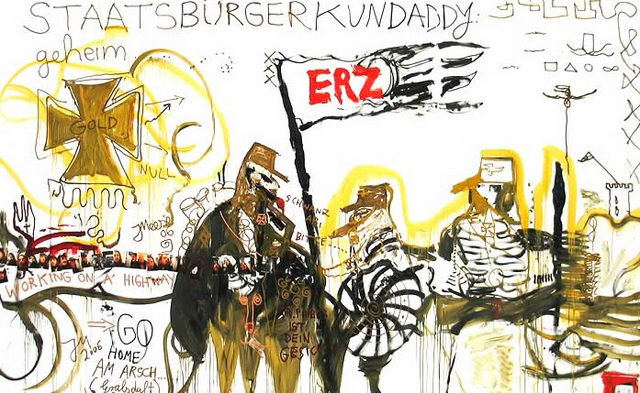

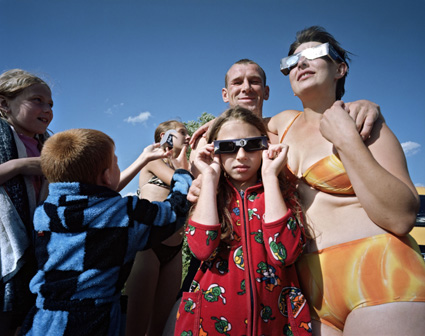
Group of Russians admiring the eclipse in the beach of Pervomaiskoje, Altai Krai, the locality where Tommi Taipale arrived on the eclipse day on his Journey to the Eclipse. Photo credit: Tommi Taipale
Last Summer, curatorial research group Capsula embarked on the first of its Curated Expeditions, demonstrating in the process that you don’t need an intergalactic spaceship to uncover new territories and make meaningful discoveries. This series of Curated Expeditions are research trips that engage with earthly phenomena through artistic investigation.
The 1st Expedition of Capsula invited 3 artists to observe a total solar eclipse which took place on August 1st over a vast area stretching from Canada, through to Russia, Mongolia and China. The observation location selected is the scientific Zoo in Novosibirsk, the capital of Siberia. Eclipse started in Novosibirsk at 17.45 pm.
The artists, German Agnes Meyer-Brandis, Catalan Mireia C. Saladrigues collaborated with the Zoo personnel and other experts to study the celestial phenomena and its impact on the animals and the visitors of the Zoo while Finnish photographer Tommi Taipale focused his work on the cultural and geographical distance between of Finland and Siberia.
Because Capsula’s latest focus is the relation between art and biology and environmental culture, the expeditions go hand in hand with a more leisurely and sometimes old-fashioned Philosophy of Voyage: walking, bob-sleighing, swimming, hitchhiking, rowing, sailing, trains and submarines. The travel from Finland to Novosibirsk took several days: While Tommi chose to hitch-hike, curator Ulla Taipale, Agnes Meyer-Brandis and Mireia C. Saladrigues spent three days to get there by train, taking the romantic-sounding Trans-Siberian Line.
With a background in Environmental Engineering and and Communications, Ulla Taipale is one of the founders and the current head of Capsula. I asked her to give us more details about this first curated expedition to Siberia:
Can you present us Capsula briefly? When and how it was born? What are its objectives?
 Capsula was founded by Mónica Bello Bugallo and Ulla Taipale in 2005 in Barcelona. It is a platform that creates cultural content and curatorial projects dealing with art, science and nature. The first project of Capsula was Days of Bioart in 2006. The event was a combination of a bioart seminar and SymbioticA Tissue Engineering and Art – workshop and organized in Centro de Arte Santa Mónica and in a laboratory of faculty of biology of Universidad de Barcelona. The cross-disciplinary approach has been characteristic of Capsula`s work from the beginning. In recent years Capsula has collaborated with cultural institutions such as CCCB (Centre for Contemporary Culture of Barcelona) and Intermediae in El Matadero of Madrid, DRU-Digital Reserch Unit of Huddersfield, among others, and have brought to these events many of the leading creators and researchers in the field of art, science and/or technology, such as Critical Art Ensemble, Tissue Culture & Art Project, Andy Gracie, Natalie Jeremijenko, Vandana Shiva, Jens Hauser, Ramon Guardans and Eugene Thacker, to name a few. The objective is to create interdisciplinary projects related with art&science, with a special attention on the natural and artificial environments.
Capsula was founded by Mónica Bello Bugallo and Ulla Taipale in 2005 in Barcelona. It is a platform that creates cultural content and curatorial projects dealing with art, science and nature. The first project of Capsula was Days of Bioart in 2006. The event was a combination of a bioart seminar and SymbioticA Tissue Engineering and Art – workshop and organized in Centro de Arte Santa Mónica and in a laboratory of faculty of biology of Universidad de Barcelona. The cross-disciplinary approach has been characteristic of Capsula`s work from the beginning. In recent years Capsula has collaborated with cultural institutions such as CCCB (Centre for Contemporary Culture of Barcelona) and Intermediae in El Matadero of Madrid, DRU-Digital Reserch Unit of Huddersfield, among others, and have brought to these events many of the leading creators and researchers in the field of art, science and/or technology, such as Critical Art Ensemble, Tissue Culture & Art Project, Andy Gracie, Natalie Jeremijenko, Vandana Shiva, Jens Hauser, Ramon Guardans and Eugene Thacker, to name a few. The objective is to create interdisciplinary projects related with art&science, with a special attention on the natural and artificial environments.
The last project of Capsula, called Curated Expeditions, was launched almost one year ago. The project is dedicated to observing and experiencing fascinating natural phenomena through the work of artists, scientists and other cultural agents. It also wants to revive leisurely traveling experiences, which have almost been cast aside by the frantic pace of modern day life. The first expedition was carried out last summer in Russia to explore and study the total solar eclipse and animal behaviour during this celestial phenomenon. This was realized through the proposals of German media artist Agnes Meyer-Brandis and Catalonian visual artist Mireia C. Saladrigues. On the other hand the expedition of Finnish photographer Tommi Taipale focused on the cultural and geographical distance between of Finland and Siberia during his journey to the eclipse by hitch-hiking. The project was done in collaboration with Novosibirsk Zoo in Siberia and with several other institutions, mentioned in the end of the interview.
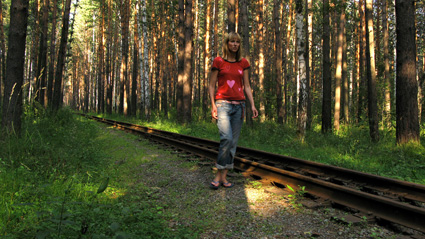
Ulla Taipale wandering in the vast forest by the Novosibirsk Zoo. Photo credit: Ulla Taipale
Curated Expeditions is a long-term project. Can you explain what are its long-term goals?
The object is to make a series of expeditions dealing with earthly phenomena in remote and nearby destinations . The aim is to stimulate production and exhibition of multidisciplinary artistic creation related with nature’s spectacles. I have many ideas for new expeditions and for the targets of the artistic survey, but these plans are in an early stage and not ready to be published yet.
Through these projects I want to give the protagonism to the natural phenomenon and promote positive emotions that can be experienced in natural and artificial environments. The question is: Could the natural phenomenon and the spectacles of the nature still fascinate a major quantity of people in the modern world, saturated by entertainment like video games and action movies? And, could these splendid and thrilling emotions lived within the nature, shift the attitude of people to more respectful and caring direction concerning their environment? Generally speaking, conservationism and environmentalism seem to be related with obligations and rejections that limit the level of life causing bad conscience. Sustainable way of life is related with low quality life – without luxury. I expect that the outcome of the expeditions – singular artworks, exhibitions, public debates and writings address towards to the enriching experiences reducing a distant and unconcerned attitude when thinking about nature and our relationship with it.
So, to name some of the more tangible goals – maybe in five years and after several expeditions a publication will be made out of these projects. And the new artworks created are to be exhibited in traditional and non-conventional spaces. I would also like to gather interesting people, not necessarily experts, but persons with good ideas to discuss publicly the issues indicated by the expeditions. The idea is to break categorizations and frontiers between different disciplines.
Curated Expeditions explored a phenomenon which lasted 2 minutes and 20 seconds. Yet you deliberately traveled using relatively slow and old-fashioned ways. You, Agnes, and Mireia took an almost 3 day train ride from Helsinki to Novosibirsk, while it took Tommi a whole week to get there by hitch-hiking. Why was it so important to undertake a long journey when (apparently) you didn’t have to?
Curated Expeditions wants to revive leisurely traveling experiences that personify the Capsula Philosophy of Voyage. Walking, bob-sleighing, swimming, hitchhiking, rowing, sailing, trains and submarines, just to name a few, are means of transport that permit your soul to arrive to the destiny simultaneously with your body. No matter if the destiny for the artistic exploration of the natural phenomenon is near or far, the participants should be aware of the distance and the differences- cultural and geographical ones – between of the departure and arrival.
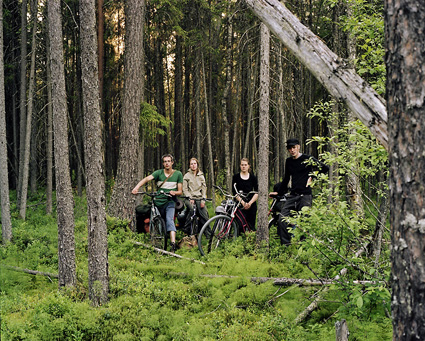
Tommi Taipale, Siiri Anttila, Selja Eskonen and Heikki Tuorila cycling in Russia. Photo credit: Tommi Taipale
We didn´t have to spend three days on the way and also it would have been less expensive and troublesome to take a direct flight to Novosibirsk. Many people warned us telling about uncomfortable and dangerous trains, we were asked several times why not to travel flying, that Russian people were noisy, in the summer the wagons would be hot and in general very inconvenient for three women with a lot of luggage. I have to admit, that I was questioning the decision many times. Also buying the tickets for exact days and routes was not easy at all because of Russian bureaucracy, holiday season and the mass movement of eclipse tourists. But, at the end we were in Helsinki railway-station with our huge luggage – Agnes was carrying 60 kilos on her – and the journey could start.
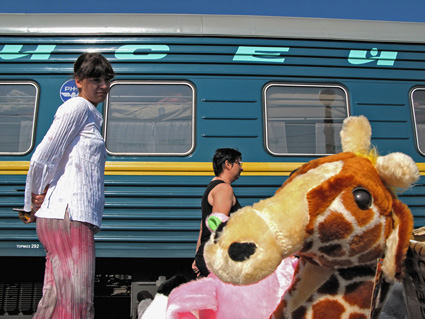
A break in a station on the Russian Trans-Siberian railway. Photo credit: Ulla Taipale
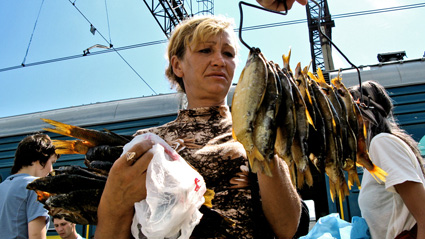
Russian train passanger selects fish, offered by “babuskas”, local grandmothers sell in railway-stations. Photo credit: Ulla Taipale
Once in the train, we did forget our doubts! During the three days between Helsinki and Novosibirsk we were able to learn some Russian, to know Russians, to know each other on a more personal level, converse, read books, watch the changing scenery from the window and while enabled and disconnected from the internet, got slowly into the mood of Capsula Expedition. And once we arrived, we were sad to leave our temporal itinerant home, the Russian co-travelers, the samovar and the rhythmic sound of the train.
Coming to Tommi, he spent two weeks on the road to get to Novosibirsk. As an experienced Russian traveler and wanderer, he could estimate roughly how long time it would take to get from place to another. During the first days he traveled with three friends using recycled bicycles and then alone towards to the tundra by hitch-hiking and using some river-boats. This extra round to the northern part of Russia was his attempt to escape the heat – the summer in Russia was hot, during July – August the daily temperatures rose up to 30ºC almost every day. However, even in Salehard it was sweaty!
Hitchhiking in Russia is a very common way to travel. To get a hitch is not difficult and a lonely Finn on the road wakens curiosity and hospitality in Russians – often he was offered also a place to sleep on the way.
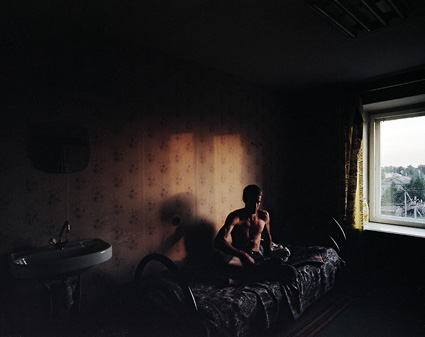
Tommi Taipale in a hotel room in Nikolsk, on his way to the total eclipse. Photo credit: Tommi Taipale
Tommi´s photographs reflect his meetings with ordinary people that can be found traveling alone leisurely in a strange territory. He has a basic Russian knowledge that allows him to connect with people who coincide with his fortuitous way that doesn’t respect timetables. His pictures open doors to the everyday life of Russians showing what often remains behind of the topics of the country, such as the life habits of the of class of new rich, the alcoholism and poverty, and the country’s military and energy power. In these glimpses shown in Tommi´s pictures a grandmother offers a lonely traveler sweet tomatoes or cranberries, a mine worker invites him to take a bath in a banja, Russian sauna or a group of silent men waiting for a river-boat in the dawn.
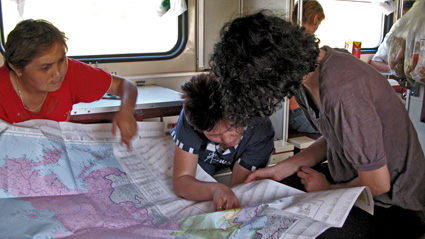
Mireia C. Saladrigues studies Russian map with Kirgisian co-travellers in the Trans-Siberian wagon. Photo credit: Ulla Taipale
By the way, is a journey on the Trans-Siberia as romantic as it sounds?
To our surprise it was big pleasure, nicer than we could ever imagine. You can do it more comfortably with a bigger budget in a higher class, having a daily shower and your own toilet, but then you might miss the contact with the co-travelers and a part of the taste of adventure. And the official Russian time, that shows Moscow hour where ever the train is in Russia, makes your daily rhythm disappear – instead of looking at your watch to start eating and sleeping, you let your state of mind or energy levels decide what to do. Our public relations and Russian language rehearsals always got more interesting and intensive the nearer we got to Novosibirsk. During the last hours in the train, Mireia found the first volunteer, a Russian girl to work with her in the project in Novosibirsk. Something very characteristic for Mireia´s work, which is based on her interpersonal skills and communication with people.
Anyway, I have to admit that we three adapt well to tough conditions. Traveling in Russian trains is good as long as you don’t except too comfortable a life and are not too prejudiced.
The zoo of Novosibirsk in Siberia seems to be a very intriguing place. How did you get to know about its existence? How did the owners and workers of the zoo welcome a bunch of artists keen on mingling with their animals?
When the decision to start the Curated Expeditions project by investigating a solar eclipse was taken, I started a closer study of the zone of totality, that was a vast area from Alaska, Siberia and Mongolia to China.
In 1999 I experienced my first solar eclipse in Hungary, in a small village of Rapabatona by the Danube, where I cycled from Vienna. I was astonished by the reaction of animals, mostly birds and insects, during the eclipse. So, when I found out that the biggest and oldest Zoological Park of Russia was situated in Novosibirsk, just in the middle of the eclipse zone, I decided to focus the project on the animal behaviour during the eclipse. The negotiations with the Zoo started and after weeks of correspondence and phone calls they agreed to collaborate.
We were made very welcomed. Sveta, the secretary of the Zoo, came to pick us up from the railway-station, and took us to our new home. We were invited to stay in an apartment situated in the Zoo area that is normally used by foreign zoologists and researchers visiting the Zoo. Novosibirsk Zoo Park is huge. The area consists of 53 hectares of pine forest and it is a home for around 12 000 animals and 634 species. Bengal tigers and snow leopards are among the 120 endangered species represented in the Zoo that can be found in the Red Book. Our neighbours and their numerous different ways of sonic communication filled the air with roaring, yelling and howling, especially in the dusk and dawn. Our communication with zoo workers was possible thanks to Sveta and Maria, Siberian English literature students, who were the links between us, the zoo workers and the journalists. English is rarely spoken in Russia, but the young people start to be stronger in languages than their parents who did their studies during the Soviet time.
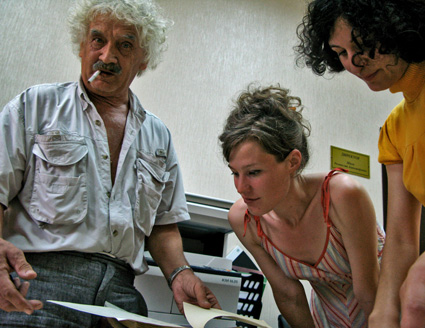
Agnes Meyer-Brandis and Mireia C. Saladrigues study notes from the year 1981´s annular eclipse animal behavior with the Zoo director Rostislaw Shilo.Photo credit: Ulla Taipale
We presented our intentions to the director Rostislaw Shilo, who runs the Zoo with 40 years of experience. Him and his wife, the scientific director Olga Shilo, are highly liked and respected personalities in Novosibirsk and people from taxi-drivers to biologists have positive things to say about them. In parallel with running the biggest Zoo in Russia and his scientific work, Rostislaw Shilo is also a Siberian eco politician, influencing environmental issues from the parliament of Siberia. Once we explained the goals of the expedition he didn’t hesitate in supporting the project. Not only did he offer us nice accommodation for nine days, but also helped us further in achieving rare moon geese for Agnes´ experiment and in gaining visibility in the Siberian media, among other things. We are very grateful for his and the all zoo personnel support, they were very generous and shared their knowledge with pleasure.
Russians are quite reserved and it is hard to know what the animal caretakers and other personnel really thought about our visit, but after breaking the ice they were more than cordial.
Some of the projects, in particular the one of Mireia C. Saladriques involved the participation of the public. How did it go? What happened?
Mireia´s project, called Zoolar Eclipse was fully realized within the installations of the zoo. Zoolar Eclipse investigated animal reactions when the darkness, caused by the total eclipse, suddenly fell into the Zoo. Not only the volunteer zoo visitors participated in her work, but she also got very connected with some of the animal caretakers despite the language barrier. During our stay in the Zoo she was following a daily program to observe and study through drawing the animals selected. The animals were selected following her own intuition and advice given by Dr. Sabater Pi, Catalonian ethologist and primatologist, and the director of the Zoo of Helsinki, Seppo Turunen. The final selection consisted of white-handed gibbon, eagle owl, liger, yellow-throated marten and polar bear. Liger, one of the main crowd-pullers of the Zoo, is a hybrid cross between of male African lion and a tigress. She also participated in animal´s feeding and daily routines with zoo personnel. Mireia woke up with the sun around five or six o´clock in the morning to realise her first walk by the animals with her pens and sketch book, then again between four and six o´clock (the eclipse hour) and the days were completed by the last round at sunset. Through these observations and interviews with the zoo personnel she wanted to learn the habitual behavior of the animals during the different positions of the sun.
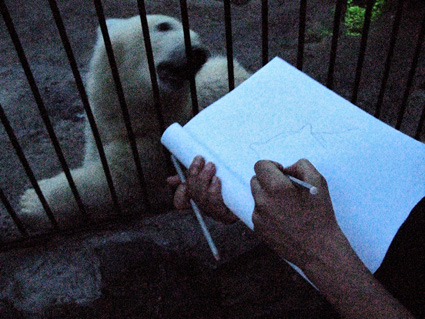
MIreia C. Saladrigues drawing a polar bear in a semi dark Zoo Park. Photo credit: Ulla Taipale
At first we were worried about not finding enough people to take part in the survey. These concerns disappeared once in Novosibirsk. On a normal summer day the Zoo counted more than 10 000 visitors. The news about this special opportunity spread also through the seven biggest TV-news of Siberia that interviewed us and the invitation to participate in the project circulated around through television, radio, city forum in internet and by Mireia´s posters in the Zoo.
On the actual eclipse day, Mireia and ten Russian volunteers delivered and recollected the Zoolar Eclipse postcards for and from one hundred zoo visitors, interested in writing their impressions of the effects of the sudden disappearance of the sun. She herself decided to observe the gibbons. In the moment of eclipse, she says, the role of the one that in the zoo normally is observed – the gibbon – changed and these primates were the ones that observed the humans, totally excited, yelling and shouting as apes in a state of climax.
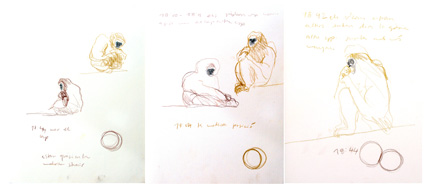
During the totalirity, Mireia C. Saladrigues chose the white-handed gibbons of Zoo as the object of her observation, due to their similarity with the humans. The drawings explain their activities during the eclipse. Image credit, Mireia C. Saladrigues
The texts by zoo visitors are now being translated from russian to finnish, english and to spanish and the contents seem to be quite touching and subjective. People have interpreted the behavior of animals in very different ways. The writings describe also strange physiological changes in the observers themselves, such as headache, dizziness, extreme feelings of happiness and even sudden hunger. The texts will be available on the website of Capsula Expeditions once they have been completed in english.
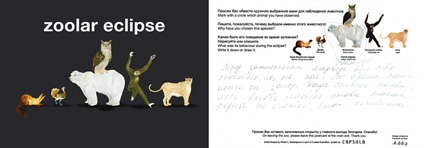
A postcard by Mireia C. Saladrigues and the written observations by a Novosibirsk Zoo visitor. Image credit, Mireia C. Saladrigues
While Mireia´s work took place in semi-artificial surroundings inhabited by wild animals, Agnes moved special Moon Geese to a natural setting to realise her bio-poetic investigation. The Moon Goose Experiment is based on a text by english bishop Francis Godwin and was published first in 1638 in the book called “The Man in the Moone”. The geese of Godwin`s novel fly to the Moon instead of heading to the South in autumn. Would that be something that could happen for some species of migrating birds soon, as an consequence of the search for more suitable habitats than a polluted planet Earth, facing the effects of climatic chaos?
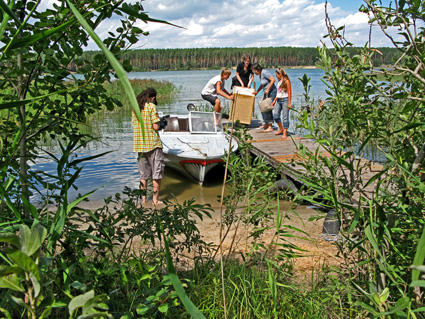
Arrival on the Sacred Scarabeus island, where the Moon Goose Experiment was carried out. Agnes Meyer-Brandis and Alexandra Deribas unload the moon flight equipment. Photo credit, Ulla Taipale
To find the required thirteen suitable Moon Geese and a runway for a moon flight in beautiful natural surroundings was an adventure, and only the determination of Agnes made this possible. Despite the fact that geese are protagonists of her work, also here the local people were playing a very important role in helping to carry out the plan. With the collaboration of Novosibirsk assistants we experienced unforgettable moments in a russian datsa, a typical small farmhouse with all kind of domestic animals, and on a sand island that was chosen to be the experiment scenery. This datsa was situated near to the Academgorodok, the Soviet époque’s ambitious science city project.
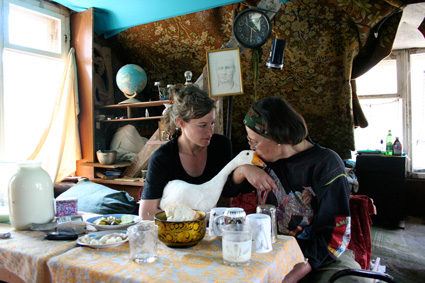
Agnes Meyer Brandis and Alexandra Deribas during geese training in Moon Goose Home, “Datsa” (little farm) of Alexandra and Gennardy Deribas near Akademgorodok, Novosibirsk. Photo credit Agnes Meyer Brandis
The actual Experiment was brought to fruition on that small sandy island “Sacred Scarabeus” in Ob River, an hours´ drive away from Novosibirsk centre. The Moon Goose Experiment crew arrived there early in the morning, on the 1st of August, to prepare the flight equipment and do all the necessary preparations. At 17.45 local time, we had the chance to witness a historical takeoff by Ljuba, a young Russian astronaut, and her moon flight in the darkness, provoked by the total solar eclipse. You can find a detailed report of the day on Agnes´web page.
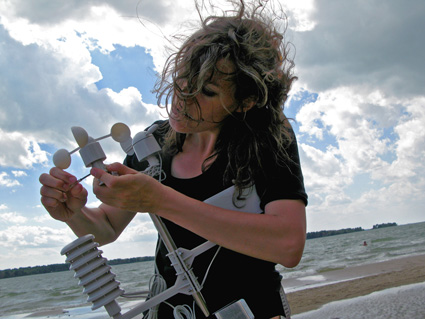
Agnes Meyer-Brandis is fixing pieces of the weather station in the Scarabeus island in SIberia. The sky was cloudy and and the wind was blowing almost 14 m/s just an hour before the total eclipse. Photo credit, Ulla Taipale
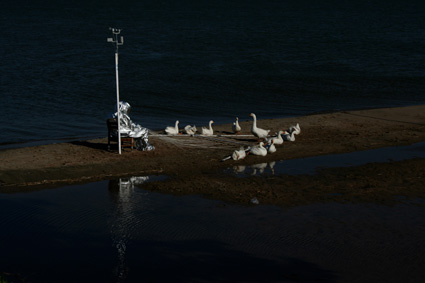
After the first touch, contact of moon and sun at 16.45, the geese stayed calm and Luba, the parachutist got ready for the Moon flight. Image: Agnes Meyer-Brandis
What can artists bring to the vision and experience of natural phenomenon which have already been widely studied by scientists?
A scientist follows his/hers paths of research and an artist his/hers, and both can achieve surprising findings in the same object of investigation. In the end, Curated Expeditions is not trying to gain results that would have scientific importance. The objective is to bring together artists and scientists to work at the intersection of different disciplines, but the results are art works and don’t have to contribute to scientific studies about natural phenomena. What I would like them to contribute is to the recognition of small and big miracles of nature and consciousness about its extraordinariness.
I like the way that Ian McKeever, the english artist, describes the work of scientific and artistic researcher in his text from “Ikijää – Permafrost” (edited by Marketta Seppälä and Yrjö Haila) :
At the moment all us “expeditioners” are “unzipping” the material gathered during the journey- photographs, drawings, videos, writings, and impressions that we lived during this cross-disciplinary expedition. Little by little the final artworks and the ways to present the fruits of the expedition are taking form, the reflections and ideas get processed in our minds. The three proposals were materialized and they are now in progress, the end is not determined.
Talking about visions, I would be very content, if, inspired by these and future proposals, the audience would let their imagination fly a bit further and travel along the migrating birds in the sky to new, surprising destinies, and, instead of purchasing a low cost flight to do shopping in a nearby European country someone would take his bicycle and see what adventures can be lived in the next village. These are some examples of different thinking that the artists could bring to our techno-scientific society where even natural phenomena is tried to be explained and reasoned.
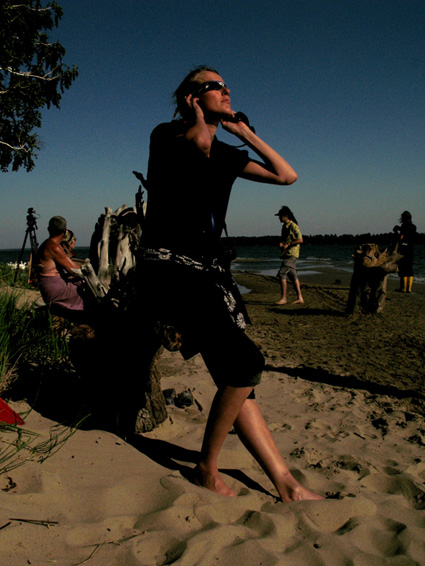
Ulla Taipale in Siberian Scarabeus island, in the strange light during the moment of totality, that lasted 2 minutes 20 seconds, at 17.45 pm. Image Capsula, author unknown
Now that you are back from these adventures, which conclusions do you draw from the experience? What did you learn from the first curated expedition?
It is extremely hard to work with a tiny budget in a country where you don´t know the language and have to depend on many volunteers help. But it is really rewarding when suddenly you discover a bunch of people who are willing and motivated to help you and share the vision that has inspired you to go so far. We can´t thank enough of all the people who helped us in Novosibirsk and during the year to prepare everything. The success of the project was depending on their collaboration. The next expeditions hopefully have bigger budget, but, at the same time I would love to be able to collaborate with local people where ever these projects will happen. Sometimes big resources cause certain distance to the place where you go, the production is taken care of by a professional crew and personal contacts with ordinary people of the locality are lacking. That can be extremely called “cultural colonialism”. I wish to continue Curated Expeditions with the possibility to experience these real meetings with local people.
Despite certain difficulties during the preparation phase of the projects, the artists have shown big talent, imagination and capacity of improvisation to get everything ready for the 1st August when the solar total eclipse happened.
What are Capsula’s upcoming projects?
The Moon Goose Experiment, Zoolar Eclipse and The Journey to the Eclipse will be shown for the first time in Helsinki, Finland, in March 2009, in the Museum of Contemporary Art Kiasma. The show is called “Expedition to the Total Eclipse” and organised as a part of Pixelache09 Festival activities that will consist of an exhibition, (from 6th March until 7th June, 2009), a seminar and some extra activities in the astronomical observatory of URSA. I am invited to stay as a resident in HIAP production residency during February and live in a fortress island Suomenlinna, close to Helsinki centre.
The second Curated Expedition, that will be related to the Baltic Sea, is being maturated at the moment and Capsula is also involved in activities that the Finnish Society of Bioart is organising in Kilpisjärvi Biological Station in Lapland during 2009. Their focus is in arctic biology, climatic and environmental changes and their artistic exploration. The news of Capsula will be published on the website and through the blog.
The next total solar eclipse will occur in India and China in 22nd July, 2009.
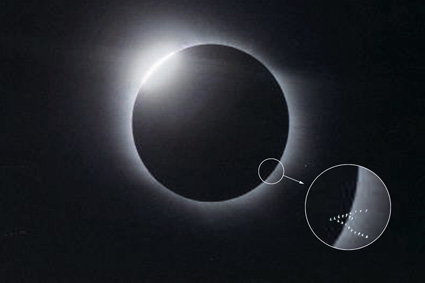
Rare Moon Geese are getting close to the Moon during the total eclipse. Image credit: Agnes Meyer-Brandis
Capsula´s Curated Expedition has received support from:
Zoo of Novosibirsk, FRAME Finnish Fund for Art Exchange, AECID (Agencia Española de Cooperación Internacional para el Desarrollo), VR (Finnish Railways), Venäjän ja Itä-Euroopan Instituutti (The Institute for Russia and Eastern Europe), Finnish Embassy in Moscow, Generalkonsulat der Bundesrepublik Deutschland in Nowosibirsk (General Consulate of the Federal Republic of Germany in Novosibirsk), A MINIMA magazine, Agrupación Astronómica de Sabadell (Spain), AirBerlin, Helsinki University – Kilpisjärvi Biological Station (Finland), University of Art & Design, Pori Department (Finland) , ARPI – professional photostore (Barcelona), NCCA Ekaterinburg (National Centre for Contemporanean Art, Russia), Colección Sabater Pi (Barcelona), Korkeasaari Zoo (Helsinki), SAS Royal Hotel (Helsinki), Sodexo Oy / Hostel Satakuntatalo (Helsinki), Antares Ltd (Barcelona), Fire Department Cologne, Tesimax (Germany), HMKV Dortmund
The exhibition “Expedition to the total eclipse” has received support from:
Pixelache09, Kiasma, HIAP (Helsinki International Artist-in-residence Programme), AVEK (The Promotion Centre for Audiovisual Culture in Finland), Taiteen Keskustoimikunta (Finnish Art Council)
Special thanks for Anneli Ojala from The Institute for Russia and Eastern Europe for translating the Zoolar Eclipse postcards in Finnish!
Thanks Ulla!
I’ve been covering a few editions of the Interactivos? workshops so far and have usually focused on a couple of my favourite projects. Today however, i thought i’d ask two of the workshop leaders/teachers to give us a broader overview of the workshops, how they evolve, why certain directions are being taken, what the mood is like over these two intense weeks of work, etc.
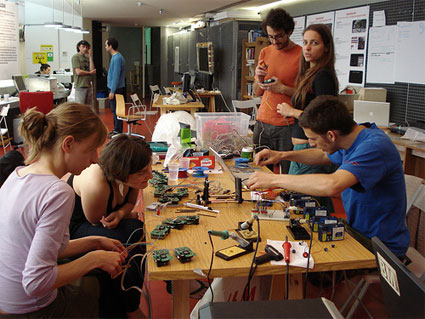
Image Medialab Prado
The teachers tend to change according to the theme of the workshop. This time i met Simone Jones and Alvaro Cassinelli.
Simone Jones is currently an Assistant Dean and Associate Professor of Art at the Ontario College of Art and Design, Toronto where she teaches in the Integrated Media Department. Her work includes kinetic sculpture, film, video and performance.
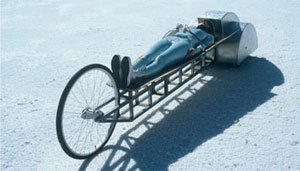 One of her recent works, Perfect Vehicle is a three wheeled vehicle that is approximately 11 feet long. The machine has sensors that monitor her breathing. Breathing (the rate of the rise and fall of her chest) controls the speed of the vehicle. This machine and the driving performance were filmed on the Bonneville Salt Flats (near Salt Lake City, Utah) in 2006. ‘The idea is to create a “science fiction” type of environment where the body is displayed tethered to a vehicle against the surreal backdrop of the Salt Flats;’ explained Simone. ‘This is the third machine that I have built that is made specifically for my body and is worn in a performance that is filmed.’
One of her recent works, Perfect Vehicle is a three wheeled vehicle that is approximately 11 feet long. The machine has sensors that monitor her breathing. Breathing (the rate of the rise and fall of her chest) controls the speed of the vehicle. This machine and the driving performance were filmed on the Bonneville Salt Flats (near Salt Lake City, Utah) in 2006. ‘The idea is to create a “science fiction” type of environment where the body is displayed tethered to a vehicle against the surreal backdrop of the Salt Flats;’ explained Simone. ‘This is the third machine that I have built that is made specifically for my body and is worn in a performance that is filmed.’
Alvaro Cassinelli is Assistant Professor at the University of Tokyo, where he is involved in the development of the Meta-Perception Group. Alvaro gained fame with the Khronos Projector and when i saw him at the Medialab Prado in Madrid, he was not only co-heading the workshop but also developing a new project for Sonarmatica in Barcelona. The theme of the exhibition this year, Future Past Cinema, attempted to create links between the past and the future of Cinema under a single vision. boxedEgo embodied perfectly that concept by the way the installation combine several pre-cinematographic techniques in order to create a new magical, “out-of-body” experience (stereoscope, diorama, peep-show box and pepper ghost effect).
Video:
Here we go now:
The Interactivos?’08: Vision Play workshop took place from May 30 to June
14. That is just 2 weeks and i found the projects quite ambitious. Such a
short period of work has its advantages and downsides. But how do you cope
with the stress of having everything ready and working in just 15 days? What
are the trick to get the work done in such a limited period of time?
Simone Jones:
I believe that one of the reasons that the projects get developed successfully in such a short amount of time is because Interactivos attracts such a talented and diverse group of collaborators. Everyone is aware of the two week deadline and this seems to push people to donate their time in a concentrated way – the stakes are high and the time is short so people cluster together in intense working groups to get the job done. We also relax together at the end of each work day – this gives us the time to get to know one another and build strong relationships (share ideas; brainstorm solutions to problems). Another aspect that contributes to the success of the workshop is the lack of ego among the participants. Because the teachers are flexible with what they “deliver” to the students (the teachers really “respond” to the needs of the group) there is no real agenda. This helps people feel that there is no “hierarchy” of knowledge. All of us are respected as individuals whose strengths emerge from participating in a diverse group. Of course, it is no secret that the work gets done because people work really, really hard too!
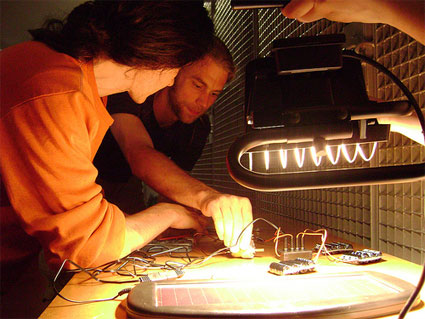
Image Medialab Prado
Alvaro Cassinelli:
I think the “trick” may be three-fold: first, the selection process was quite serious: a lot of effort was put into selecting projects that were enough original and at the same time somehow overlapping, so the skills and resources could be shared. That worked pretty well.
Then, I’d like to stress the fundamental role of the contributors. This is a great formula. Everybody is motivated from the start (artists want of course their projects to succeed, and contributors come to the Medialab willing to learn, but also with a very generous, selfless attitude. With a little bit of luck the teams work quite autonomously. Now, of course, now and then there were some problems: one has to consider for instance that many contributors are also artists in real life, and that the leading role of the “artist” during the workshop may be a little artificial; Plus, individual approaches and interests may conflict: some contributors may push the technical side (because they want to try and improve their skills), while others may rather enjoy doing the concept/artistic critique.
Interesting as those approaches may be, the problem is that there is a very limited time for developing the project, so it is important that somehow the roles stabilize at a certain point, and people choose very concrete responsibilities. To ensure that this would happens, this is perhaps the role that was given to Simone and me, but I have to say that we were quite lucky because most teams worked very efficiently from the start. That being said, Simone and me put a lot of accent on the “critique sessions” (at least one serious meeting with the artists and collaborators for each project), which not only helped clarify the ideas but sometimes threw a completely new light on the project.
The third reason I can think of that may explain the “trick” is of course the Medialab people! there were there for us all the time, always available and with a very positive attitude.
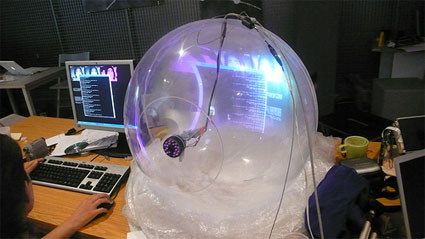
Expanded Eye, work in progress
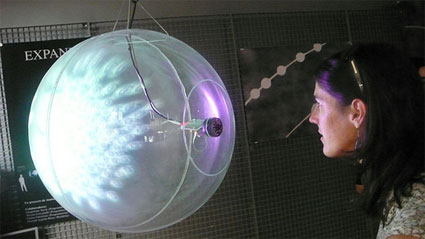
Expanded Eye, by AnaÃsa Franco
How do you work as a teaching team? Do you divide projects between Simone, Alvaro, Julian and the rest of the Medialab team? Or are your skill so complementary that everyone has to be everywhere?
Simone:
I found that we had similar yet diverse skill sets so that we could separate from one another and work on projects that needed our individual skills. This worked really well and allowed participants the freedom to move between the teachers when they needed something specific (technically speaking). We all contributed to the conceptual development of the projects (this is a great time for the teachers to work together in the critiques without having to focus on the technical problems of the work). I assisted participants with electronic and mechanical problems; Alvaro was great with his knowledge of physics, vision and programming; Julian helped a lot with augmented reality and 3D software. We didn’t formally work this out beforehand – we simply responded to the individual projects as they were being developed.
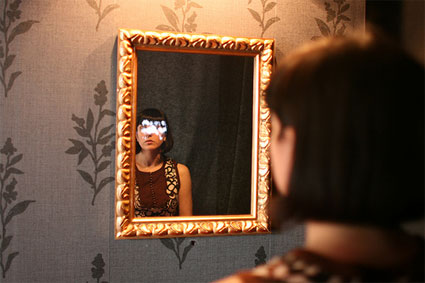
M.A.S.K. (My Alter Self Konciousness), by Jordi Puig
Alvaro:
No, we didn’t divide the projects between the teachers, although of course we naturally got more involved in some projects and less in others. But we tried to constantly monitor the advancement of each project. That was not coordinated at all. Instead, we would discuss from time to time about the problems that were arising and think about how to solve them (directly, or by trying to recruit for a moment a contributor from another project). As for me, that meant that my contribution was “interrupt-driven”, which was extremely tiring but exciting at the same time.
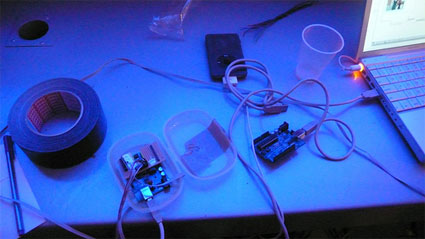
Why this focus on “Vision play” when, as Alvaro puts it “The “magic of the cinema” no longer amazes us because we have become totally accustomed to it.” What are the paths which should still be explored? Beyond higher resolution? Flatter screen? or more realistic 3D experience?
Simone:
This is an interesting question. I think “Vision Play” refers to perception, which is a huge topic that an artist can explore from a variety of positions and with a variety of media. A friend of mine says that “there are always more ways to see” – I love this idea because it points to the complexity of perception and I think this is even more relevant today because of the ways that technology challenges and mediates our experience of the world. Presence (live and virtual) is completely related to perception. We navigate between live and virtual experiences without thinking about it; “vision play” challenges artists to create artworks that engage with this “shifting ground” that characterizes our perceptual connection to the world.
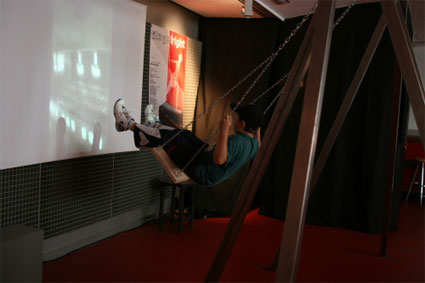
Stage Fright, by Nova Jiang
Alvaro:
Ah! that question again 😉 In fact, I loved the theme from the start, precisely because it was an opportunity to depart from the mainstream computer graphics technology and aesthetics. An opportunity to play with light, mirrors, motion and reflections in search of “illusions” – as we all did when little, when one’s fascination could easily be caught by the patterns of light at the bottom of a cup of tea (a “catacaustic”: a fascinating name too!). There were some projects like that, and although I secretly wished there were more of this kind (and less projects involving computers and displays – as my own by the way!), what we got was really interesting and original in its own way.
In any case, “vision play” was clearly not imagined as a workshop to develop “flatter screens” or “more realistic 3D experiences”; among the project proposals (totaling 98!), there were some that pointed in that direction and I think we consensually rejected them easily on the basis that this workshop was for exploring unknown territories, not an R&D laboratory…
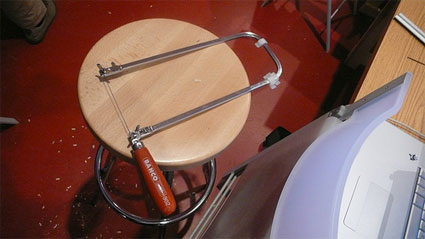
I find the dynamics, open-ness and spirit of the Interactivos? workshops very unique. What is your opinion about it?
Simone:
I agree completely. The environment at Interactivos is like no other experience that I have had. All “residency programs” are intense but Interactivos is different because you participate as a contributer to the group and the overall spirit of the projects rather than as simply an individual artist. Also, the people at the MediaLab are AMAZING! They really set the stage for the spirit of the workshops (and Madrid is a magical city!).
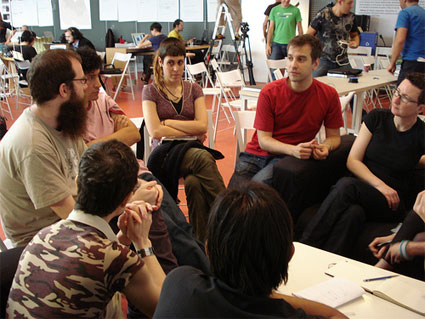
Image Medialab Prado
Alvaro:
Well, for me it was very unique of course!!. A fantastic experience. And I was very lucky to share this teaching experience with Simone, with which we had a very good communication (I hope she shares this opinion with me too! 😉 I just think the workshop should be a little longer – but this may be a feeling we all shared at the end, and that
we all would have shared even if the workshop was made a little longer. Most of us just wanted more of the same. Anyway, I think this is how it works, this is the very essence of the workshop: a fleeting moment that reunites capable and imaginative people for a few days in order to try some magic formulas – the actual magic will crystallize in the future. (Another remark: I think the Medialab need to have the mechanical workshop – now in Matadero – in the the same building as the electronic/computer workshop, this may increase the efficiency of the work being done. It seems that this will happen very soon, when the new space will open.)
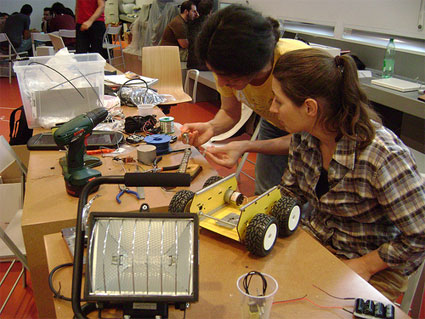
Esther Polak and Pablo Ripollés
The participants of the workshop are asked to use open hardware and open code tools. Apart from the lower cost factor, what makes these open tools really worth working with? Are they already as sophisticated, efficient and reliable as other tools?
Simone:
I find that Open Source software and hardware allows for a completely different approach to learning (specifically learning within a technological framework). For example, when I first began learning electronics (in 1989), the information that I was taught was cumulative and came from a localized environment (within a school). This environment was specific to Toronto and grew slightly once I had graduated and met more people within my local artist community. As I got older and became more experienced and had more exhibitions, my community grew but this was completely contingent on my ability to “physically network”. Today people can access vast amounts of information via the internet. Online communities have extended and sometimes surpassed local communities in ways that I could never have imagined in 1989. I buy and download information from the web instead of going to “specialized” bookstores. Open Source communities post code online. “How to” books proliferate. I have observed people adapting code and hardware solutions to their own projects. Learning is more of a “cut and paste” experience than a cumulative one. This is extremely interesting and challenging for educators who design curriculum with specific “learning outcomes” that are derived from a cumulative process of knowledge acquisition. Knowledge is shared at Interactivos in the same way that knowledge is shared and acquired from the internet and open source communities – an individual has a specific problem that needs to be solved – the approach to solving the problem is directed outwards to a “community” that responds to the question at hand. I think this is a wonderful way to learn – a person is able to build a “toolkit” of knowledge. However, I also think it is still important for people to be able to contextualize what they have learned. This often occurs slowly and cumulatively. Time is a key factor in the overall learning process.
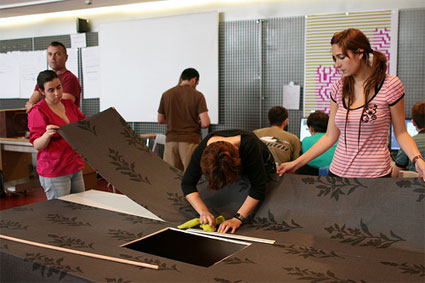
Image Medialab Prado
Alvaro:
This is a very general question, I mean this attitude towards open source tools is not particular to the Medialab-Prado workshop. I do use such tools even at my work at the University. There is some controversy here of course, but as for me, I like to use such open tools in particular because I can be sure there is a community using them, a community that is precisely open to any newcomer (just click here, download, and find some fanatic in your immediate surroundings wishing to “convert” you and explain the mysteries of the hardware/software to you – and all that for free!). As for how efficient and reliable these tools are: this depends, but in the field we are now discussing – I mean, interactive media arts, right? – I think these tools definitely have their place. In the worst case, at least for prototyping. I am thinking in particular about Processing, but if you think about openFrameworks, it potentially enables the fastest processing a particular computer can give you (but the initiative is yet not nearly as developed as Processing is).
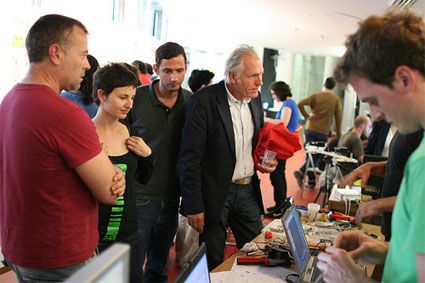
Theo Jansen visiting Medialab Prado
Thanks Simone and Alvaro!
Heidi Kumao‘s art pieces explore ordinary social interactions in order to reveal what lies beneath them: psychological states, emotions, compulsions, thinking patterns, and dreams. She is currently teaching animation, video, experimental television production, and electronic and conceptual art at the School of Art and Design at the University of Michigan, Ann Arbor. For 2007-08, she has been awarded a Postdoctoral Research Fellowship from the American Association of University Women Educational Foundation.
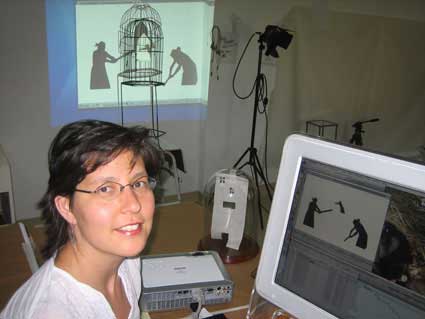
A few years ago i discovered her set of female kinetic sculptures “Misbehaving: Media Machines Act Out,” and classified her work under robotics and kinetics. Then i stumbled upon the performative techno-enhanced series of clothing she had developed and here i was trying to fit her work inside the “wearable” category. A closer look on her portfolio revealed household objects sabotaged to become cinema machines, overtly activist projects and the geekiest wedding cake i had ever seen. The experience taught me that any attempt to classify of her work would be pure folly unless i’d try to trick her into giving me a helping hand:
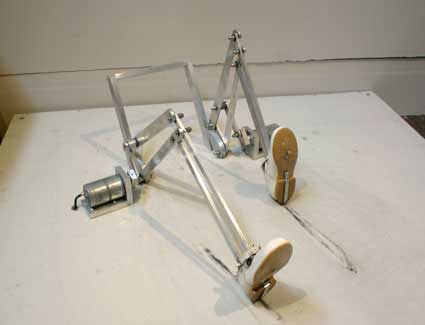
Resist, 2002
You first graduated in photography at the School of the Art Institute of Chicago. How did you come to work with kinetic installations, RFID activist projects and quirky wedding cakes? What made you broaden the scope of your artistic practice?
This is a big question, so I’ll answer it in sections as a way to answer the larger issue of shifts in artistic practice. How I get from here to there to there to there…
Re: transition from photography to sculpture
The Art Institute had a very interdisciplinary photo department at the time and we were really encouraged to “go outside the box” of photography, to mix photography with other media, to be artists who USE photography rather than pure photographers. In the 80’s and 90’s, photography was exploding in 100 different directions and open to a variety of approaches. Everything was possible. Everything could be photographic in some way.
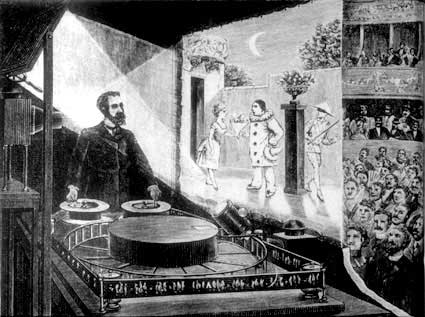
When I entered graduate school as a photographer I was already starting to work with sequential imagery. I was driven by a need to animate physical gestures and behaviors as indicators of psychological states. Simultaneously, I was collecting domestic objects and record players and researching pre-cinema devices and the 19th century creation of spectacle, Emile Reynaud‘s praxinoscope from the 1880’s, in particular. My first kinetic works were homemade-looking zoetropes that projected a sequential loop of 12 images: a child being spoon-fed, a woman’s legs curtseying, a woman frantically sweeping. Like a memory that can’t be repressed, each animated sequence repeated endlessly and mechanically. In this way, each object seemed to be speaking with its images, a visual and mechanical voice replacing text. Much like the girls’ legs I made much later, they were an artificial life form, a stand-in for a real person that I could construct and bring life to. These “cinema machines” (as I called them) allowed me to combine all of my interests (photography, performance, sculptural assemblage and the psychology of everyday life), into one art form. I loved working this way and continued to create cinema machines for several years.
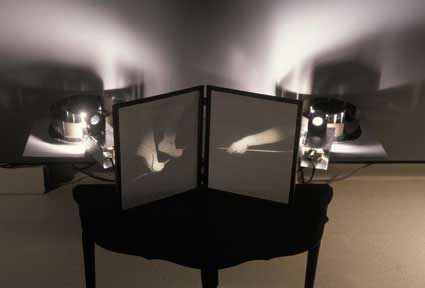
Defense Mechanism
RE: Installation
While much of my work could be categorized as “kinetic installation,” a more accurate descriptor might be “animated tableau.” I tend to think of myself as a theater director, staging events for the viewer. A lot of my art practice is about creating a situation for something to unfold over time. This grew organically out of my experience staging photographs. It seems to be a mode of art making to which I am intuitively drawn.
Each tableau intentionally uses recognizable objects that suggest a possible scenario from everyday life. As I craft each piece, I am very conscious of the psychological experience that is created for the viewer. Can the space of each tableau imply both a physical site and a psychological state? How can I make the viewer re-examine seemingly ordinary events such as childhood play, family dynamics, television news or even the wearing of clothes?
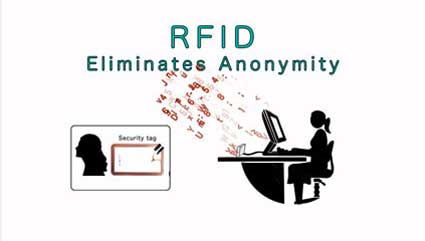
Still from Zapped! video
RE: RFID Activist projects
I worked on Zapped! a multi-part project about the mass implementation of RFID technology with Preemptive Media in 2005. I met the members of Preemptive Media (Beatriz da Costa , Jamie Schulte, and Brooke Singer at Carnegie Mellon University in Pittsburgh, PA where I was a Microsoft Artist-in-Residence Fellowship for 1999-2000. Besides being a great school for robotics, computing, AI, engineering and art, Pittsburgh happened to be an amazing hub for art collectives, tactical media practitioners, and technological art at that time. I was surrounded by tons of brilliant people including folks from Critical Art Ensemble, Institute for Applied Autonomy, and Subrosa, to name a few. Just being in this environment made me rethink my artistic process completely, and motivated me to learn how to incorporate electronics, microprocessors, computing, and digital imagery into my work.
Before we ever did Zapped! a few of us had collaborated on a project (Nomadika) about data-veillance and wireless technologies for the 2001 Sculpture Conference in Pittsburgh. We educated and informed the public about the future of data mining by opening a storefront for our fake marketing firm. Researching data mining and privacy loss in our contemporary era later led Preemptive Media to the project on RFID, which seemed to be (at the time) yet another way in which corporations and the government would invade citizens’ privacy. As someone who creates and teaches animation and video, my primary role in the collaboration was to make the educational video from all of the research and information we had unearthed as a result of this project.
After working solo for so long, I relished the opportunity to collaborate with others on a project.
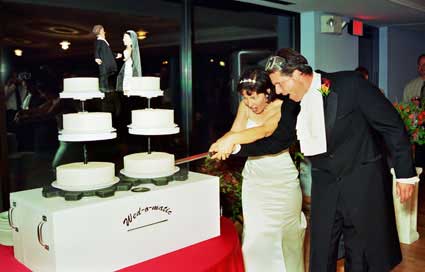
RE: quirky wedding cakes
The 6,000 volt wedding cake was a collaborative project with my husband, Michael Flynn, a high school physics teacher and science exhibit designer. As two mechanically minded people, we decided that our cake had to reflect our interests in machines and the project grew from there. It started with the idea to have two cakes cut to look like interlocking gears and progressed to two motorized cakes on gear-run platforms. Michael made two dolls that represented us in our wedding costumes. These dolls were going to stand on the top of each cake and would basically pass one another every time the cakes turned. Eventually, I thought we needed to incorporate an electric “spark” between the dolls, like the “spark” between us (cheesy, I know). This led to the idea of using a Jacob’s Ladder to generate a much larger spark. Michael purchased a neon sign transformer and wired the cakes and dolls with opposing charges. When powered on, the cakes turn, and once a turn, the dolls hands meet and a large flaming spark erupts from their meeting hands. It’s pretty funny. And like other collaborative projects I’ve done, it was loads of fun!. Our “how to” article appeared in Make Magazine.
What made you broaden the scope of your artistic practice?
When I look over the various transitions I have made with respect to media
(from photo to cinema machines to kinetic sculptures to animation to collaborative technological projects), I can map those changes onto personal and cultural moments of change. For many years, I made a life as an artistic nomad. I relocated every year or two for jobs, fellowships or other opportunities. This experience of having to re-contextualize and refocus myself in so many different places shaped my art practice in a deep way. Each time I moved, the new school, city or community raised new issues to consider. For example, (like I said earlier) as a research fellow at Carnegie Mellon, I was exposed to art practices that critically engaged technology rather than simply used technology. I had access to people, tools, and resources such as machine shops for the creation of custom parts, computer programmers, robotics labs, video editing equipment, etc. As a result of being at Carnegie Mellon, my work shifted away from more personal themes towards more political issues and cultural critique.
While I had been using technology for many years, my time at CMU caused me to rethink how I used it and why.
Exposure to such a large computing environment had other long-term effects on my art that didn’t show up until much later. Researchers in AI, computing, robotics and gaming exposed me to the possibilities of generative artwork, which was a complete paradigm shift from creating “fine art” objects for the art world. I was excited to think about making a dynamic system or a tool as an artwork rather than a fixed object. However, it took me awhile to decide on a project that would best be served by this approach.
Later, when I moved to Ann Arbor, Michigan, 9-11 and the proliferation of cable news caused me to analyze the visual and conceptual construction of the news broadcast more critically. CNNplusplus, an interactive and dynamic news broadcast, was born a few years later (in collaboration with Chip Jansen.
Video:
The short answer to your question is simply new places, new people and A.D.D. or the tendency to get bored easily…
You seem to navigate effortlessly from one discipline to another but are there particular issues or elements that you keep returning to?
Yes! I find that I return to an exploration of ordinary social interactions and their psychological undercurrents, institutional critique (mainstream media, traditional gender roles, others), and performance (creating theatrical spectacle, behaving/acting social roles, performing for a camera). I view performance as an integral part of everyday experience and define it very broadly: as a means to define our identity and sexuality, as an examination of roles we play as employees or family members, and as a tool for self-expression. Every piece has its origins in everyday life: an argument, a memory of childhood, the frustrations of watching television, the act of being a consumer–
My art making process is grounded in these types of experiences.
Combining these three things together has produced two main types of work that are pretty different (at least to me):
1) Work that emphasizes a visceral experience and tells a more personal story: the “cinema machines,” the girls’ legs, stop-motion animations, and my latest shadow theater pieces
and
2) interactive projects that are more overtly political and use technology to critique technology: CNNplusplus, Zapped!, Wired Wear
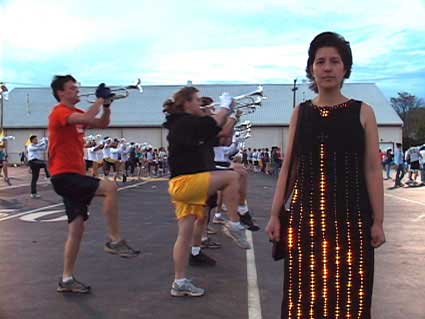
Monitor II: Audio-activated Dress, 2005
I find I am drawn to the more personal works because they provide an outlet for me to imply/suggest a critique of institutions of power without being so literal. Almost every piece starts with a personal story of some kind and the creation of a tableau is an opportunity to create a visual poem of images and objects together. By exposing the physical apparatus that drives the bodies into action, I draw a parallel between this machinery and the mechanisms of our unconscious: defense mechanisms, sex drives, thinking patterns, self control, dreams, impulses, instincts.
With the public/interactive projects, the emphasis is more educational and/or ironic. Working collaboratively removes the personal emphasis and creates opportunities to address larger cultural issues and their effects on the general public.
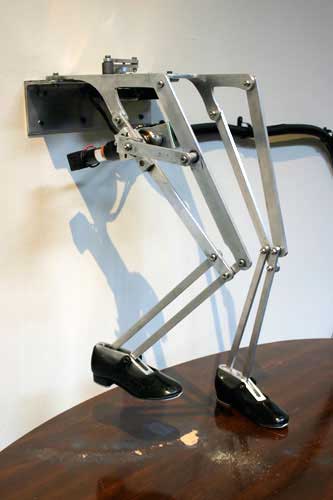 Misbehaving is a series of three female “performers” for intimate installations. What is the performative part of the work?
Misbehaving is a series of three female “performers” for intimate installations. What is the performative part of the work?
Misbehaving consists of three pairs of aluminum, mechanized legs fitted with girl’s shoes: Protest, Resist and Translator. The legs in Protest stomp loudly and unpredictably while standing on a coffee table. In Resist, a pair of girl’s legs squirms on the floor in a way that is both sexualized and challenging in response to viewers’ speech. The girl in Translator is trapped on a track between two “adult” chairs with video projectors for heads. As viewers hand crank her from one side to the other, she becomes like a child caught between two feuding parents, or a political mediator, whose body/screen reveals/exposes the real text of the conversation through non-verbal gestures.
With these pieces, I was thinking about the performance of gender, especially for little girls. We learn what is appropriate behavior so early that it becomes naturalized, we don’t realize that we perform it. In developing these pieces, I wanted to intentionally create girls that perform “badly”, act out, misbehave, or act against type. As machines and girls, these works operate in stark contrast to a culture obsessed with “increasing job performance,” high performance cars, and athletic performance. Their acts of defiance are small, yet powerful, signs of agency.
Videos:
The kinetic girls legs have also some feminist (may i use that word?) undertones. Why is it still important to propose a view on feminism today?
YES, you may (and SHOULD) use the word “feminist.” I consider myself a feminist and I think the stigma around the word (created by conservative males) has (unfortunately) had its prescribed effect of preventing people from self-identifying as feminists.
Those legs were born out of my experience at Carnegie Mellon where I was surrounded by really macho robots: machines that can fight fires or repair a nuclear reactor, robots for combat, robots for Mars, etc. At the same time, television programs were priming the mainstream public for what I call “performative robotics,” including BattleBots and Robo-wars, as vehicles for violent entertainment. With technological art and computing still so male dominated, and the research funding driven by the Defense Department, I do think it’s important to remind ourselves that robotics has a range of applications that are social, psychological, poetic, beautiful, and quirky. Are those feminist, or just alternatives to the mainstream?
I think it’s important to maintain a vigilant feminist critique of the world in the same way that it’s important to be vigilant about racism and economic justice.
A couple of years ago you developed Zapped! together with the other members of Preemptive Media. The work examines the mass deployment of Radio Frequency Identification (RFID) and its effects on our everyday activities. At the time the website of the project said that “RFID is not yet a household name or a pervasive technology, but Preemptive Media predicts that everyday encounters with this technology (whether known or not) will soon be commonplace.” How much has changed ever since? How much is the public aware of the possible downsides of RFID technology?
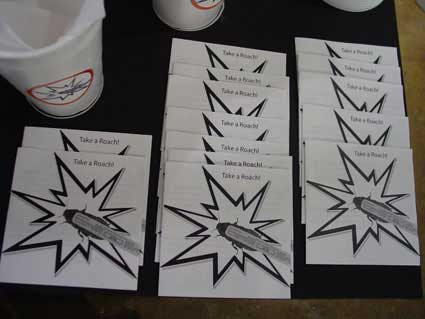
In October 2006, the US started issuing passports with RFID chips that include a digital photo and all other information currently printed in passports. These passive tags in passports are only a small beginning of all-around use as they can be embedded into nearly everything you buy, wear, read, or drive. At the time we did the piece, there was a common fear of surveillance–that by carrying items with tags, you could be tracked, your personal data could be compromised, etc. The reality is that the tags need to be scanned at such a close proximity (a few millimeters) that it’s difficult for someone to scan your item without your knowledge. Plus, if all the tag has is a reference number (for another database) rather than concrete data, there isn’t much to gain by secretly scanning…In general, as with so many of these new technologies (GPS, for example), people choose convenience over privacy. In our current climate, you can’t have both. We all love the convenience of having a cell phone, even though they all have GPS chips. You don’t hear people complaining about the possibility of being located through triangulation of their cell phone chip. At least not yet. I think that data privacy is the new “civil rights” issue of our time–at least in the US where there aren’t many data privacy laws.

I’ve always been fascinated by the story of the roach release. I saw a brief mention of it a newspaper one day. Can you explain us what it was about and in which context it took place? But also, how did the public react to the idea?
The roach release was but one part of the Zapped! project. The multi-part project included the educational video, a school kit for “arming” yourself against RFID surveillance, the roach release station, and educational workshops. Each of these reached a different segment of the population with the goal of not only informing the public about the technology, but also providing them with means with which they might take action against it.
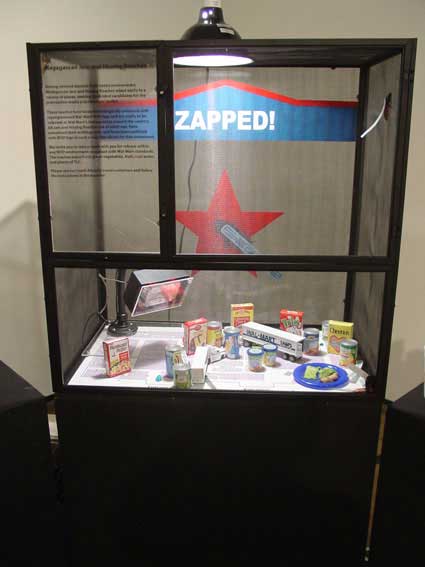
At the time, WalMart was setting the standards for RFID implementation by requiring its top manufacturers to embed tags into the cases and pallets of merchandise. As the largest retailer in the world, its protocol affects the business practice of nearly everyone in merchandising. WalMart pushed for this change touting its increased inventory efficiency. At this point, we speculated that if a WalMart had RFID readers and a corresponding database, they would all be located in the loading dock/storage area of the store. We discussed different ways to use or subvert the signal of the WalMart RFID reader- for passive tags, it sends a small signal in order to read the information on the tag and puts that information into a database. As we went round and round with ideas for tricking/toying with this Goliath, the idea boiled down to creating a small interruption in/jamming the WalMart RFID database. If WE couldn’t gain access to the loading dock and the readers, perhaps we could send a robot, or, as Beatriz da Costa suggested, a rodent or insect in our place. The final solution was to send a cockroach (with an preprogrammed RFID tag glued to its back) into the store’s loading dock area. The RFID tag was programmed with a small text message of resistance–and would definitely cause a “hiccup” in a database that was accustomed to standardized product information. In the video, we gave instructions on how to do a “roach release,” and in Houston (at Diverseworks), we gave away all the Zapped! roaches. I am not at liberties to say anything about the actual release. The public loved the idea and the roach became the project’s mascot.
Video:
Any other Wal-Mart action?
Not with that piece.
What was the impetus for the audio-activated DRESS? How do you exhibit it (or any of your other wearable pieces for that matter)? As part of a performance? As a static piece in a gallery? As a garment you can lend to gallery-goers?
The wearables started as an idea for a fun Halloween costume. I was initially inspired by the humor that could result from providing visual feedback, especially on a woman’s body. The lights on the dress light up incrementally, starting at the bottom when the sound is softer, and lighting up the entire column when it becomes very loud. When I wear the dress, I become a walking audio-meter which is really an absurd (and poetic?) image. These pieces are custom made to fit my body, and I use them in humorous video performances. The project is less about the objects and more about what I can do with them. So far, I have exhibited them as objects on mannequins with a video that shows them in use. In the end, the final product is really the short videos. There are many more places I can take them…
You seem to be attracted by the idea of “intimacy”. Which one of your works expresses the idea better and why?
As an artist, I use machines, projected imagery, and animation because they offer me a visually compelling way to investigate what is unseen: psychological states, emotions, compulsions, neuroses, desires, dreams. I find that I naturally gravitate towards work that examines everyday behavior and personal issues. I’ve called my work “intimate installation” because of its scale (human sized objects), its content (domestic and interpersonal issues) and its viewer experience (dark or dimly-lit rooms). With a minimum of objects, each tableau recreates a private ritual or occurrence for the viewer. I use the word “intimate” to describe the spaces I create and to draw a distinction between my domestic theaters and other large-scale environments.
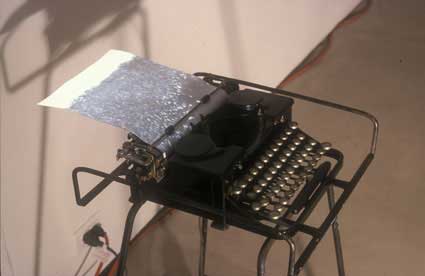
“Letter Never Sent” is a good example of this. In this piece, video footage captured under a dissection microscope is projected onto the space of the typewriter page. Sounds of a woman weeping, a doorbell ringing, and someone knocking on the door are juxtaposed with black ink creeping up the page and fading, and turbulent, dirty water which seems to spit out from the base of the typewriter. With this piece, I was trying to describe one woman’s difficult experience of writing a letter that is erased or never sent because it is too harsh, too truthful. Rather than use words, I used fluids, like emotions, to wash over the page like a wave. The page is filled and emptied again and again, similar to how one might write and edit oneself in pursuit of the perfect correspondence. Even though the work explores one person’s intimate experience, I think we can all relate to written communication, self-censorship and the strong emotions that result.
Yet another video:
You are also teaching at the University of Michigan School of Art and Design. What are your courses about? Can you give us a few examples of your students’ projects?
At this University, I am mostly teaching animation, video and various conceptual classes (this fall, an introductory class on TIME!). The most enjoyable courses focus on creating material for “experimental television broadcasts,” and rethinking the space of the television as an art gallery for time-based work. I know it seems like an old idea since video art first emerged as an alternative to mainstream television, but here at the University of Michigan, we have a unique collaboration with our local PBS station, WFUM. PLAY is a “collaborative project from the University of Michigan School of Art & Design and Michigan Public Media, transforming the gallery space for time-based media.” This project features time-based work (video, animation, documentary, performance, other experimental forms) by faculty and students in the School of Art and Design. Selected pieces air on television as interstitials-in between programs at the top of the hour, say between “The NewsHour with Jim Lehrer” and “Antique Roadshow,” while all submissions are viewable on the web. In my class, “Animation for Broadcast,” students get real-world experience producing fun promotional pieces as well as content (under 3 min.) for this gallery space we call a television. You can see some of their promo animations here. They were encouraged to think about the concept behind PLAY Gallery (an online, virtual place for art, television as gallery space) and play (the activity). They were given the PLAY logo and could do just about anything with it.
I think it’s a really great moment in history to reconsider what television and broadcast can be, do, say: with the YouTube-ization of the world, everyone’s a performer, everyone’s a filmmaker. How does that impact what we make and produce?
Any upcoming project you could tell us about?
I’m working on some totally new and different works. “Timed Release” is a series of performative portraits focusing on people who have developed a creative mental space to survive physical confinement. Paper cutouts and small kinetic sculptures contained in bell jars or other containers are brought to life through video projection to create illusionary shadow theater. It’s an engaging hybrid of image and object…
Thanks Heidi!
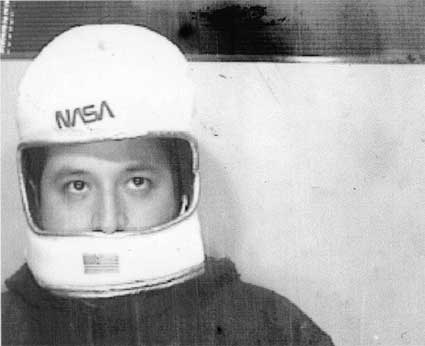
I’ve discovered Fernando Orellana in 2004, the year i realized that there were artists playing with technology out there. All along my tumultuous and whimsical 4-year relationship with new media art, artists have been appearing and disappearing from my BVBMA (Best of the very best media artists) list. I’m slowly moving away from the entertaining, the merely playful, the very geeky, the strictly techy and i’m now looking for something called “an artistic experience”. Well, Fernando’s installations are quite geeky in a sense and some are even playful but, no matter how you define art, i’ve always found something extremely meaningful and touching in Fernando’s work: a robot dreams, others are unable to make a decision, an elevator appears to be self-aware and a vintage radio relentlessly searches for God. Needless to say, Fernando’s work has always amazed me and i can see in my crystal ball that it’s going to be that way for the years to come.
The artist has uploaded several videos about his work on you tube. As a starter, here’s an ABC news segment on his robotic art piece “Sleep Waking”:
When i first met you in Gijon at the opening of the exhibition Emergentes, you told me about the personal story behind 8520 S.W. 27th Pl. v.2 (don’t miss the video of the robot assembly), an installation about the pointlessness of our never ending decision making process. Can you share it with the readers?
8520 S.W. 27th Place is the address of the home I grew up in Davie, Florida after my family moved from El Salvador in 1979. It is in a housing development called Rolling Hills. I’ve linked it in Google maps.
For the most part, my siblings and I assimilated and became part of American culture. Subsequently we grew up in the burgeoning suburban sprawl that has now swallowed southern Florida into an endless ghetto of cookie-cutter dream homes. This is what frames a large portion my childhood memories. Neatly cut lawns. Driveways with two-car garages. Manicured gardens adorned with transplanted trees. Swimming pool parties. Mosquito nets. Packaged people living out their packaged lives. Day in. Day out.
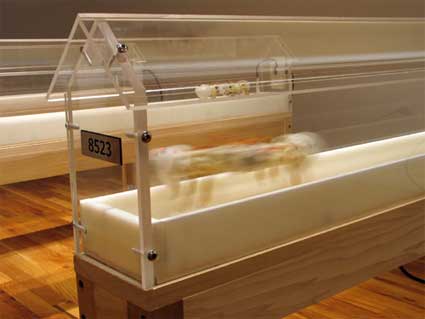
8520 S.W. 27th Place, 2004
This imagery is what fueled the aesthetic for this 8520 S.W. 27th Place. I wanted to reference the suburban dwelling that millions of other people worldwide grew up in as well. I thought it this would be the appropriate stage for a sculpture that speaks of humanities’ decision-making process. It is within the walls of these prefabricated, automated homes that we ceaselessly make decisions about everything; from the type of partners we want, to the garnishing on our pizza delivery, to what color we want our IPods. Endlessly. Back and forth. From the moment we are born till the day we die.
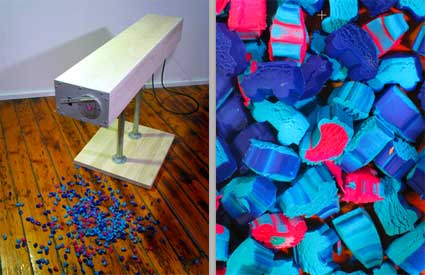
Extruder, 2008
How did you come up with Extruder? Where did you get the idea of making a machine that makes play-doh cars?
I arrived at the idea for Extruder from a couple different places. It branches from a series of drawing machines that I made a couple years back. Extruder started because I wanted to make a machine that could make sculpture. I had been doodling designs for this mechanism for years. I suppose funding issues kept them from materializing until now.
This last summer I made a series of paintings that spoke of war, dismemberment, IEDs, and automobiles. During that process, I came to appreciate the impact that the automobile has made on this world. I read a statistic that still baffles me when I think about it now. There is one car for every 11 people in this world, roughly 590 million passenger cars total. The automobile is involved in everything. From pancakes to penicillin, Play-Doh to parking lots.
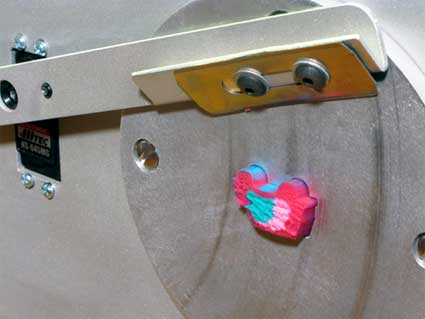
Extruder, 2008
I developed Extruder as a response to this machine that we worship. I wanted to celebrate it. Criticize it. Emulate it. Making hundreds of Play-Doh cars. Millions. The ultimate goal of Extruder is to make the total number of automobiles that were made in 1947 (the year Henry Ford died) by the Ford motor company, an estimated 429,674. As you can imagine that is also a whole lot of Play-Doh; about 11 tons. Until May 11th 2008, Extruder will be making Play-Doh cars at the Mandeville Gallery at Union College in Schenectady, NY. When the next venue emerges to exhibit it, the process will continue.
The colors that Play-Doh comes in were also a nice reference to my recent paintings. Vivid primaries and secondaries, suggesting the Technicolor cartoon reality that we in the developed world live in. Entertainment for the masses, delivered in candy-wrapped doses of violence, humor, and erotica.
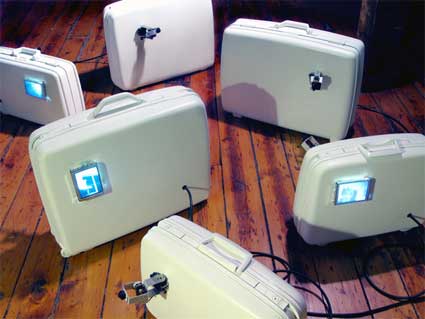
Carry On
The Carry On installation features a series of suitcases fitted with robotic arms and micro-cameras which survey their surroundings. Why did you feel the necessity to develop a work that explores surveillance and paranoia? How much impact on the public can artists have when they comment on surveillance technology?
Carry On is a direct reaction to post-September 11th paranoia, both in the USA and abroad. Since the attacks, I have traveled quite a bit. On these trips, I have passed through countless security and surveillance systems, always hunting for the would-be terrorist. Subway cars now display and sometimes speak “Report ANY Suspicious Activity”. If you happen to look even slightly of Arab descent, you may think twice about growing a beard or wearing your traditional garb. Leaving your luggage or backpack alone in an airport or a train station, even for a moment, could lead to a cavity search.
Holding a miniature video camera, on one side of each suitcase in Carry On is mounted a two axis robotic arm. The live video feed from this camera is displayed on a LCD screen mounted on the other side of the suitcase. Every couple of minutes, the robots change the position of the cameras, thus changing what is being displayed in the LCD screens. Lacking image analysis of any kind or other sensory capability, these suitcases blindly look about, never understanding what they see.
I’m not sure what impact artists make when they reference surveillance technology. Perhaps it may give a person a moment of peace or clarity. Realizing that, like the artwork in front of them, the whole affair of paranoia and fear based politics is an illusion; clever clockwork designed to create the reality they want us to believe in.
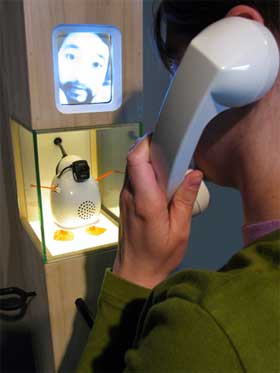 I saw that images of one of your recent project, Phoney. What is the work about?
I saw that images of one of your recent project, Phoney. What is the work about?
Phoney is a toy. It is a kind of absurd videophone. There are two terminals to the piece. The terminals are installed in separate parts of a gallery, with no line of site between them. Each terminal is fit with an old-school telephone receiver, a video screen, and a black and white camera attached to the head of a modified mechanical toy. When a person speaks into the telephone receiver of one terminal, their voice makes the mechanical toy on other terminal dance. This causes the video image they are looking at to shake, since the camera on the other side is attached to the mechanical toy. If two people are involved, a bizarre and sometimes funny conversation can commence. To me the piece references the countless methods or proxies that we now communicate through and the ridiculous information that we pass through them.
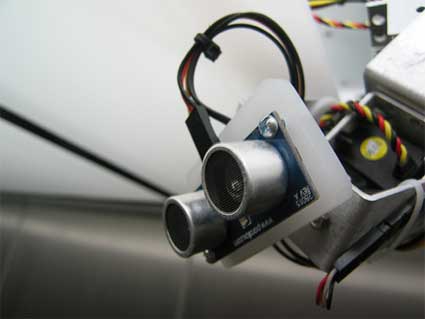
Elevator’s Music, 2007
I read that your work is about “creating systems that seem to be alive”. How much life is there really in your artworks? and how would you define such kind of life?
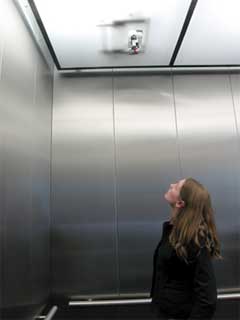 The key part in the quote above is this: “seem to be alive”. My machines are not alive. They never will be. I have become much more interested in the simulation of living systems. It is remarkable how easily we anthropomorphize things, especially things that are in motion. The perception of what humans will assume or believe to be alive is where much of my robotic work is headed.
The key part in the quote above is this: “seem to be alive”. My machines are not alive. They never will be. I have become much more interested in the simulation of living systems. It is remarkable how easily we anthropomorphize things, especially things that are in motion. The perception of what humans will assume or believe to be alive is where much of my robotic work is headed.
The latest iteration of this investigation is Elevator’s Music, a site-specific robotic sculpture that I exhibited in an elevator at the Tang Museum in Saratoga Springs, NY in the winter of 2007. It consisted of four small robots that emerged from the elevators translucent ceiling panels. When people entered the elevator, the robots would sense them and might emerge. Fitted with sonic sensors and having the ability to maneuver in three axes, they were programmed to seek out and respond to near and far objects. If a robot found something near by, it would try and interact with it via randomly determined mechanical gestures and a watery stream of sounds. The robot would also send a message to the other three robots (through a local network), informing them that it had found something of interest. This would cause all robots to look in the direction of the object, causing a kind of musical symphony to commence. If the object was somehow to close, or if nothing was found, they would recoil back into the safety of their ceiling panels.
With this relatively simple set of instructions the elevator robots were able to illicit innumerous reactions from their passengers. Some believed that the robots were watching them or trying to attack them in some way, while others became enamored with them, whistling and talking to them like one would to a pet bird. When one of the robots failed (as all robots eventually do), passengers reported it immediately to museum officials, feeling empathy for the hurt machine. Future robotic sculptures that I design will foster this tendency to assign anthropomorphic qualities to inanimate objects. Through this investigation I hope to arrive at more sophisticated and realistic artificial life simulations.
Video of “Elevator’s Music” at the Tang Teaching Museum at Skidmore College in Saratoga Spring, NY
What can technology developers or scientists learn from digital artists like you? Is there any reason why they should pay more attention to what crazy artists are doing?
I like to think they should pay more attention. In this country there is a general undervaluing of fine art and art education. Art departments all over the nation are the first to suffer from severe budget cuts. The argument that art is not a “mission critical” subject has dominated the establishment for decades. The problem with this of course is that students become completely illiterate to the visual culture all around them. In engineering and science I think this becomes a handicap. The engineer or scientist that can beautifully communicate their findings will undoubtedly fair better on the world stage. Moreover, those engineers or scientists that are willing to experiment with ideas that seem pointless or ridiculous may arrive at discoveries, innovations, and conclusions that otherwise might have eluded them. Perhaps “crazy artists” do have something to teach, other then just being dismissed to be irrelevant or a waste of time.
What is your favorite gadget or bit of technology and why?
It would have to be my laptop. I basically live inside it (or through it?). That aside, I have to say that I am a huge space technology nerd. I read everything and anything about space. Spirit and Opportunity, the two rovers scooting along on mars, or Voyagers one and two, speeding out of the solar system at this very moment are like aphrodisiacs to me. In fact I have a number of art projects that I am just waiting to develop specifically to be put into zero-g environments. Hopefully by the time I am retiring, this will be a possibility! In classic nerd style however, I would first need to over come the crippling and ridiculous sea-sickness I suffer from, sometimes even on sea-side docks.
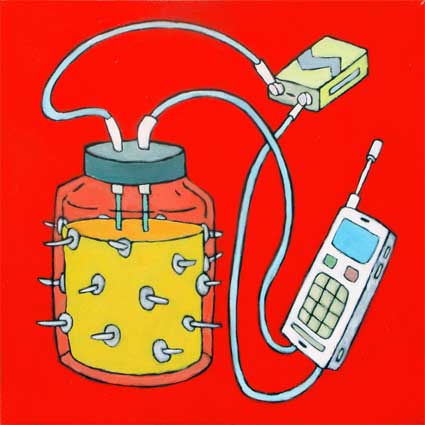
Nail Jar, 2007
What are the common factors between your media art installations and your paintings? Or maybe they have nothing to do with one another?
Painting and drawing is something I have always done. It was my doorway into art and in many ways it keeps me balanced. Until recently, the subjects I painted came from the schools of dada or surrealism, seemingly from my subconscious. This all changed in my recent work. Without really knowing why, last summer I started tackling the subjects I was exploring in my electronic sculptures in the paintings. Painting allows me to quickly approach different angles or points of view within a subject, some of which would not be possible in media sculptures due to funding or physical limitations. It is also a way for me to quickly explore new ideas, some of which are now leaving the canvas surface and becoming sculptures.
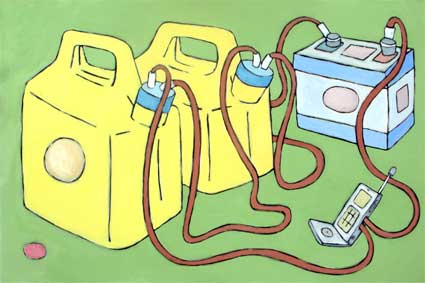
Gasoline, 2007
You are also developing an electronic art program at Union College in Schenectady, NY. Can you tell us what the highlights of the program are?
I was hired three years ago to help start an electronic art program at Union College. Our program is one of the few electronic arts initiatives that is jointly sponsored between the Computer Science and Visual Arts Departments. Drawing from aspects of The School of the Art Institute of Chicago and The Ohio State University’s Art and Technology programs (both of which I graduated from), we have created a thorough course of study, covering topics in digital imaging, video, 3D modeling, physical computing, experimental computer programming, web-design, interactivity, and animation. We have worked hard to make the program as cross-disciplinary as possible, offering courses that computer science, fine-art, and students from other disciplines can benefit from. In many ways the program was a perfect fit at Union College, since it has a long tradition of combining world-renowned engineering within a equally solid liberal arts education.
Any upcoming project or event you could share with us?
There are a couple projects cooking. The most imminent is a real-time video series titled Plain Text. The series plays on the “infinite monkey theorem” which states that given an infinite amount of monkeys, typewriters, and time, the monkeys will type out any particularly text you choose. If one instructs the monkeys (or monkey simulators), to type the King James Bible one of them eventually will. Interestingly, this also includes all the text that you did not choose or any text that might ever be written.
I apply a version of this theorem to a series of short phrases that over an extended period of time cycle through every possible permutation of themselves. For example the phrase:
“You want _ _ _ _ _ _.”
Starting right-to-left, like an odometer only with letters, all the blank spaces in the phrase sequentially cycle through every letter in the alphabet. By this, every word that is six characters long will eventually appear in the phrase above. Differing in theme, amount of blank spaces, and speed, each piece in the series has a different phrase displayed by itself on a large LCD screen.
 For the PluggedIn Exhibition happening in Hudson, NY from May 17th – 30th, two of these phrases will be on display in the vestibules of the Mark McDonald store, along with one large phrase projected on the store’s second floor windows.
For the PluggedIn Exhibition happening in Hudson, NY from May 17th – 30th, two of these phrases will be on display in the vestibules of the Mark McDonald store, along with one large phrase projected on the store’s second floor windows.
Thanks Fernando!
I discovered the work of Bart Hess just a year ago, at the Salone del Mobile 2007. The video of his graduation project A Hunt for Hightech was shown as part of Family of Form, the exhibition that the Design Academy Eindhoven had organized in Milan that year. Just one video on a small screen and several people glued to it, fascinated and sometimes slightly horrified. The images showed mutant skins, breathing shoes, living furs and metallic gloves. My vocabulary is actually even more limited than ever when it comes to describe the futuristic fabrics and textures that the young designer had imagined. As his website won’t give much details about him and his work, i decided to write Bart and pester him with my questions:
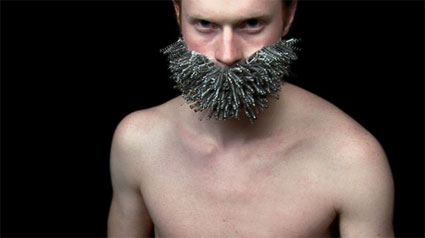
Hi Bart, i found little info about yourself online. Would you mind telling us who you are, what your background is and what you do right now?
I’m Bart Hess, I graduated a year ago from the Design Academy, Eindhoven in the Man and Identity department. This department looks at finding new materials, forecasting trends in fashion and culture. I have always had a fascination with photography, painting and fashion. Some people would say that I am shy and introvert, but when you see my work it reveals an opposite personality. I think I’m not so good at storytelling with words, but rather expressing myself with stories through images and visuals.
Right now I’m working for myself exploring several fields that straddle textile, fashion and animation, these fall within the commercial and art world.
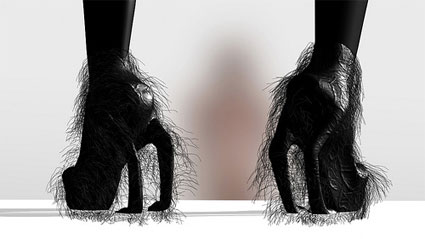
In the description of A Hunt for Hightech you write that it is “more interesting to imitate an imaginary world”? Why is that?
With a Hunt for Hightech I made a collection of fake fur that touches on elements of fetishism, human instinct and new animal archetypes. With that collection I did not try to mimic real animal kingdoms but create a fantasy world of my own. The way this started was through the process of imagining fantasy animals; animals that could be genetically manipulated, part robot, part organic, how they would move in their environment and what they felt like to touch. I then took my (imagined) gun and ‘hunted’ them, looking for their extra ordinary, high tech furs. I thought about tactile qualities like reflection, the way the hair grows and three dimensionality and took these characteristics, magnified them, manipulated and exaggerated them.
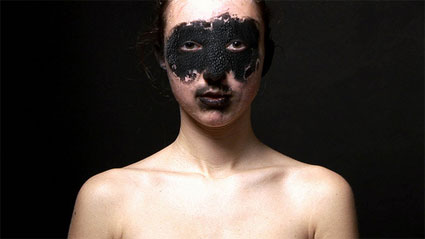
Can you explain us which kind of materials you have designed for the project A Hunt for Hightech?
I used materials that were not organic or commonly seen in the fashion world, and blended plastics, metallic’s, silicon’s and technical foils. With these materials I tried to manipulate and re-create the same qualities and tactile feeling my fantasy animal kingdom has.
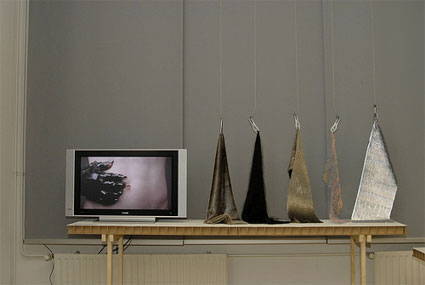
Which technological discoveries have inspired the whole project in general?
Prosthetic technology, where robot or machine meets with human nerve ending and flesh is definitely an inspiration but not an obvious link when you see the result of my project. Genetic manipulation has a clearer connection where it allows or dictates a new or changing evolution. This combination of nature, technology and evolution inspired me to create my own new animal archetypes. In my “Hunt for Hightech Animal Kingdom”, animals can change their prints to distract predators, or grow their hair meters longer to appear bigger.
Your work has been exhibited in many venues and magazines. How does the public react to it?
There seemed to be two reactions from the public, there were people who were not freaked out at all and found it very attractive. These were the people who investigated and were intrigued by the furs and discovered the fabrics were quite soft, even though they were made from needles and sharp metallic’s. The other type of people were scared and shocked with the idea of breathing shoes, these were the people who would get hurt touching the furs. One of my intentions was to communicate tactility and spire an emotion between the viewer and the furs, and this happened in both cases.
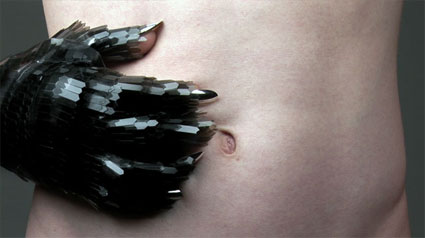
The models you present in A Hunt for Hightech are futuristic and fascinating. Do you see them more as sculptures or future pieces of clothing?
I really believe these are the fashion furs of the future. Why kill an animal and re-form the fur into a shape? Why not have the animal already shaped to your body, have it living and breathing around you, like the shoes. Whilst the technology is not there yet, in the meantime the animation is used as an inspiration for the fashion industry. At the moment I’m consulting at the Stijlinstituut in Amsterdam making animation and photographic collages to express and create future atmospheres. This gives me the opportunity to re-create ideas that really do have an impact on trends in the future, be it fashion, product or architecture.
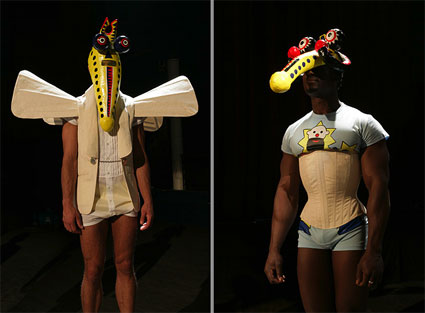
Walter Van Beirendonck, Men’s collection Spring/Summer 2008 – SEXCLOWN
You also collaborated with my favourite fashion designer, Walter van Beirendonck. What was your role in the development of his collection? Can you tell us a few words about the collections you participated to?
I started working with Walter van Beirendonck for my internship. For six months I worked on the “Stop Terrorising our World” collection doing computer illustrations for prints. This was where it all started and I have been collaborating with Walter ever since. For the “Sex Clowns” collection, Walter had the idea to create avatars and he asked me to visualize his illustrations into 3d drawings. The Sex clowns collection combines new digital life-form, with an all time classic fascination of Walter, fetishism. Fantasising about new types of Fetishism, he created a group of self-conscious men, proudly presenting their masculinity and body diversity.

In some of your work it seems that the garment or shoe is almost part of the wearer’s body. How do you think new technologies could impact the body aesthetically and fashion-wise?
I think a good example of where technology and the body meet, is a project that `I have worked on with Philips Design Probes team, a provocation for an Electronic Tattoo. In this scenario a tattoo traverses across the landscape of the body moving and morphing with touch and gesture. In this case the tattoo becomes a fashion accessory using the body as canvas for moving image, where the technology opens up new forms of communication between two people.
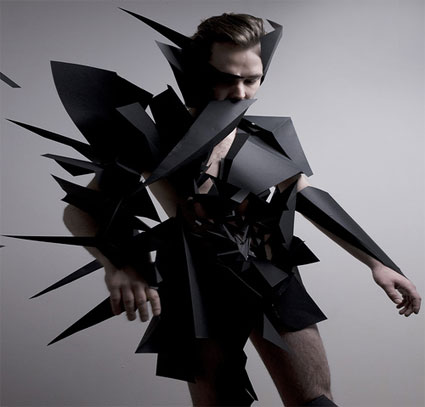
The photographies you make together with Lucy McRae present alternative bodies or body accessories, cosmetic surgery, etc. Where does your inspiration come from?
I work with Lucy McRae in a primitive and limitless way. We work with our instinct and start by using a material on our body, exploring volumes and ways of re-shaping the human silhouette. We work fast, for one day at the end of the week expelling all our creative energy and stress, making a series of photos that capture an atmosphere. We share a fascination with genetic manipulation and beauty expression, but it is not our intention to communicate this. I think unconsciously our work touches upon these themes, we create future human shapes and new body form’s. LucyandBart is blindly discovering a low – tech prosthetic way for human enhancement.
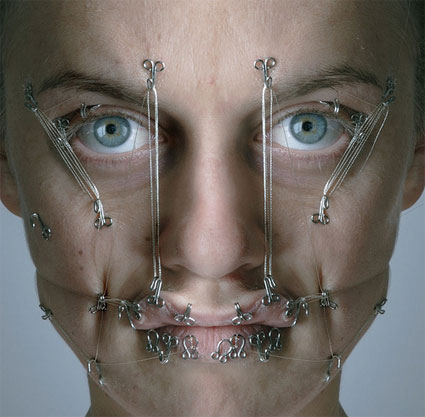
Any upcoming project you could share with us?
I have an exhibition coming up in the Summer in Fort Asperen called ‘Closer to the Skin’. For this show I’m making large scale furs, approximately two metres square, I have developed a method for making the furs automatically that enables me to create the pieces much faster and bigger. I’m also starting a project now with the Textile Museum in Tilburg where I am designing my own collection of textiles using a 3d knitting machine, laser cutting and a loom. There are several other projects I am working on, but unfortunately I can’t mention them yet, they will be on my website when they are finished!
Thanks Bart!
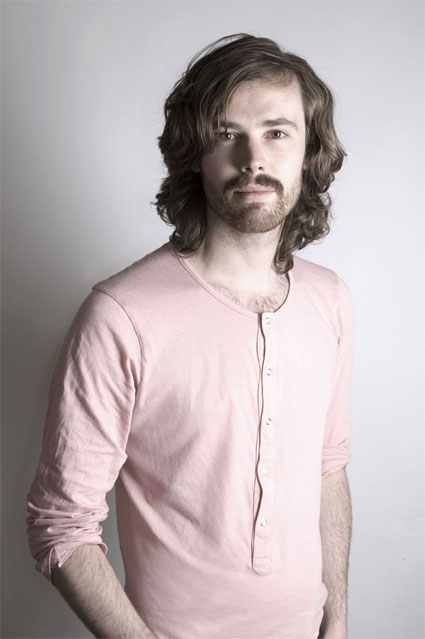
Portrait of Bart Heiss
Related: Lucy McRae’s talk at NEXT.
Reading the lovely blog of Cati Vaucelle, i discovered the work of Kate James. Kate is a second year graduate student in the Visual Arts Program at MIT. After having studied dance/kinesthesia and architectural history at Brown University, she did a Master of Architecture at MIT before transferring into the Visual Arts program.
Her design, fashion, performative, video and space projects focus on the body, its habits, movements, and the dynamic sectional relationship to its surrounding structures. They have this wonderful mix of quirkiness and deep relevance to the issues she investigates.
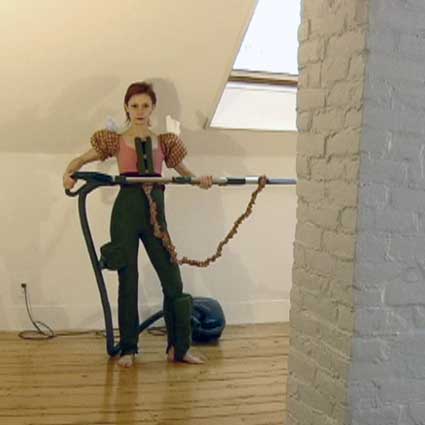
You have a background in both dance/choreography and architecture. How does your knowledge of the body and its dynamics feeds your thoughts and creativity in architecture? How do you make these two seemingly different fields meet?
I started studying dance and architecture at the same time, during my first year as an undergraduate. Maybe because of that, my understanding of architecture has always been rooted in the body. I think of architecture as a built echo of body itself: corporeal issues of public/ private, structural systems, skins, orifice and interface all resound in architecture.
Now, I often site my art practice between the body and its surrounding structures. This dynamic negative space houses habitual life and cultural inscription, and is therefore subject to interrogation through artistic intervention.
Your MIT page says that your work attempts to “question and complicate the interfaces between the corporeal and the environmental”. In a time when most designers talk about “making it simple”, why do you think it is important to “complicate”? Which form does this complication take?
I guess by ‘complicate’ I mean to acknowledge and engage with the complexity of the interfaces already in play. We so easily naturalize our interactions and surroundings, ignoring the layers of choreography imposed on the everyday. By tweaking and reframing the everyday relations between the body and its environment, my work refutes the source and nature of that everyday ritual.
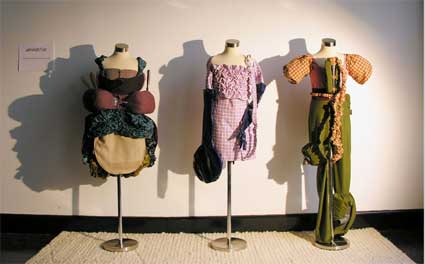
I was very intrigued by the atHABITat costumes. There is one for vacuuming, one for serving food and a third one for putting away the dishes.
What was the inspiration for them?
Can you describe us what they are about and how each of them should be used?
The atHABITat costumes are about a contemporary vision of the woman in the home, and a need to multi-task and overlap the upkeep habits of the body and the home. They are costumes worn to augment the household maintenance task, transforming it into an iso-kinetic exercise. Each costume records and accentuates the ergonomics of the activity.
In one, resistance band connects the vacuum wand to the wearer, intensifying the sweeping motion of the vacuuming. The ‘putting away dishes’ costume attaches a similar resistance band between the dishwasher and the wearer’s vinyl gloves. In the ‘serving food’ costume, bands run through an oven mitt corset piece to accentuate the tension in the serving motion.
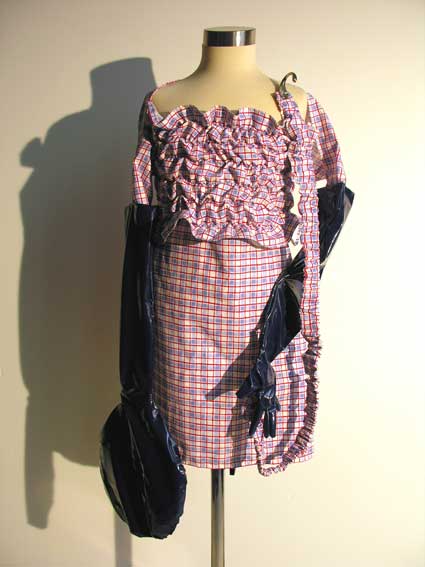
Once you have an idea for a project how do you push it forward and bring it to life? Do you test the idea on other people? Ask for feedbacks? Get depressed because it is technologically impossible to prototype it? What is the path that leads from idea to working prototype?
I would say the process goes like this: dream, doodle, make, discuss, research, make more, research more, discuss, display.
In terms of the making, I’m not a pre-planning type. I design and make things in one fluid mess of a step, whether this involves sewing, welding, or performing. The concept and research frame are usually fixed, but the work formally develops in an organic way as it goes along.
My biggest frustration is usually the scope of the projects compared to my personal capabilities. Because my work is very much about self-production, and because of the flow of my design process, I am committed to be involved with the craft and production of my costumes and props. But this production can involve 200 pounds of steel to weld or 60 hours of hand-sewing on a particular project.
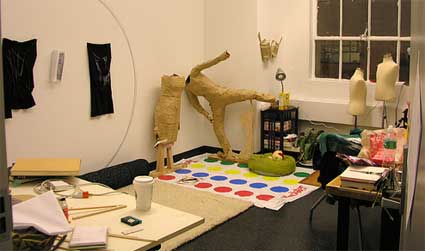
Kate’s working space
The garments you create are very well-designed. But do they function purely as accessories for performances or could you imagine everyday people wearing a modified version of them?
When I make costumes, they aren’t intended as prototypes for products. They are very individuated, for one thing, designed specifically for my own home and body(both formally and functionally).
The costumes are an integral part of my performance practice. They are there to suggest that there is a latent potential for self-production in the scene of the everyday, and to transform actions into performances.
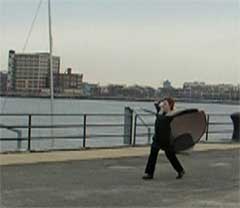 What was the inspiration for Dressails?
What was the inspiration for Dressails?
As a dancer, I was fascinated with falling. I studied how to fall, and tested gravity all the time.
I also sailed a lot when I was younger. I was terrified of, and in love with, especially strong winds that would tip the boat up on its edge and press hard on the sail.
I thought about this moment of negotiation between the control of the boat and the natural force of the wind. I wanted to give over some control of my body’s movements to the wind in the same way, and used clothing design to achieve that. The dresses cause the wearer’s body to teeter, spin, and lean, to be engaged with a natural and sporadic force a way that wouldn’t be possible otherwise.
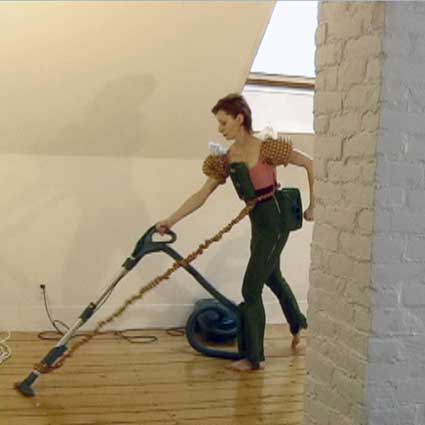
Could you tell us about some of your recent projects?
One thing I’m working on in an ongoing way is a series of videos about my (7) vacuum cleaners. One piece involves assessing the manual instruction versus reality of use. Another documents a normal vacuuming session that turns into a full-on wrestling bout with the machine.
I also made some wearable trampolines last year, and performed with them in a piece called ‘Six Corners’. There is a dynamic relationship between the body and the material and weight of the skirts. They are meant to discuss movement pattern, issues of personal boundaries, and body extension.

Which artists or designer do you find most inspiring and why?
Artists whose work I look most often at include Rebecca Horn, Martha Rosler, Bruce Nauman, Miranda July, Joan Jonas (who is my thesis advisor, which is an amazing privilege), Nina Yuen.
More and more I find myself looking at dancers/ choreographers who make art, especially Trisha Brown, Yvonne Rainer, Ann Carlson.
I look at screen stars as well, those who use their bodies to tell stories: Lucille Ball, Charlie Chaplin, Buster Keaton, the cast of Three’s Company.
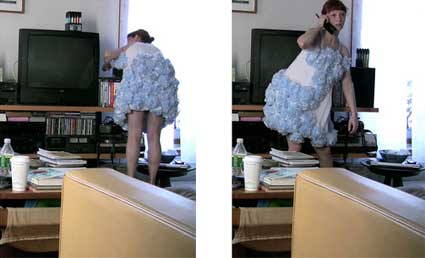
Any upcoming projects you could share with us?
I’m working on a project right now in conjunction with my thesis (titled ‘homebody’). I’m making more home maintenance costumes and associated performances. So far, I’ve made a video of a phone conversation I had with my mortgage agent while wearing/using a dress constructed of Swiffer rosettes.
A last one: what is your relationship with fashion?
As an artist, I certainly engage with fashion. By this I mean that I think closely about how the body is clad, and how clothing can inform the body and vice-versa. Fashion becomes a key interface in the investigation of the body in the environment.
In terms of performance and the impact of costuming, fashion offers a fantastic bank of codified aesthetics, which can be drawn from for conceptual and phenomenal meaning.
Thanks Katherine!
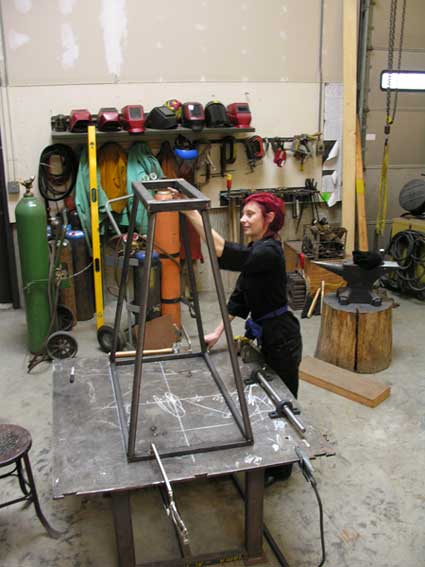
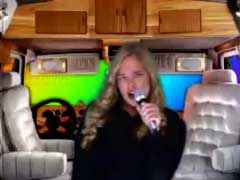 Before meeting her, i had always imagined Marisa Olson to be an hyperactive blond girl running around the internet playground. She seemed to have so much fun online… surely that girl was made of pixels. And even now that we’ve met several times, i’m not totally sure that Marisa is real.
Before meeting her, i had always imagined Marisa Olson to be an hyperactive blond girl running around the internet playground. She seemed to have so much fun online… surely that girl was made of pixels. And even now that we’ve met several times, i’m not totally sure that Marisa is real.
Marisa’s work combines performance, video, sound, drawing, and installation to address intersections of pop culture and the cultural history of technology, as they effect the voice, power, and persona.
Marisa lives between California and New York, where she shows one of her (half) serious faces: she is a “Curator at Large” at Rhizome. You can find her on her whatamidoingwithmylife blog, on the Nasty Nets Internet Surfing Club, on her website and 3 years ago she was writing about her preparation to audition for the popular reality TV show, American Idol on yet another blog
How does one become Marisa Olson? What is your background and how did you get involved in technology-based art making, reviewing and curating?
Hmm… That could be hard to answer quickly. I was always a geek. I programmed the heck out of my C64! I was also always obsessed with mediated communication in the form of pop culture (radio and tv) transmissions. Add to this the fact that my dad worked in intelligence, growing up (I grew up in Germany, where he worked until I was 10) and I was surrounded by scary military technologies all the time (isn’t the gun one of the most significant inventions ever?) and that all spells a strange fascination with technology. I always wanted to make art, but I’m actually related to one of the most famous French impressionists and I was raised thinking that’s what “real art” was. It turns out I wasn’t very good at that kind of art. So I stopped worrying about what was and wasn’t art and just focused on what I found interesting. I spent most of my undergrad and grad school years in the SF bay area, and lived through the surreal waxing and waning of the dot-com. I wrote for Wired, consulted a few start-ups, and that sort of thing. Meanwhile, the area was overflowing with artists expressing themselves in work that engaged technology. And I really related. After that, the progression was natural and rapid. I threw myself into new media–as an artist and in terms of supporting the field, not entirely distinguishing between my writing, teaching, or curating. The more peculiar thing, for me, has been switching gears from being a musician (I’ve been a singer and lyricist in a few bands and grew up in choirs) to making work about music (most recently my Oh.Yeah.I.Love.You.Baby. remix album). There’s definitely an interest in the DIY there, but I guess this is also why I often organize my projects as “albums” (like my Break-Up Album (Demo) video project) and I tend to think of curating like making a mixtape.
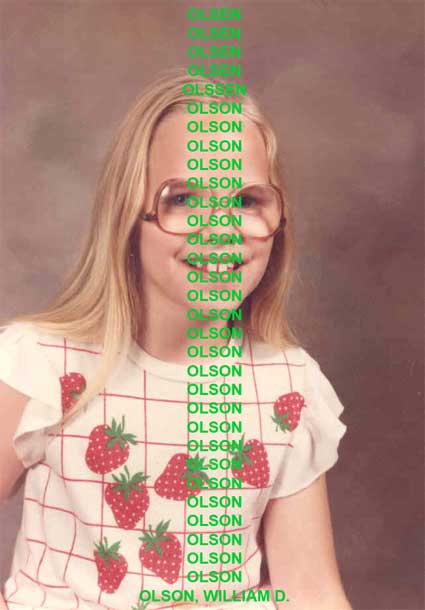
In Abe & Mo Sing the Blogs, an online project for which the Whitney Museum of American Art commissioned an Artport Gatepage, you and Abe Linkoln sing posts from your favorite blogs. What was the impetus for that project? There’s been several discussions of trying to turn blogs into an art form or an art project. What is you take on this issue? Could you name us other examples of successful “blogs-turned-art” projects?
Abe and I are both compulsive web surfers and love unusual blogs. We decided to pick our favorite posts from our favorite blogs and sing them, in a sort of concept album mixtape. His and mine are pretty different. They are all really funny. In our official description of the project, we say that blogs, like the blues, have been credited with channeling the “voice of the people” and we wondered if we could identify specific genre conventions on blogs. We were kind of interested in the blog as a stage for “site-specific” performance, which also carried over into our Universal Acid project. We’d both done blog-based projects before, which was how we met, online. We sent each other fan letters about his conversion of net artist Olia Lialina’s My Boyfriend Came Back From the War and my American Idol Audition Training Blog. I also loved Screenfull.net, Abe’s old blog with Jimpunk.
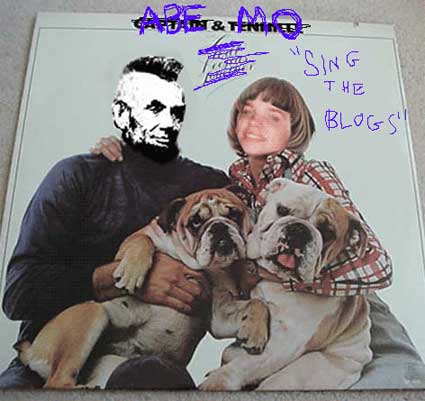
Our first collaboration was actually a blog called Blog Art, which was a curated blog listing blogs that are art projects. At the moment, I’m really into group blogs that ride the line between art practice and some other sort of internet fan culture. For instance, some friends and I founded an “internet surfing club” called Nasty Nets–in which we sort of simultaneously celebrated and critiqued the internet–and I love other group surf blogs like Supercentral, Spirit Surfers, Double Happiness, and Loshadka.
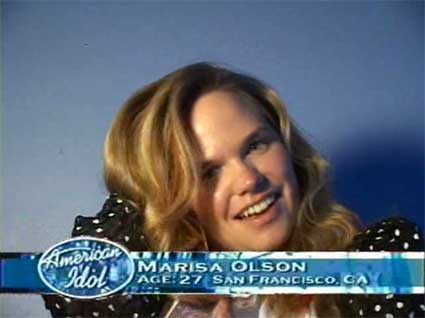
When you blogged your efforts to audition for “American Idol.” How did people around you react to that decision? What did the whole training teach you (i’m not only talking about sun beds and stilettos boot camps of course)?
Well, my family and grad school professors at the time certainly thought I was crazy. I made what was probably the mistake of announcing it by emailing people out of the blue with the subject line “I need your help” and inside I asked for help in picking what song I should sing. Even though I linked to a New York Times article about the blog, a lot of people told me later that they really thought I was seriously delusional about trying to get on the show! They didn’t recognize it as a parody, which is kind of awesome. I started the project wanting to critique the show (which I admittedly also loved) and the gender normative stereotypes it pushes. I was concerned about how artists rights to their own work & identity were violated by the producers, in my opinion. But the project took on a life of its own. The lead-up to my audition (in 2004) was the same as the build-up to the presidential election between Bush & Kerry. I started thinking of how the show is predicated on a model of democracy and voting but I kept hearing how my generation (the main demographic for the show) wasn’t showing up to polls. They would stand in line for 8 hours to audition, but not 15 minutes to vote. So the project became all about voting. I told readers how to register to vote, brought registration forms to the auditions, and I had readers vote on what I should wear & sing. Ultimately, I collected over 10,000 votes in the course of trying to get young people to think about the many ways in which they could use their “voice.”
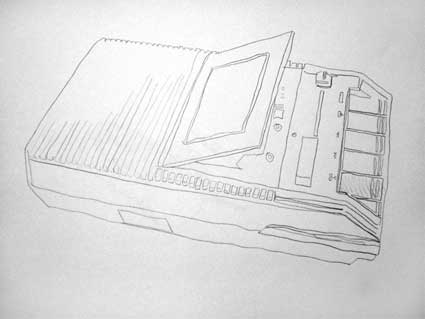
You are also a curator, both independently and as part of your activities at Rhizome. Your curating often deals with new media art pieces. What are the challenges of curating and exhibiting works of new media art today?
I think that there is presently a very exciting turn happening in new media, with respect to both the art world and the context of “traditional media.” It used to be very important to carve out a separate space in which to show, discuss, and teach new media. Nowadays these spaces are sometimes seen as ghettos, but at the time, they were safe havens championing under-recognized forms. Things are more co-mingled now. Not everyone will agree with me about this, but I think it’s great that some people no longer even know new media when they see it. I know curators who turn their nose up at that phrase, but they love Cory Arcangel or Paul Pfeiffer. There doesn’t seem to be a need to distinguish, any more, whether technology was used in making the work–afterall, everything is a technology, and everyone uses technology to do everything. What is even more interesting is the way in which people are starting to make what I’ve called “Post-Internet” art in my own work (such as my Monitor Tracings), or what Guthrie Lonergan recently called “Internet Aware Art.” I think it’s important to address the impacts of the internet on culture at large, and this can be done well on networks but can and should also exist offline. Of course, it’s an exciting challenge to explain to someone how this is still internet art… If that really matters…
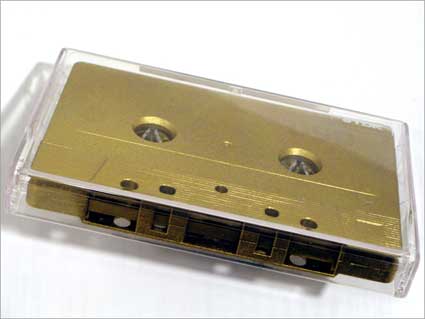
Your Media Change course at ITP/ NYU explored the “evolution” of technology. How does your teaching explore an area which is well… evolving so fast?
I feel like this is a great opportunity and a perfect class to teach at an amazing place like ITP, which evolves daily, with the technology. But I think the way to do it is to try to see media change as having a longer-tem trajectory. I have a background in media theory. I studied History of Consciousness at UC Santa Cruz and am PhD Candidate in film studies and new media in the Rhetoric department at UC Berkeley, where my dissertation is on The Art of Protest in Network Culture. So I’ve read, loved, and taught the classic McLuhan, Benjamin, Kittler, Flusser, Baudrillard, Jameson, etc over and over again. The aim of this class was to consider the cultural and political forces behind the evolution of technology and the broader concept of “change” (which most certainly also incorporates social/ political change). So we read these classic historiographies but tried to read them from the present context as well as the original one. And we read them beside Alex Galloway, Henry Jenkins, Clay Shirky, and other great contemporary writers. I mean, this stuff can never be pinned down long enough to be considered in an isolated temporal context, but it’s still important to consider the personal and political forces that compel media change–the desires and impetuses.
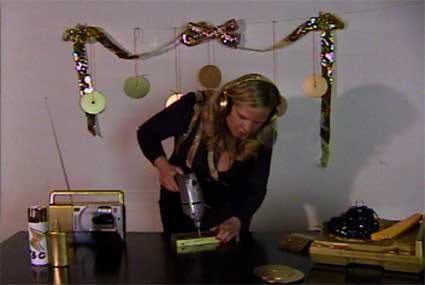
In your recent Golden Oldies performance/ video, you seem to give a very hard time to a bunch of electronic devices. What is your own relationship with technology?
Ha, well… It occurs to me now that you could probably say that my relationship to technology is a bit sado-masochistic. I don’t mean for that to sound weird or sensational. I think, in the true classical psychoanalytic sense, many people’s relationship with technology is very wrapped up in both their libidinal and death drives, as Freud would call them. I guess this video demonstrates that I enjoying abusing technology as much as I enjoy observing its abuse of me. I’ve always been a fetishist and could never try to hide that. My studio is littered with blinged-out headphones, radios, and cassette tapes. But the tapes I’ve been calling Time Capsules. I mean, they are moments of time that are disappearing but not really going away, so instead I try to prevent their burial (in a landfill) by taking them out of circulation and painting them gold, much like the symbolic bricks in Fort Knox. InGolden Oldies, I try unsuccessfully to instigate communication between media of various generations–tapes, vhs cassettes, records, cds…. And after drilling, hammering, and chiseling each one, I give up and wipe the garbage to the floor–where is becomes “out of sight, out of mind,” as we say in the US. I feel like this is what’s happening with all of our tv’s, walkmen, air hockey tables, nintendos, etc as we follow our drives to upgrade. They just get pushed into dumpsters and disregarded. And I’ve been trying to think about my own role in this cycle, because I certainly love my ipod as much as the next gal.
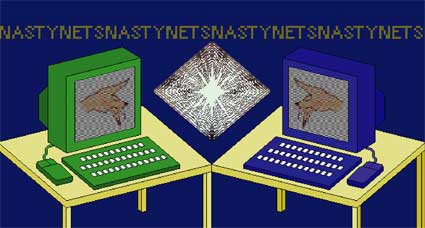
Any upcoming projects you could share with us?
Well, we just released a DVD of Nasty Nets members’ work (there are 25 of us, including some of my very favorite net artists), and that was generously funded by Rhizome. It includes videos as well as loads of data files and a type-in website by fellow Nasty Michael Bell-Smith. People can get the DVD online, and if they are in New York, they should definitely attend our premiere screening at the New York Underground Film Festival this Friday, April 4th, called Nasty As U Wanna Be.
Otherwise, as you can see, I’m really obsessed with the future, at the moment, which is kind of funny for someone who tends to say that her work is about the cultural history of technology. I’m just starting to work on a project called “Martha Stewart Assisted Living” and it’s a near-future version of Martha’s show (guess who I play!) aimed at an aging audience whose lives have been lengthened by new technologies, but who are also suffering side effects, like head goiters from their cell phones or Global Warming-Related Illnesses (GWI’s). I’m devising special recipes and craft projects for those 130-year-olds!
Thanks Marisa!
Previously: Sousveillance culture, a panel curated and moderated by Marisa Olson.
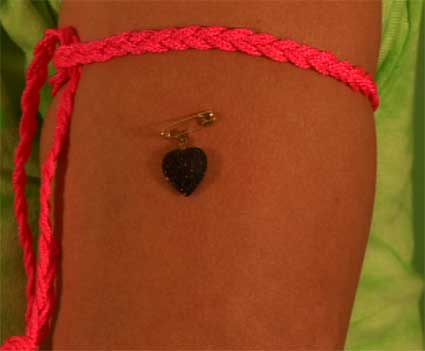
I usually associate industrial design with a high dose of virile technology, some big yawn ideas and a pretty lame design. I’ve seen enough Industrial Design graduation shows to say that only part of my lack of enthusiasm is due to my very own and very deep ignorance. However there’s one ID show i’m always happy to check out when June comes and graduation shows pop up all over London. It’s the MA Industrial Design (MAID) at Central Saint Martins College of Art and Design. The graduates projects are smart, funny, the design is yes! the design is good and they manage to created a quirky scenography to make the visit even more enchanting.
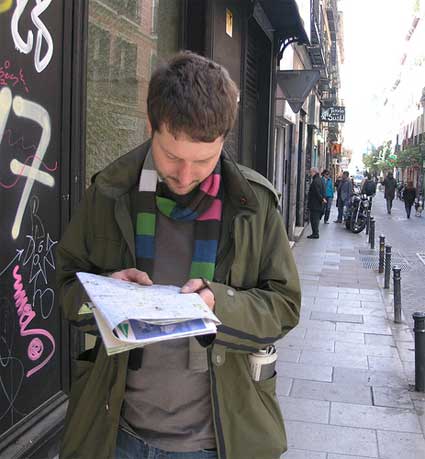
That’s why, dear readers, in my quest to always inform and entertain you, i’ve asked the Course Director of MAID, Ben Hughes, if he’d have time for an interview. Ben trained as an Industrial Designer in the UK, worked for consultancies in Taiwan and Australia and came back London where he’s been heading the course since 2000, writes about and practices design, and consults on industrial design, brand and marketing.
In last year’s department catalog, you wrote a collage “manifesto”: What can a collage approach offer to the design discipline?
The course has long encouraged the incorporation of collage into the design process. It is such a simple and powerful means of both generating and communicating ideas. It is also available to anyone with a pair of scissors and some glue. I first experimented with collage when I was studying for my own MA, influenced by a classmate from Spain (from where many of the Collage Maestros originate). He introduced me to the work of Joan Brossa and Max Ernst, etc. and I have been fascinated ever since. We have adapted the use of the technique for designers on the course and have run workshops with current maestros such as Graham Rawle and Sean Mackaoui. The article in the magazine is, in fact, taken from a forthcoming book; “The Secret Lives of Objects” by one of my former tutors, Jane Graves. Jane taught at Central for over 30 years and had a huge influence on the subject, particularly for the postgraduate students. This book is a collection of her essays, illustrated by my students using collage.
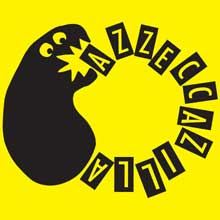 On a related theme – at last year’s Milan Furniture Fair, we mounted an exhibition workshop called Azzeccazilla, at the invitation of Stefano Mirti at NABA (Nuova Accademia di Belle Arti/ New Academy of Fine Arts). This involved each of our first year students scouring the whole of Milan for the most interesting design ideas and images, taking the brochures and leaflets concerned, and then collating them into beautiful spiral-bound A5 notebooks. Which we then sold to people for €5. Collage can be profitable, too!
On a related theme – at last year’s Milan Furniture Fair, we mounted an exhibition workshop called Azzeccazilla, at the invitation of Stefano Mirti at NABA (Nuova Accademia di Belle Arti/ New Academy of Fine Arts). This involved each of our first year students scouring the whole of Milan for the most interesting design ideas and images, taking the brochures and leaflets concerned, and then collating them into beautiful spiral-bound A5 notebooks. Which we then sold to people for €5. Collage can be profitable, too!
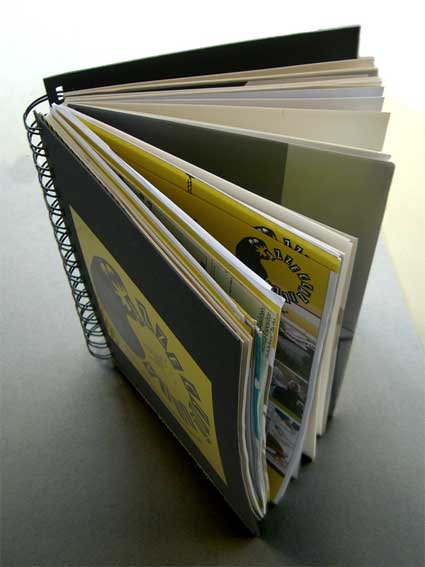
Our world is increasingly technology-mediated. How does it reflect on your course? Do you feel that students are more and more willing to engage with technologies like mobile phones or rfid system and develop projects that might sometimes look like they emerged from an interaction design department?
Certainly, we aim to adapt to the issues and technologies of the day, as well as the experiences of employers and graduates once they are in work. Industrial Designers need to be able to decode and evaluate these technologies so that they can incorporate them into products and services in a meaningful way. The term ‘Industrial Design’ relates, for me, to the mode of production, not to a dominance of particular archetypes or production methods. Enhancing a user’s experience, or making a product relevant to a particular group of people is core to the discipline. We have a number of projects every year that might sit comfortably with the category of ‘Interaction Design,’ but I am happier describing these in terms of Industrial Design i.e. how people relate to things.
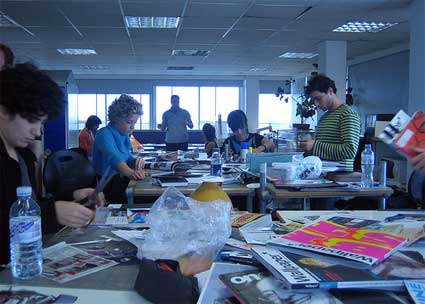
We have been experimenting for several years with different means of prototyping interactive experiences in order to test them. We continue to incorporate everything from role-play to swift cardboard test-rigs to hacking existing systems, to basic programming. In terms of the latter, we have this year started working with Arduino, which look very promising. This year we also worked with colleagues in Textile Design and the Epigenome Network to explore ideas of Epigenetics using design thinking. I would draw the line at projects dealing with the entirely hypothetical, or ‘conceptual,’ as we are primarily interested in material culture; the 3 dimensional component of this stuff.
Several projects by last year’s graduates reflect on climate change, recycling and other eco-related topics. How present are the green issues in the course? Do you feel that sustainability and eco-consciousness will keep on taking a bigger place in the course? Do you see them as becoming an integral part of the course or will they appear only in separate lectures and workshops?
Projects that deal with these issues in one way or another have been part of the landscape, and rightly part of the responsibility of design education for over thirty years. Improving efficiency, reducing waste, and a focus on real, as opposed to created, needs are central to the skills and motivation of a good designer. That doesn’t mean that we disregard market-orientated projects, though. We cannot afford to be shortsighted – it could be argued that industrial design is part of the problem in which we now find ourselves. With any luck, it could also form part of the solution. Every project in the second year is expected to incorporate an ethical dimension, but it is up to the individual concerned to determine the prominence of this. For over 5 years we have had a regular first-year project dealing with ecological issues. Last year we teamed up with Natalie Jeremijenko and her students at NYU to share the findings of these. I am hoping to repeat the experience next year.
What’s with that Benjamin socket adapter on the pages of your course catalogue and personal website?
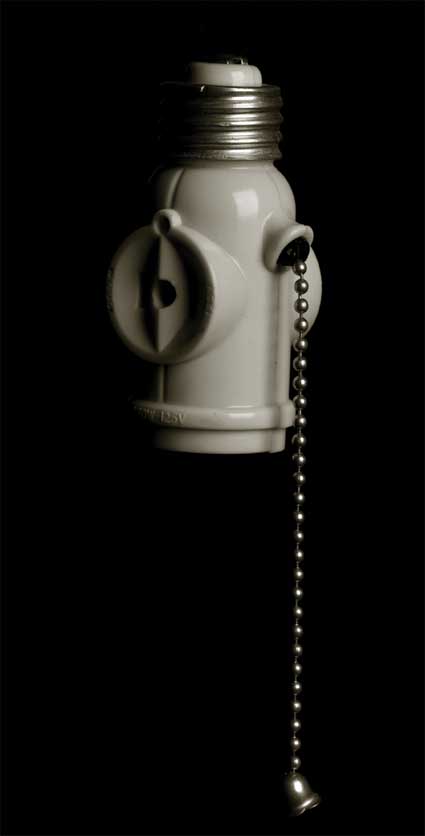
This was given to me by an ex-student. He (and it) is from Colombia, where, as I understand it, if you go into a hardware shop and ask for a ‘Benjamin’ you will be given one of these. There is no confirmed story as to why this is, but the most popular version has it named after Benjamin Franklin. I have always loved this kind of thing, which is both very clever and somewhat dangerous. I have some adapters from China, which will accept any plug from any country, although I am not sure it conforms to any British Standard. I also have a device that will recharge any mobile battery from any phone without any special adapters (the so-called ‘Omnipotence Charger,’ which has to be seen to be believed). The picture of me dressed up as a ‘Benjamin’ is part of an ongoing series that we have on the course, where students dress up as famous designers, or as in this case, designs.
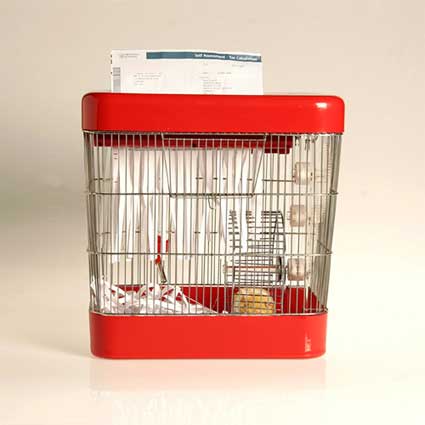
Thomas Ballhatchet, Hamster Shredder
Could you pick up some projects from recent graduates and explain to us why and how they reflect the spirit of the MAID course?
During the second year of the course, students pick their own area of study. A couple examples from this year’s show that come to mind are by Harry White and Tom Ballhatchet. Harry had a career prior to moving into Industrial Design as a scientist, working in the field of Genetics. He managed to combine this experience in a series of products that enable a user to better conceptualize certain scientific constructs. One of these is a set of measuring jugs that use unfamiliar units such as “ten billion grains of icing sugar” (not much) to “a tyrannosaurus rex brain” (even less), accompanied by a specially written recipe book, also employing these units. Harry also produced a set of “evo-cut” cutlery which demonstrate the basics of natural variation and gene mutation, and a “one-in-a-million” poster which depicts very clearly what this much-used expression really means.
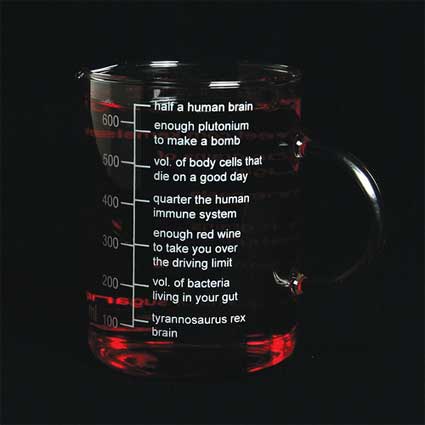
Harry White, Measuring Jug
Tom Ballhatchet, on the other hand, was concerned with issues of waste and re-use. One of the things revealed through his research was the mystery, or opacity surrounding the majority of recycling initiatives. i.e. the reluctance of people to contribute to schemes where the benefits were only faintly evident. His response was to try to localize some of this activity, and therefore lend it some more meaning. Tom managed to demonstrate this through two very different products: the Hamster Shredder, in which the inhabitant participates in the manufacture of its bedding material; and the TV Packaging Stand, which combines both the packaging, and furniture for a flat panel TV.
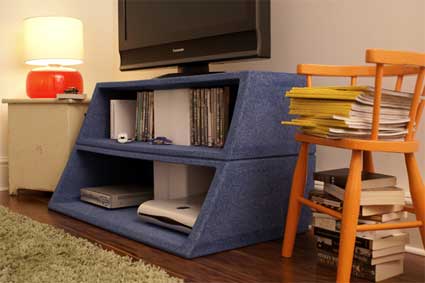
Tom Ballhatchet, TV Packaging Stand
I would say these two projects are representative the MAID course in three ways: firstly because of their sound application of a number of research techniques; secondly their confident but playful approach to innovation; and thirdly because they each achieved well-resolved final outcomes.
What is the idea behind Claystation? How well does this method of encouraging the audience participation work?
The Claystation project was born just over 5 years ago, when Piers and Rory at Designersblock were kind enough to let an outfit called the Design Transformation Group (of which I am a director) hold an event as part of their London exhibition. The principle motivation was the removal of ‘white cube’ reverence towards design objects, particularly in exhibitions. The method was to get a quarter of a ton of plasticine delivered to the show and then sell blocks of it to visitors, who then spent time making things and then animating them on a makeshift stage. We filmed the whole lot in stop-motion. It is somewhat painful to watch, although it gets better later on (it lasts over 10 minutes), as we worked out the basics of animation. The soundtrack is provided by a DJ working with samples created from instruments made by my students.
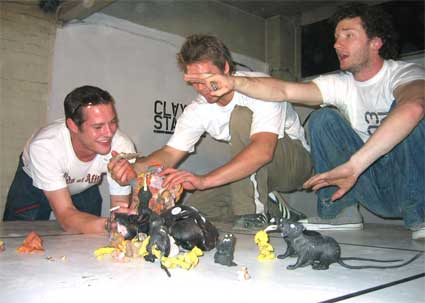
Claystation 03 designersblock, Tea Building, London 25th-28th September, 2003
This first exhibition was a big, and unexpected success, and has been adapted to many different formats over the years. We have found the Claystation format to be useful with students in generating quick 3d responses to briefs. There is now an architectural version, a product version, a chair version, a bag version, and most recently an automotive version. This year I worked with companies such as Porter International and NICE car to put on interactive exhibitions in London, Milan and New York. In Scotland, I have worked Alex Milton on the furniture version at the National Museum, and we are planning one with a sustainability theme for the Scottish Parliament next year.
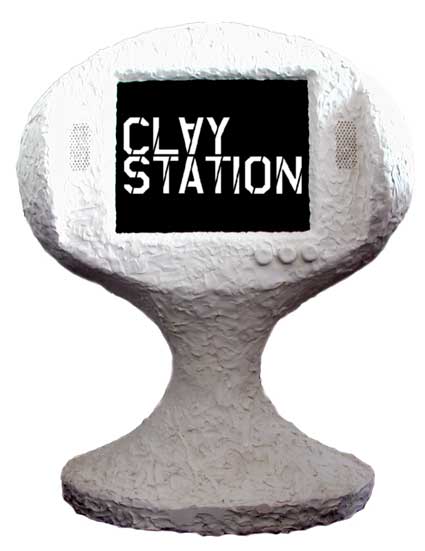
Pongovision at designersblock Milan 2005, 23rd – 26th April, 2005
Over the course of their design studies, students are often free to let their creativity run wild. How much is it still possible after they have left the school?
That depends largely on where they target their efforts. I have had ex-students express frustration with jobs. This is not because they think they are too good, but rather that their working lives are eaten up with so much tedium. At college you are encouraged to believe that design can make a difference, and to explore the ethical, and aesthetic alongside the actual business of design. This is right and proper. But it can seem a bit distant when you find yourself in a meeting, or even in a job, where the entire focus seems to be on cutting costs. Many of our students are lucky to get themselves into positions which focus on research, or design management. Many also set up their own businesses.
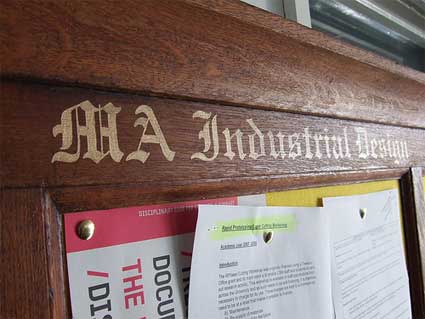
Sustainable fashion, online service, eating behaviour, etc. The work of your students embrace so many aspects of design. Is there any aspect of life left untouched by industrial design? How broad is the discipline?
If it’s an aspect of life that involves people, things and production, then no, not really. Many people appear nervous about defining what they do as ‘industrial design’ because it seems too broad, or maybe ‘old-fashioned.’ I don’t have a problem with any of this, and consider myself lucky to work in an inclusive discipline that incorporates the widest variety of practice, particularly at postgraduate level. My background is in retail design and consumer electronics, but the course can support much more diversity than this as our team of contributing tutors and mentors are drawn from all specialisms.
Who are the designers, artists or architects who inspire you most?
I am inspired by anyone who is clearly in love with the possibilities of invention; anyone who manages to do something well by doing it differently. Although I didn’t really understand what he was doing with his last show in Milan, Marcel Wanders is clearly one of these people. As is Gaetano Pesce. I have always admired Denis Santachiara‘s work, which is full of invention, irreverence and wit.
Recently, I have really enjoyed Maarten Baas‘ stuff. He seems to be in the same mould as the others I’ve mentioned, whilst lacking the pretension of many emerging ‘stars.’
Closer to home, I think designers have a huge amount to learn from Tim Hunkin. As far as art is concerned – the things that make most sense to me are the those that reveal something about the nature of objects, mass production and consumption. So Oldenburg, Duchamp, Cornell, Joan Brossa, Chema Madoz are favourites. Also Richard Hamilton- not only did he make his name through collage, has also worked with readymades (famously including a Braun electric toothbrush), but he also worked for part of his career as an industrial designer.
Thanks Ben!
The MAID course will do a couple of shows from April 16 to 21, during Milan Furniture Fair. One in Satellite and one at NABA, Via Darwin 20 (map).
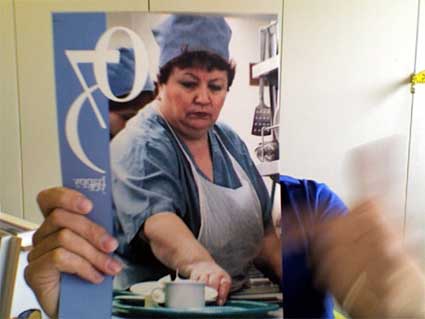
Course catalog
Antony Hall‘s projects explore the way we interface with technology, and how our interactions with it influence us creatively and socially. Often collaborating with scientists and technologists, Hall is currently focusing his talent on the investigation of biological and physical phenomenon. Some of his recent experiments involve communication with an electric fish, the creation of life through growing crystals electrically on volcanic stone, hunting for Moss bears and training Planarian worms.
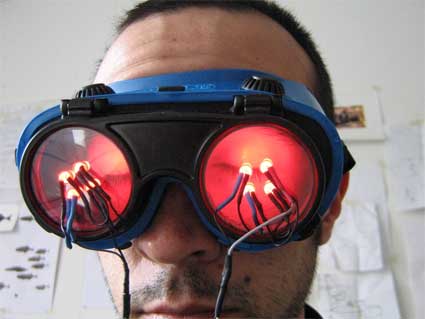
He gained fame in the media and media art festivals with his electro-acoustic sound art devices and performances. Together with Simon Blackmore and more recently Steve Symons, Hall is a founding member of the Owl Project, a group which combines woodwork with electronics to create performances, musical instruments (iLog , and Log1k) and other physical computing projects.
Let’s start with one of your most popular projects: the iLog. How did you get the idea of making it?
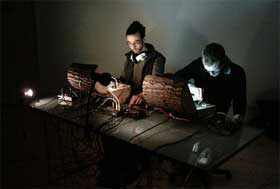 The iLog was created as collaborative project with Simon Blackmore and Steve Symons, we are the Owl Project. We developed the Log1K in 2001 as a performance tool to attempt rival the laptop in electronic music, shortly after this apple started pushing the iPod and we had to make a response, something which related more to the trend for portable, mobile hand held technologies. We wanted our devices to be a synthesis of craft and technology, as well as functional instruments. The Log1ks were getting increasingly heavy, among other things they used nearly 30 AA batteries, short circuits and fires, and blown-out speakers were becoming common place. iLog 01 came out in 2003. After we started collaborating with Steve Symons, we reinvented the electronics inside the iLog and started pushing the whole project to a new level; the M-Log is out later this year.
The iLog was created as collaborative project with Simon Blackmore and Steve Symons, we are the Owl Project. We developed the Log1K in 2001 as a performance tool to attempt rival the laptop in electronic music, shortly after this apple started pushing the iPod and we had to make a response, something which related more to the trend for portable, mobile hand held technologies. We wanted our devices to be a synthesis of craft and technology, as well as functional instruments. The Log1ks were getting increasingly heavy, among other things they used nearly 30 AA batteries, short circuits and fires, and blown-out speakers were becoming common place. iLog 01 came out in 2003. After we started collaborating with Steve Symons, we reinvented the electronics inside the iLog and started pushing the whole project to a new level; the M-Log is out later this year.

There’s now a series of iLog models. Why do you think people buy the iLog? Mainly as a beautiful and quirky piece of art which they would not use too much fearing that it might be damaged (although you provide technical support.)? Or have you found that people use it extensively as any other kind of musical device? Were you expecting your project to have so much success?
I suppose people want the iLog for its quirkiness, something as an alternative to the mass produced items. We had no idea that it would become so popular – people blogged it like mad at the start and like a Chinese whisper it suddenly became what people wanted it to be; typically some kind of alternative to the ipod – But in reality its something quite different. It is intended to be an instrument for performance.
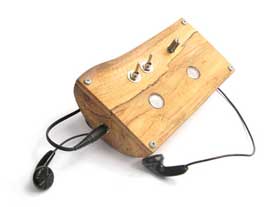
iLog signal
Our problem is that although there is demand; making them is still very difficult, and time consuming, so our focus is making them better rather than faster. At the moment we are looking at lending these to artists and working in collaboration to develop the iLog further. When we launched them for sale in London at DWB it was a real learning curve. Simple things like which way up it should be held, were completely un-obvious! We had to create extensive instructions regarding use, as well as repair and maintenance. The 24 hour support is most necessary! Its important that its more hands on than your average mass produced plastic device.
The iLog is something people can use, rather than living all its life in the art gallery. The new series, *M-Log, launching this year, looks like an iLog, and is a USB connective interface. So there is scope for programming your own sensor based instrument, which you can use with your own customized patch. The iLog is more of a stand alone sound generator. We are planning an event in Manchester during Futuresonic where other performers (including Leafcutter John) will be using the iLogs & M-Logs. *The M in M-Log stands for ‘muio’ as in “muio interface”, the chip based interface inside which Steve‘s invention in his words “The muio interface is a modular system for sensing and controlling the Real World”.
The wood is quite resilient and very repairable if damaged.
I love The Sound Lathe, a performance which explores the sonic properties of wood. Do you have any video of it?
There is some video here:
It does look like a very physical performance. Did you have to master new skills in order to be able to do these performances? How does each performance go? Are they all different from each other? Does working with wood creates situations and results you wouldn’t have expected?
Yes its been really interesting – my self and Simon ended up sleeping in a kind of bivouac deep in the forrest as part or the “R&D” for the project, learning the skills of traditional “green woodwork”, (electricity free) with Mike Abbott, master crafts-person. Mike invented a competition for Bodgers (the name for people who use the ‘pole Lathe’) called ‘Log to Leg’ (as in chair leg) so this is the new format for our performance – I think the record is 9 mins; transforming a bit of tree stump, into two perfect chair legs! It takes us a couple hours, but then our lathe is connected to copious amounts of sensor interface technologies. Quite a distraction, if like for our last performance at Lovebytes, it rained torrentially for the whole thing. In the documentation you will see a tarpaulin underneath that are 3 laptops and Simon.
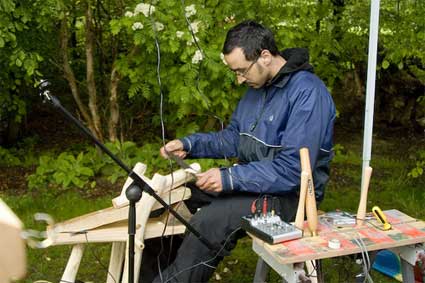
Image Lovebytes
I think for all of us it’s a welcome change from sitting behind a screen the whole time – these physical processes are a great compliment to programming and electronics; and they still require a similar kind of focus and discipline. It is quite exhausting, you need a lot a focus to keep the beat in time as well as make a good carving, in this way it becomes quite mediative. Sharpening the chisels and preparing the timber are all equally demanding skills to learn.
Can you tell us something about the wooden objects produced during the performances? Which kind of objects are there? And what do you do with them once the performance is over?
We have a box full of various objects; ranging in description from ‘chair leg’ to ‘fire wood’, or specialist ‘rolling pin’. Occasionally we have a look inside & discuss what we should do with them. We did make a chair with Mike about the only truly useful thing we ever made. The latest idea is to make some kind of flat pack, or player. Watch this space. You can see what we decide to do with them at The Piemonte Share Festival, 11 – 16 March 2008.
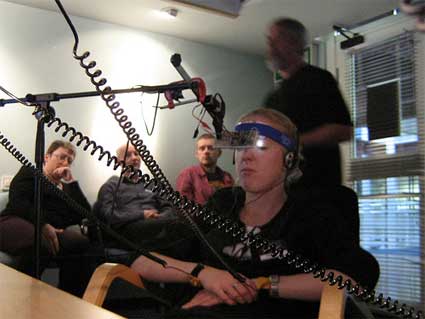
Documentation of first ENKI event at the Museum of Science and Industry Manchester, 7th October 2006
You are also interested in bio-digital medicine. That sounds very different from a project like iLog. Can you explain us what it is and how you started to be interested in this field?
Well this is my own personal project, although I have always working with biology or technological experimentation in some way; with ENKi I decide to humanize what I do. This was a decision to move into medicine and treatment technologies. Really its the same things that we work with in the owl project; looking at how technology is consumed and sold. The notion of bio-digital medicine is just one example in hundreds, of how science, or even the suggestion of science is used, and misused to sell ideas. Faceless corporations feed on our anxieties, our basic need to feel contentment or feel complete. I find it interesting that, just as some people turn to religion, others will look to technology or science to provide answers and solutions.

ENKI uses the bioelectric information from an Electric Fish to trigger human Brain-wave Entrainment. It generates sound and light pulses to induce a state of relaxation similar to the way traditional relaxation systems work, but the electric communication signal comes from an electric fish rather than a chip.
Did you test the system on other people? How do they react?
So far we have tested it on about 40 volunteers,most of them members of the public who had no prior knowledge of the project. We did this in the context of the Manchester Museum of Science and Industry; people enjoy the experience generally. I was surprised at the range of people who were up for it!
By this point I had started working with Greg Byatt as a collaborator. He has experience of using this kind of technology and administering similar treatments professionally. Greg has equipment which can monitor your physiological state and a brain-wave visualiser (EEG); we were trying to measure results this way. We only really came to one solid conclusion. We had to do more tests.
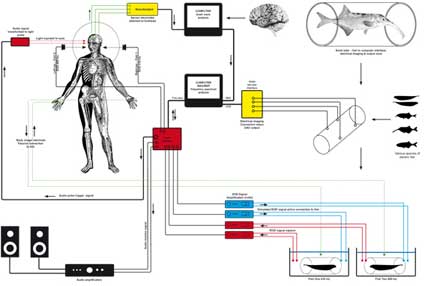
Isn’t the idea of putting one’s “brain-wave entertainment” into the fins of an animal scary? Do you feel that people would trust any other electronic device more than a fish or any other type of animal?
That is a good question. It’s an exciting notion this whole idea of “wet-wear” interfacing – but not something that should be taken lightly. I don’t like to be on my own if i am doing a test run, and yes I find it very unnerving. I never quite got used to the idea of connecting strangers up to electrodes and the fish. I also worry about the fish. The fish needs to be content and ‘happy’ for this to work.
In my opinion that most of these commercial devices are made by various humans all of whom have different intentions and issues, namely cost efficiency; and so effectively using quite crude means; cheap microchips. The Black Ghost knife fish is the result of millions of years of evolutionary refinement; but you could still say the same of micro chips.
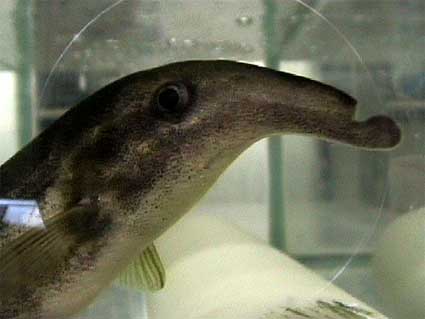
A Down poker
Is that project completely developed or is it still a work in progress?
It’s in progress. I started working with “electrogenic” fish in 2005; ENKI technology was the title I gave it in 2006 when I was in residence at ENSAD in Paris. This was the point I realized I could create a treatment technology that might actually be functional. I had a bit of pressure to actually finish something and so launched the basic concept of ENKI technology. The funny thing was that reflecting on it now – that just marked a new beginning. (It took a year just to convince the director of Pepiniere that it was in fact a real project and not some conjecture in science fiction!). Coming to think of it I have never really finished anything, I am much more excited by the notion of continued experimentation. I don’t want to finish discovering. The more I work on ENKI – the more things there are to do and try, it keeps opening up. There are always more questions.
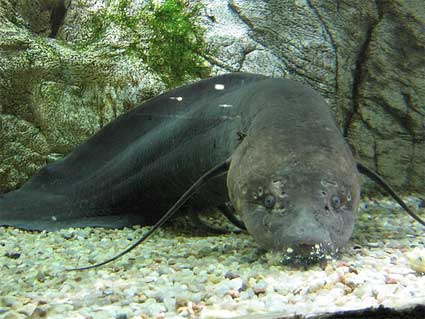
What is there left to achieve? And how much have you learned about cross-species communication?
There is still a lot to achieve. The ‘treatment’ side is just one layer of the onion. I started the project with the aim of communicating with the fish, generating an electrical signal and transmitting this in the fish in the tank, to the fish. Then I watch the the fish, looking for behavioral ‘interactions’ with the electrodes – generally if there is an electrical (connective) change to the electrodes, the fish is aware of this and investigates the electrode by swimming near it and around it (motor-probing responses). I also listening for a ‘chirp’ response. The ‘chirp’ response is a subtle modulation of the Electric signal, a specific fluctuation in the wave. The ‘chirp’ is used during like species interaction and communication. This is closer to the idea of language we have.
Experimentally there are factors which make this difficult to measure – The fish learns to associate the vibrations created by me entering the studio & opening the tank with a food reward. So any approach to the tank needs to be made silently, and the fish needs to be ‘conditioned’ to learn this over a long time. As the project progressed I became more interested in communication as something closer to an idea of commune. For the fish I see the communication signal they make more as a deep expression of self; a projected physical extension of the fish body, rather than ‘language’ in an anthropological sense. This communication is happening at a more primal level. In terms of the ENKi project I am thinking about this as a biological, or physiological connection between living organisms.
I recently discovered that I might be having a problem with what is known as ‘superstitious’ behavior in the fish; if I was a scientist in the academic sense, this would be a serous flaw in the project; something to fix, but for me it was a fantastic turn, giving the project a new angle all together. Its now becoming an experiment into animal Psychology, not just electro physiology. I don’t want to say too much about this next phase but next year the project will look quite different.
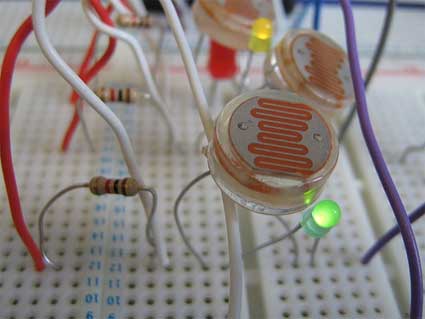
You recently developed the Opto-acoustic modulator and used it for an interactive work at FACT and Liverpool John Moores University for the National Science and Engineering Week. Can you give us more details about this interactive piece? How does it work? What were you trying to achieve with this project?
The commission was to create and interactive art work that used something other than keyborad or mouse. I was determined not to use a video camera either. The the Opto-acoustic modulator basically turns sound-waves into light-waves. It can take 10 audio channels and convert these into “AM” transmissions through 10 Light Emitting Diode arrays. I am fascinated by the notion of ‘Amplitude Modulation’ sending data using light waves. The idea was to use ‘Hyalite’ salt crystals, to broadcast sound through their ‘ionizing’ ambient glow. You interact with the light and can detect the data as sound using wearable sensors. Additionally, using Steve’s ‘muio’ interface again, 8 light sensors detect movement around the crystals using a lens and light sensor (based on the idea a simple biological ‘camera eye’) these feed into MAX MSP controlling a soundscape.
I read on your statement page that you are currently “working on new experiments relating to the creation of life through growing crystals electrically on volcanic stone, hunting for Moss bears (Tardigrades; Fresh water extremophiles) and training Planarian worms. ” Could you already tell us a few words about these experiments?
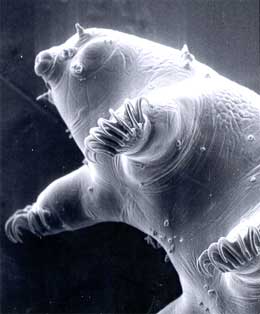
I have been researching the work of William Cross for quite a while, and finally decided that I needed to recreate his experiments (with a few modifications) It’s quite interesting trying to work out what he did – the only way to know is to recreate it. In 1837, he found these creatures “Acari electors” as he called them infesting an experiment, he believed that these things “spontaneously generated” within his experiment, several eminent scientists of the time recreated the experiment with the same results! My experiment is basically a recreation of this experiment, augmented with a little more technology – with the aim of capturing this phenomena of electrochemical abiogenesis. The only problem is the experiment has to run for many months.
I am interested in all sorts fresh water microscopic life; its a great 19h century tradition. With a decent microscope, you can take any roadside moss cluster and explore the interstitial oceans of liquids trapped between damp moss filaments. Here you might be lucky enough to find a Moss Bear ( “Tardigrade” ) an obscure form of extremophile that lives in moss. Believe it or not, it really does look like a bear! This in its self was a reason for laboring days over a microscope just to see if it was real! They don’t fit into the zoological classification system, and have been given a phylum of their own. It is believed it is able to survive space travel, and at this moment a small space capsule orbits the earth containing some “Tardinauts” (its hard to compete with that) I simply enjoy looking for them. I like to go looking for moss growing in all kinds of areas, from urban waste lands, to the Peak District. “Tardigrades” are able to survive about 120 years in a dehydrated state; I was sifting through very old moss samples from Manchester Museum to see if I could reanimate 100 year old dehydrated Moss Bears. apparently it is possible. I had a lot more luck looking for the living ones. Unfortunately my one Planarian worm recently went missing in the tank. It is 8mm long, and I dont have the heart to keep it in a petri dish. I am not sure where it is.
Is there any artist or researcher whose work has been particularly inspiring for you?
I don’t know where to start! Louis Bec for sure. I am really into what SymbioticA have been doing over the past few years, and what they are doing for the “Bio-art” movement. Otherwise, at the moment I am looking at the work of William Bebe. To be honest – I have been trying to read a lot more science fiction lately, particularly 19th century science fiction, and science writing. Often the science fiction tells you a lot about the popular understanding of science at the time. More importantly, its a good antidote ploughing through contemporary research papers.
Thanks Antony!
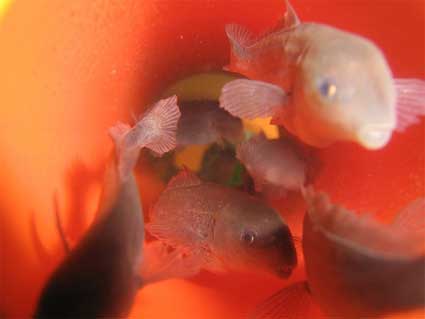
Related: El Niuton has a slideshow dedicated to the work of Simon Blackmore.
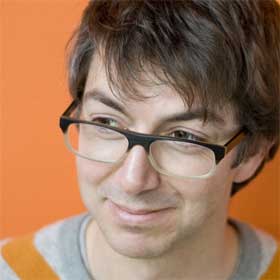
Photo by Magdalen Green
As i receive so many emails from young people who would like to graduate in media art, interaction design and other “cool stuff you write about on the blog”, i thought i should discuss more often with the teachers and researchers who run these courses in Europe, the US and in Asia. I’ve interviewed several of them before (Tom Igoe from itp in New York, Tony Dunne from RCA, Stephen Wilson from the San Francisco State University, Alejandro Tamayo from the Javiera University, etc.), today the victim of my curiosity is Graham Pullin.
Graham Pullin joined Interactive Media Design at Dundee after nine years as a senior interaction designer and studio head at IDEO where he most notably created together with Crispin Jones the Social Mobiles series. He has been involved in the design of mobile phones, hearing aids, furniture for children with disabilities and remote-controlled submarines. Previous to entering the design industry he gained an MDes from the Royal College of Art, this after a number of years as a medical engineer, having studied engineering at Oxford University.
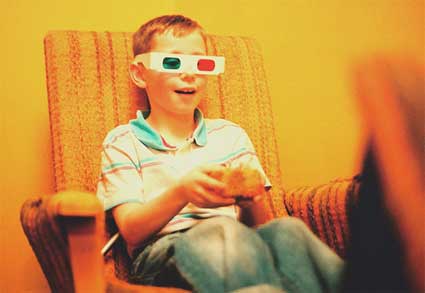
The Home Viewing Chair (Boston, 1956) by Dave Reid and Craig Mitchell
Dundee is a small city situated on the east coast of Scotland. I must confess that i had never heard of it until one or two years ago when the pieces developed by the students of Interactive Media Design (IMD) at Dundee University and shown at the Museum of Lost Interactions started to make a glorious tour of all the design and gadget blogs.
The BSc in Interactive Media Design brings together Computing modules, Design Studies modules and Interactive Media Design modules, in a range of hand-on projects that prepare students for a career in interaction design.
Your bio on the School of design website says that you are “passionate about work that blurs the boundaries between interaction design and industrial design”. Could you explain us what this involves? Any concrete example of this blurring of the boundaries?
Muji’s CD Player, designed by Naoto Fukasawa, has always been a favourite. The industrial design is the interaction design, suggesting a ventilation fan and inviting you to pull the cord, in the designer’s own words “Without Thought”… which is about so much more than ease of use – there is such a lightness of touch, such delight.
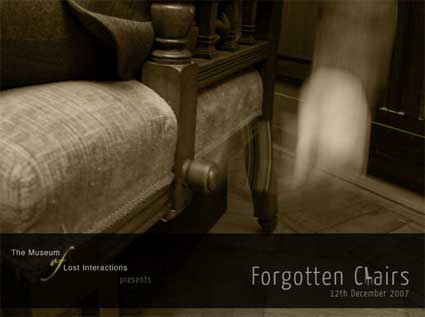
Forgotten Chairs, website designed by Jamie Shek and Ryan McLeod
Perhaps I feel more at home at these intersections – or in the gaps between – because of a twenty-five year journey from computer programming, via engineering and industrial design to (back to? I’m not sure) interaction design. I’m a little envious of my Interactive Media Design students for getting transgress these boundaries right from the start.
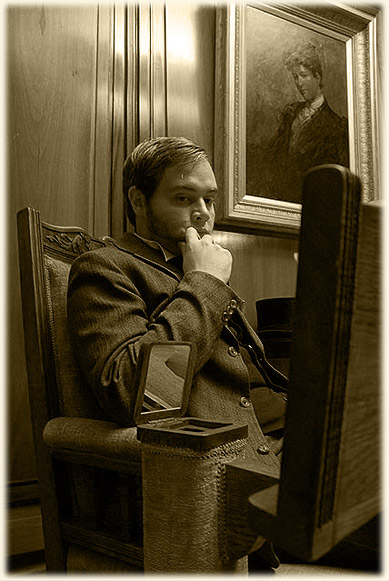
The Gentleman’s Chair (Edinburgh, 1898) by Ryan McLeod, Jamie Shek and Ian Shiels
For them, Forgotten Chairs is an introduction to designing interactions in the round rather than on screen. Recreating historical artefacts allowed them to find objects abandoned in charity shops and recycling yards, rather than build from scratch. Whether their exhibit is credible is a real test of whether they mastered the relationships between the three-dimensional and graphic design languages for their chosen period and the qualities of different media and technologies. The Gentleman’s Chair has a coherence and attention to detail that I hope Ian Shiels, Ryan McLeod and Jamie Shek will apply to everything they do next.
Why focus on “lost interactions”?
The theme of lost interactions connects young interaction designers to a heritage that is older and broader than the history of the personal computer. At the same time, it can provoke reflections on the pursuit of technical innovation for its own sake. PESTER by Euan McGhee and John Drummond is a 1970s mobile phone with built-in camera, music player and games.
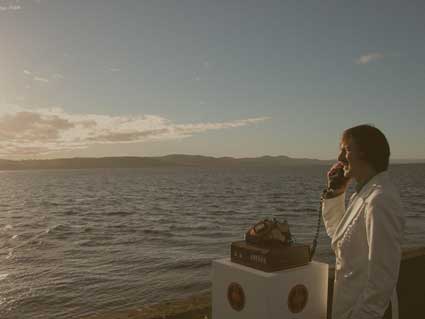
PESTER (1970) by John Drummond and Euan McGhee
Designing within a historical period can also help the students to be more conscious of the possible social impact of technology, issues easier to gloss over when looking optimistically into the future. The Case Communicator by Alison Thomson and Shaun McWhinnie promises liberating mobility to the modern businessman, but condemns his 1930s secretary to even longer working hours, tethered to her telephone exchange.
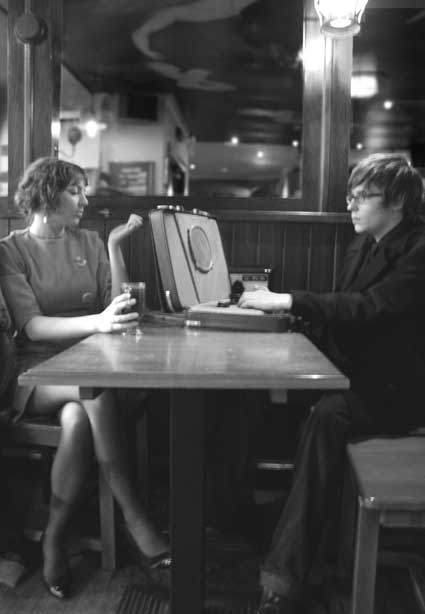
The Case Communicator (1936) by Shaun McWhinnie and Alison Thomson
… and do you feel that in general some kinds of interactions get lost over the years? Can an interaction became obsolete and how?
The radio dial is a loss: a magical interaction, a bit like safe-cracking (I’m told), to navigate a frequency band by half-second snatches of sound, occasionally stumbling across surprises. Instead, we now select a station name from a list – but isn’t this just because a little display has been added for the text streamed with Digital Audio Broadcasting and then adopted for the interface as well? If we browse images through thumbnails rather than filenames, why shouldn’t we continue to browse radio by its content?
Rather than lose this interaction, we could reinterpret it. True, there are inherent time delays in the way a digital radio tunes to a station and buffers sound, but this is a limitation of imagination more than technology – perhaps a secondary tuner might harvest recent content across all stations in the background? Making the technology work harder towards a richer, ultimately even simpler experience excites me more than adding features.
To be honest with you, i’m in a phase when i’ve seen so much interactive anything that i’ve started to be tempted to change room when someone invites me to “interact” with their screen/coat/clock/lamp, etc. I mean it is funny for a few minutes then my attention drifts away. Am i the problem in this scenario? Do you think that i need to see a doctor? What are the characteristics that makes an interactive work engaging and challenging beyond those first few minutes?
Can you make a double appointment for both of us? I am just reading The Poetic Museum by Julian Spalding which argues that the profundity and richness of original artefacts are being overlooked in the indiscriminate move to interactive exhibits. And MoLI certainly isn’t about where to draw this line…
But what it is, is a first opportunity for our students to jump in and learn that the success of an interaction depends on its realisation as much as its conception. And this is the reason it’s difficult to answer your question – you have to experience the experience for yourself to know if it’s working.
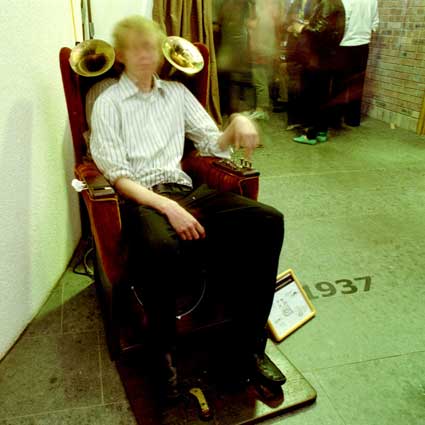
The Amazing Musical Chair (New York, 1937) by Graham Hancock and Raymo Holloway (photo: Chris Phillips)
The Amazing Musical Chair lets its occupant create a complex mix of 1930s instrumental sounds. This might have been a cacophony, but the whole exceeds the sum of the parts because Raymo Holloway and Graham Hancock crafted each loop and went to the trouble of recording musicians playing real instruments. Whereas the Barrow Rocker is just a mechanical music box that plays a note for each rock back and forth and owes its delight to Kirsty Woodend and Rebecca Rumble keeping it this simple.
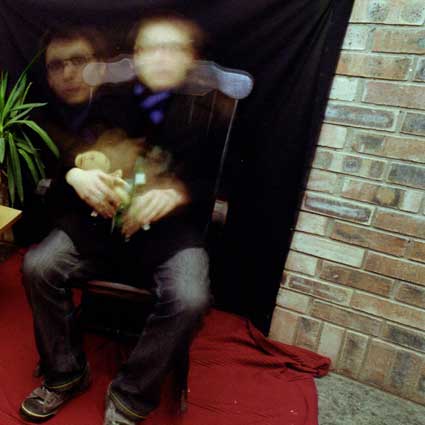
The Barrow Rocker (Dundee, c.1870) by Rebecca Rumble and Kirsty Woodend (photo: Chris Phillips)
There is a high focus on documenting the students projects using videos. Is it important to the whole creative process? Or is it just the icing on the cake for the video-hungry web visitors?
On the Forgotten Chairs website, video is used to tell the story of each exhibit and place it in context (there’s some nice archive footage) but also to convey the interactivity to those who couldn’t make it up to Dundee and experience the chairs for themselves. I think that’s something I got wrong on the original MoLI site – most web visitors didn’t realise that the models actually worked.
But in general, video is an important and versatile tool for our students – to sketch ideas, even as they are building them, and also to make documentaries and advertisements to disseminate their designs. And some may pursue careers in which video is their primary medium, whether as design ethnographers, researchers or artists.
I had a look at the Degree Show projects from 2006 and was quite intrigued by Andrew Cook – Tactophonics. Could you give us some details about it, how it works, what inspired the project and what in this project embodies the IMD department way of thinking and teaching?
Andrew Cook is also a computer musician (under the name of Samoyed) and his project was inspired by how unengaging performances of computer music can be – how difficult it is to understand what sounds are pre-stored and which are being manipulated or created live. The difficulty in setting up any kind of rapport between the audience and the performer is unrewarding for both.
Tactophonics was about making interaction with computer music more physical by letting a performer choose any object – for their own reasons – and turn it into an instrument. It worked by attaching a series of contact microphones to the object, not using these sounds directly, but shaping other sounds generated in MaxMSP. At his degree show, Andrew exhibited a tree branch that had been wired up: shaking the whole bough, bending the branches, scratching the bark, even snapping off the twigs, each produced different sounds. The relationships between action and sound was at once abstract and intuitive, engaging to play, and also a compelling spectacle for other visitors.
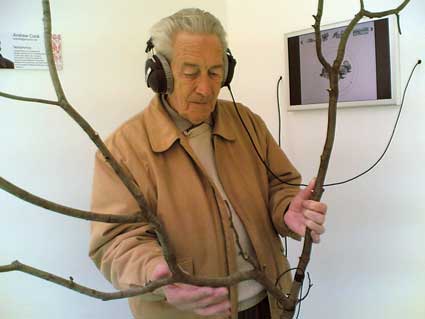
Tactophonics by Andrew Cook (photograph: Paul Gault)
I suppose this embodies our approach to thinking by making and playing. Andrew crafted a beautiful kit of parts and instructions, but this was just the starting point for each musician to create their own instrument and performances. It was about understanding this distinction, but also that design has a role within this creative whole.
By coincidence – well, not really coincidence – Cook is now working with me as a PhD student. We are trying to make synthetized speech more expressive – in particular for some people with impaired speech who use communication aids based on Text-To-Speech technology. Current devices offer little or no control of tone of voice, which can give a false impression that the person using them is also emotionally impaired. We are going to start off by building six speaking chairs.
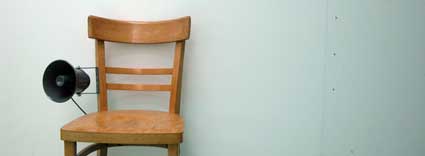
Six Speaking Chairs by Graham Pullin and Andrew Cook
This research is the real reason I left IDEO and came up to Dundee. My exploration of new interactions with speech started with Social Mobiles, a project that Crispin Jones and I led. The Speaking Mobile asked how much could be communicated with only the words “yes” and “no”, if their intonation could be controlled. Once bitten, I decided I had to devote more time to this intriguing and under-explored area.
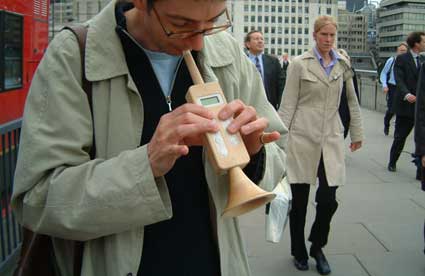
Social Mobiles by IDEO and Crispin Jones (photo: Maura Shea)
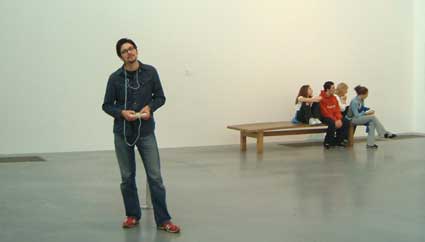
The Speaking Mobile (photo: Maura Shea)
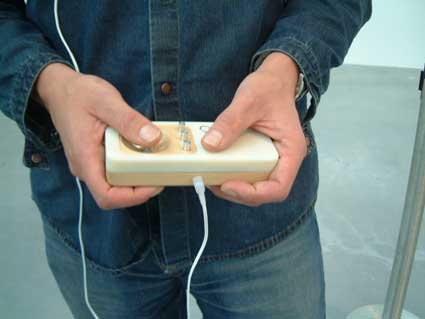
The Speaking Mobile (photo: Maura Shea)
Have you ever come across projects from interactive art which you found relevant and interesting for an interaction designer?
One of the most relevant and inspiring to my own work was Listening Post by Ben Rubin and Mark Hansen, an installation that sampled text from internet chat sites and played it back as hundreds of synthesised voices. Its aesthetic qualities came from these voices being deliberately monotonic and tuned to a scale. The whole effect was reminiscent of Gregorian Chant, eerie but quite beautiful. In a field dominated by the quest for so-called ‘natural’ speech, Listening Post is one of the few examples I have come across of synthetic speech being treated as a design medium.
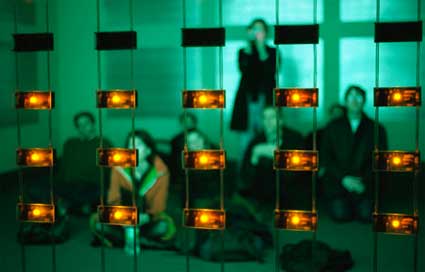
Listening Post, Brooklyn Academy of Music, Next Wave Festival, 2001
Could you name us one or more interactive media designer(s) whose work you find particularly inspiring?
Oh dear, I think I know how this is going to sound Régine, but please bear with me…
Wofgang von Kempelen, better known for the Mechanical Turk, built the first speech synthesiser in 1791 (here’s a sketch I made of it in the Deutsche Museum in München). Obviously, in those days, his Sprachmaschine was a mechanical analogue of the vocal organs and so speech sounds were derived from actions, not written language. But the design is also rather theatrical: the operator placed their hands through holes in a wooden box, so that no-one could see what they were doing, heightening the magic.
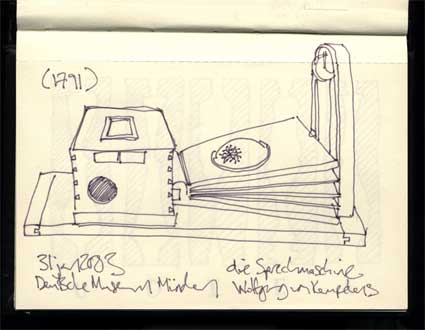
The Speaking Machine (1791) by Wolfgang von Kempelen
I realise this may sound nostalgic, especially following the Museum, but there is nothing nostalgic about the research that I am engaged with. I am quite serious about gaining inspiration from Kempelen and applying it to computerised Text-To-Speech. It’s the interaction that counts, not the technology.
The IMD website mentions that “Interactive media is one of the fastest growing sectors in the international economy”. I noticed when visiting design student shows that other departments, such as for example product design and industrial design, are getting more and more engaged in interactive projects. What is the specificity of IMD in Dundee?
I suppose I’m more interested in blurring again: interaction design and interactive media are part of so many sectors. In my 9 years at IDEO, leading projects and running a studio, that was increasingly the point: that interaction design had a role within a wide range of businesses and organisations, not just those focused on interactive media or interactive products.
Compared to product design courses, IMD is coming from the opposite direction, if you like. My current role is to introduce this shared territory to students who are already immersed in media and coding and narrative and interaction design – my colleagues Catriona Macaulay, Ali Napier, Shaleph O’Neill and Morna Simpson have backgrounds in design ethnography, sound recording, semiotics and content design.
On the other hand, we are a design course, which distinguishes us from a number of Computer Science or Human Computer Interaction courses that have rebranded themselves ‘interaction design’ or ‘interactive media design’. It is important that our studios are at the heart of an art college, sharing ideas as well as workshops with product design and textiles and illustration and fine art… as well as computing.
Why Dundee? Apart from IMD, what should make us put Dundee on a map?
It’s no coincidence that IMD is in Dundee, as it’s a collaboration between the School of Computing here and Duncan of Jordanstone College of Art and Design. The School of Computing has always focused on what it calls ‘applied computing’ rather than computer science and Duncan of Jordanstone has a great reputation in Scotland.
This year we are launching a Master’s course in design ethnography, aimed at students and professionals from human factors or design backgrounds. And there is lots of research going on across these traditional discipline boundaries.
http://www.computing.dundee.ac.uk/mde/
IMD has a sister course called IPD, which (a bit confusingly) stands for Innovative Product Design – where IMD is a blend of design and computing, IPD is a blend of design and engineering. IPD too has a strong point of view on “lighter and smarter” interactive products. Course director Polly Duplock has built a team with strong links with the RCA, Goldsmiths and industry, which now includes Jon Rogers, Andy Law and Pete Thomas. Second Year students on our two courses are currently working together on an invited brief for Microsoft’s 2008 Design Expo. We’re getting them to look at their relationships with their grandparents and consider where simple networked objects might play a role.
I will send a link for IPD next week – their new sit will be going live then
Any upcoming project, either personal or school related, that you could share with us?
I have just written a book, ‘Designing Braille for the sighted (and other meetings between disability and design)’ which is being published by The MIT Press and should be out in the autumn.
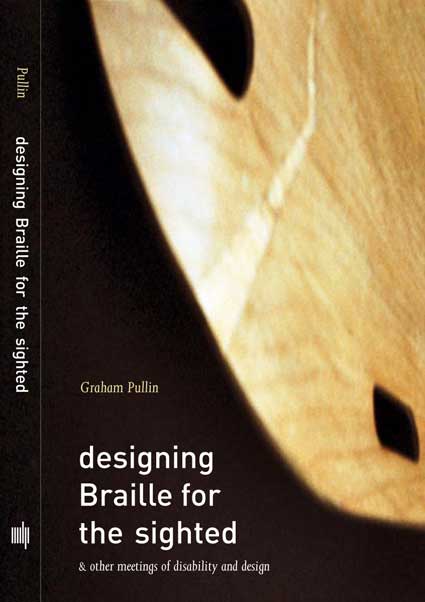
Designing Braille for the sighted to be published by The MIT Press
Twenty years ago, I spent three years as a medical engineer in a hospital designing products for disabled people. Then I went back to the Royal College and spent the next twelve years in design consultancy, designing all kinds of things for all kinds of people. The starting point is how distant these two cultures still are from each other – but how much each could inspire the other (sorry, it’s about boundaries blurring again…)
It starts with seven tensions between conflicting values and priorities. Is it more important for a wheelchair or a hearing aid or a prosthetic hand to be discreet or fashionable? Universal or simple? Sensitive or provocative? Is it more important to solve known problems or to explore new possibilities? Striking the right balance – and a different balance for different disabled people – requires the skills and sensibilities of both design cultures, not either one working alone.
It ends with conversations with some designers I like – including Tomoko Azumi, Vexed, Crispin Jones, Michael Marriott and Graphic Thought Facility. We discuss design briefs related to disability in some way – wheelchairs and wheelchair clothing, prosthetic legs, watches for visually impaired people and Braille. Their first trains of thought are diverse and inspiring.
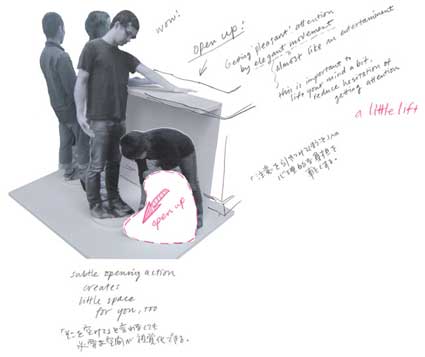
Sketching thoughts about step stools, by Tomoko Azumi
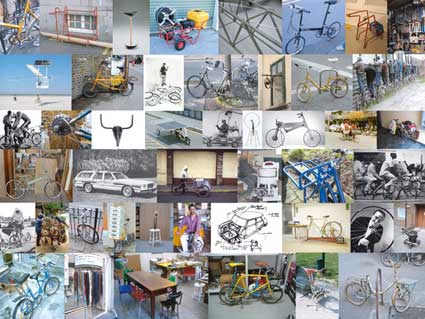
Collecting bicycles and chairs to inspire wheelchairs, by Michael Marriott

Sketching a Braille wall for visually impaired and sighted people, by Graphic Thought Facility
Despite the subject matter, this is anything but a textbook (there are several of these already!) It’s to be an affordable – and I hope beautiful – little book to carry in your pocket and read on a train journey.
…and some dates for your diary:
24 February – 12 May 2008: Social Mobiles exhibited as part of Design and the Elastic Mind, MoMA, New York
16 – 24 May 2008: IMD degree show at Duncan of Jordanstone College of Art and Design. This year’s IMD graduates were responsible for the first Museum of Lost Interactions
27 – 29 July 2008: Microsoft Design Expo 2008, that will feature the work of Dundee IMD and IPD students
Autumn 2008: The MIT Press due to publish ‘Designing Braille for the sighted’
December 2008: the opening of the next gallery of MoLI (sorry, the theme is a secret!)
Thanks Graham!
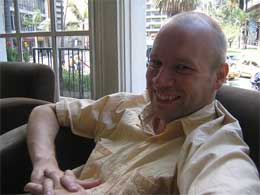 Meet one of the Godfathers of the Finnish media art mafia…
Meet one of the Godfathers of the Finnish media art mafia…
Juha Huuskonen is an artist, curator, VJ, software designer and he is also the organizer of the Pixelache electronic art festival.
Through a series of performances, exhibitions and club events, Pixelache brings together young creators from diverse disciplines who playfully and critically experiment with media and technology. The festival also features practical workshops and seminars addressing current issues in the development of digital media.
Pixelache is held each year in Helsinki has also traveled to other destinations including Medellin (Pixelazo), New York, Montreal, Paris (Mal Au Pixel) and Stockholm (PixelVÄRK).
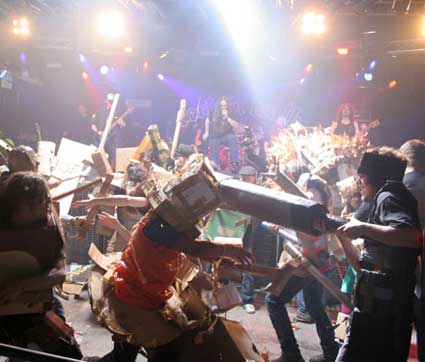
Pixelache 2008 Helsinki will feature the first edition of Baltic Boxwars: Northern League
Juha is currently busy preparing the 7th edition of the festival Pixelache University, Exploring the Crossroads of Art, Science, Technology and Urban Culture, held in Helsinki on March 13 to 16.
Pixelache University will focus on education and ask questions such as Does the educational system have room for hackers, circuit benders, environmental activists and VJ artists? What would be a suitable curriculum for nurturing independent grassroot initiatives?
Furthermore, Pixelache has opened its very own educational programme with a curriculum which consists of monthly Pixelache events (presentations, workshops, concerts and parties).
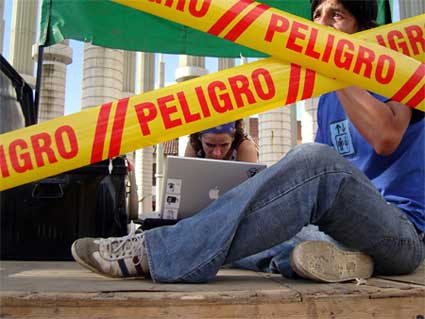
Pixelazo Bailable at Parque de las Luces. Photo Juha Huuskonen
I met Juha for the first time at Belsay Hall, in the North of England. He had commissioned 3 media artists to get some inspiration from the 17th century manor house and inhabit it with their art installations (review here and here again). Then we saw each other again in Colombia where Juha had invited me (hey! lucky me!) to participate to Pixelazo. I had him sit down in a bar for an interview. That was back in June.
Transcript of our Medellin conversation.
How could I define Juha Huuskonen?
When people ask what I do I tend to answer that I am a software engineer (because that is my official education) who is lucky enough to make a living as an artist but in fact I put most of my efforts into organising events and developing organisations.
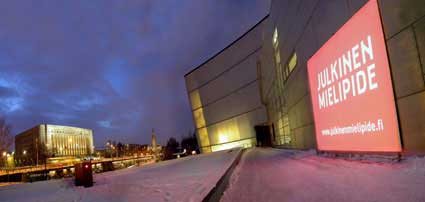
PLAN*B FOR ARKADIANMÄKI by Juha Huuskonen, Tuomo Tammenpää, Aura Seikkula & co (2005). Photo: Juha Huuskonen
How was Pixelache born?
The first Pixelache festival in 2002 was put together in an improvised manner, with a tiny budget of a couple of hudred euros. The purpose was to bring local active people together to discuss and present experimental work that fell between the categories – not art, not design, not research, but kind of all of these at the same time. This type of work is of course shown in all kinds of international festivals (today even more than a few years ago) but the other special thing about Pixelache has been that we’ve focused on showing work by young, emerging creators and taking risks by showing work that is still in the concept or prototyping stage. This is something that we are still trying to stick to, even though the festival has grown quite a bit and involves more established artists as well. Education – all kinds of seminars, workshops and presentations – has also been a very important part of Pixelache from the beginning.
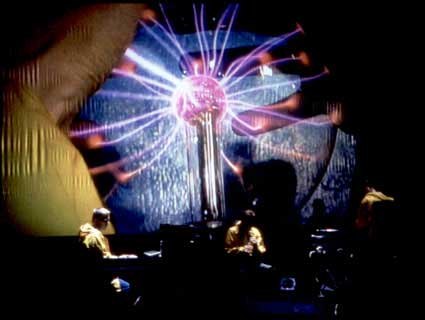
IMAchannel performance by katastro.fi, 1998 . Photo: Pirje Mykkänen
The longer history of Pixelache can be traced back to katastro.fi, a loosely organised media art collective that started in 1998. During its heydays, katastro.fi had around 50 members and worked on rather large scale projects, such as eko.katastro.fi and 2000.katastro.fi. The founders of katastro.fi were involved in demoscene, a subculture that evolved around software piracy and creative experimentation with early home computers (Commodore, Atari, etc). Katastro.fi brought together some of the most successful Finnish demo groups (Komplex, Orange, CNCD, Sonic, Virtual Dreams, etc) which had been active already since late 80s/early 90s. In the demo scene, people would get together in parties (events that nowadays can attract up to thousands of young people) and show the stuff they were working on. The way demoscene functioned as an informally organised, highly social network focused on developing new work and ideas has influenced my own practise a lot.
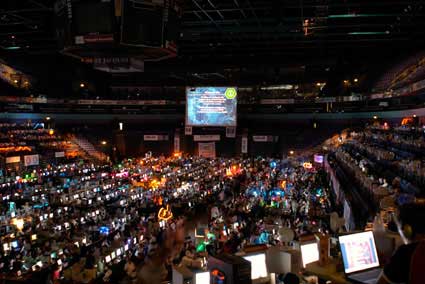
‘Assembly‘ demoscene event in Helsinki, Finland . Photo:Pekka Aakko
Where does the name Pixelache come from?
I found the word Pixelache sometime in 2001, in an article that was predicting new words that would be used in the future. The word was supposed to describe an “overdose of digital media.” I knew myself how that feels, for me the feeling of overdose comes from seeing too much of the same, how all media and technologies become standardized, closed, stiff and boring systems over time. I googled for the word “pixelache” and got zero results, so it was a word waiting to be grabbed. So, we first had a nice sounding name, the concept of the event evolved afterwards. Pixelache festival actually tries to act as an antidote for ‘pixelache’, presenting projects that challenge the standardizations.
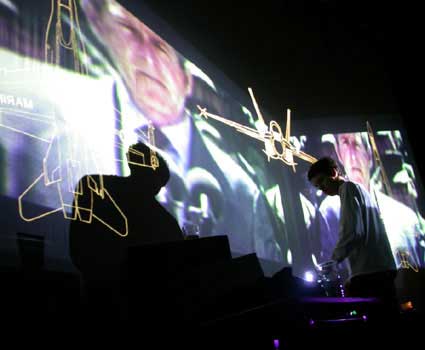
Light Surgeons at Pixelache 2003, Helsinki. Photo: Antti Ahonen
How did Pixelache end up spreading to other countries?
Our international events started in 2003, when we organised Pixelache festival in New York and Montreal. Both festivals were organised on a shoestring budget, with a lot of effort and enthusiasm from both organisers and artists. We carried most of the necessary gear and artworks as luggage, organised free/very cheap accommodation and traveled on a Greyhound bus between New York and Montreal.
The events in New York and Montreal brought together a quite unusual combination of local organisations that all had a lot of influence in planning the festival program. In addition to international guests, both events featured a lot of local artists, many of whom were later invited to Helsinki. We have maintained this way of working ever since. The model is sort of opposite to ISEA: instead of a separate international jury, the local organisations are in charge of the program, they never have to present projects that they don’t consider relevant for the local context. The program decisions are aided by an on-going discussion between various partners within the Pixelache network.
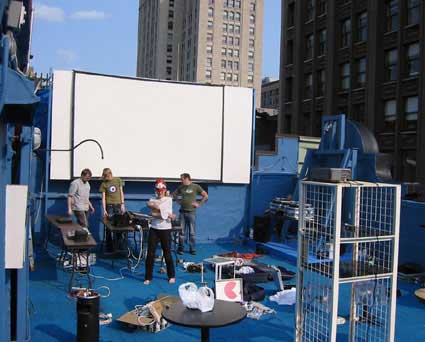
Pixelache NYC on top of Gershwin Hotel, 2003. Photo: Antti Ahonen
I think the reason why organisations want to work with Pixelache, or start their own Pixelache edition, is that Pixelache takes seriously the work done by emerging authors but does it without trying to be pompous. Another thing that makes Pixelache interesting is that we work at lot with international networks and subcultures, such as VJ scene, hacker and activist communities, etc. The current active nodes in the Pixelache network are Pixelache Helsinki, Mal au Pixel Paris, Pixelvärk Stockholm and Pixelazo Medellin. Pikslaverk is about to start in Reykjavik and we’ve been actively collaborating with piksel.no in Bergen, RIXC in Riga (Locative Media Workshop), Plektrum in Tallinn, Mediawala festival and Doors of Perception in New Delhi, Interferenze in San Martino Valle Caudina and several other events.
What’s the story of the creation of Pixelazo?
Pixelazo started with a random encounter – Vanessa Gocksch from Colombia contacted us in response to our open call for proposals, and eventually came over to Helsinki in spring 2005. Vanessa is running an organisation called Intermundos which works with marginalized communities in Colombia (for example kids from the ghettoes and indigenous Colombian tribes) and facilitates them to get involved in using media and technologies, focusing on free / cheap / DIY tools that are available to them. Vanessa and Intermundos have been a fantastic partner to work with, they are one of the rare organisations in Colombia who have the credibility to work with both grassroot organisations as well as established cultural institutions. It took two years to get to the first Pixelazo event, meanwhile we did some test runs by organising workshops with events like Salon Internacional del Autor Audiovisual in Barranquilla and Bogotrax in Bogota.
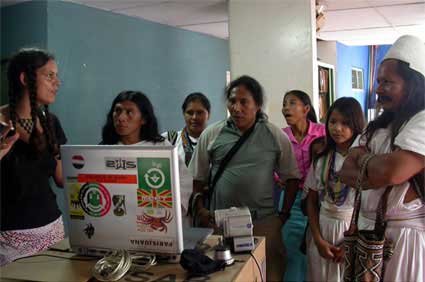
VJ workshop for Kogi & Arhuaco tribes, 2005. Photo: Juha Huuskonen
Pixelazo has been a great source for inspiration and ideas for future Pixelache events, Colombians are not so overwhelmed with gadgets and technology as we in the Western world are, but they can take the time to develop their own DIY solutions. Colombia is also immensely rich in culture, even though much of it is hiding in the slums or deep in the jungle, not easily reachable by random tourists. In this sense the bad reputation given to Colombia in the international media has actually been a blessing, the fact that there has not been much tourism has preserved a lot of the culture that would have otherwise been commercialized and/or destroyed already a long time ago. But this seems to be rapidly changing, more and more tourists are coming to Colombia and Uribe has made the country a lot safer, but unfortunately in a building-high-walls-around-gated-communities kind of way, copied from the United States.
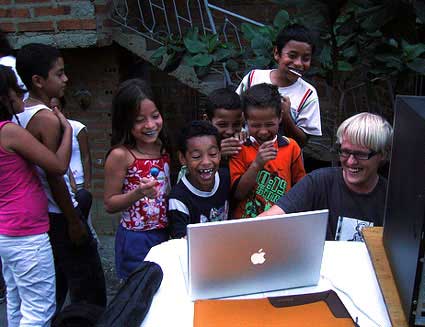
Pixelazo music & VJ workshops in barrio Santa Cruz la Rosa, Summer 2007. Photo: Juha Huuskonen
The future goal of Pixelazo & Pixelache is to bring more ideas and cultural influence from the South to North. For example at the first Pixelazo event we had some guest from the Nasa tribe, the way they see their life is that they are constanly weaving a web of people and knowledge, spreading it around the mountain range where they live in. This is documented in their traditional handcraft, weaved bags that contain information that looks like digital data. When they started using radio, they used radio cicleta, radio bicycles to act as mobile transmission units. This way radio technology can be made transparent, the transmission station is always moving inside within the network of the tribe, it does not become a hidden black box, a top-down authoritative tool like we have adopted it. They have now started using web and internet tools as well, all based on open source, it will be interesting to see how this develops.
![]()
Pixelazo music & VJ workshops in barrio Santa Cruz la Rosa, Summer 2007. Photo: Juha Huuskonen
What happens if I want to set up a Pixelache in another country? Is there a strict receipt to follow?
I guess step number one would be to get in touch with us, with Pixelache Helsinki or some of the other nodes in the network. Rest of the process has so far been informal, we’ve built collaborations slowly and by starting with smaller events. Right now there is a kind of pressure to make the process more formal and easier, so that more Pixelache events could be established since quite many people have contacted us about this during the past couple of years. We’ve been working on a Pixelache manifesto, a sort of ‘constitution’ for Pixelache events (not in EU style though :), something we can agree on and use a reference to develop the events in future. It’s still under work, but it will probably contain at least following statements:
Multidisciplinarity: it’s an event that brings together hackers, artists, architects, activists, but also people from the commercial new media / tech world.
We focus on working with emergening artists, rather than established ones.
We show prototypes, concepts, things in developments, projects which are not perfectly ready.
We try to bring together, support and try to understand how different sub-cultures can function, it’s not just art, it’s also hackers, community networks, VJs, etc.
There are also some themes that seem to appear in different ways in various Pixelache events: public space/locative media/borderline between physical and virtual space, do-it-yourself/hacking/missusing technologies, organisational strategies/collaboration/democracy, etc. VJ community and audiovisual performances have had a prominent role in all Pixelache events.
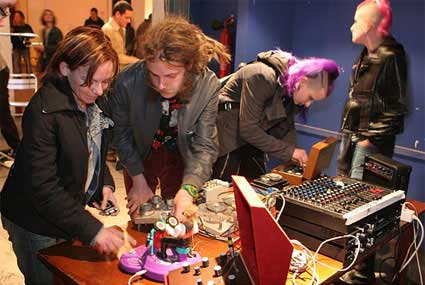
Association for Experimental Electronics, Mal au Pixel 2006, Paris. Photo: Antti Ahonen
Over the years we have developed working methods that makes it easier to organise this type of events, there are some of the tricks that new Pixelache festival nodes can adopt if they want. This has mostly been about treating the organiser team and the artists as one big team that can help the event to happen, by using e-mail lists, wikis, etc. For example one little innovation, asking the artists to put info about their travels online in a wiki themselves, took away a massive travel agency type of work from the organisers (there are often around 100 international artist/contributors arriving to Pixelache). The other great effort used to be the publication, but we have managed to cut down the work effort by using a simple design template and a wiki to put it together, we also make it in A4 size so that we can print it at a photocopy place on the last minute and later on anyone can download and print it at home as well. All these methods help us to remain an independent, grassroot initiative even though the festival has been growing in scale quite a bit.
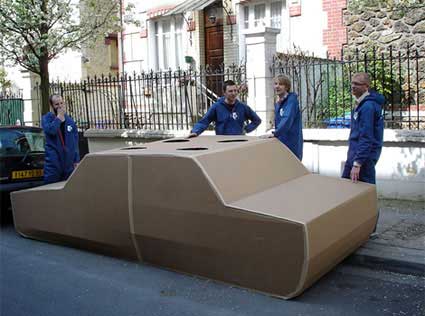
Orgsmobile at Mal au Pixel 2006, Paris. Photo: Johan Sandsjö
When you talk about Pixelazo you usually say *we made” ” we were invited”, etc. Who is behind that “we”?
‘We’ is most often the bunch of people involved in organising Pixelache Helsinki, there is a core crew of 5-10 people who have been involved for a longer time, and a larger group of people who get involved occasionally. The larger ‘we’ includes the international Pixelache network and our local collaborators.
But the question ‘who is we?’ is actually very important for us, after all these years we are still trying to figure out what it means to be an independent, grassroot organisation. This is something we’ve been exploring also in previous Pixelache festivals, with the ‘Dot Org Boom’ theme in 2005 & 2006 and ‘Architectures for Participation’ seminar in 2007. With the emergence of all the ‘Web 2.0’ tools and networks, the role of the diy / independent / experimental / alternative media and tech organisations in changing. The revolution of ‘citizen media’ eventually has happened, via myspace, youtube and facebook… But in quite a different way than ‘we’ were expecting.
When I interviewed you, we were both in Medellin, a few days after you left the city and flew to Leticia which to me (I’ve never been) looks a lot like the jungle. Can you gives an overview of the Leticia chapter? How did it go? If you look back at what happened there, do you think it might have any influence on the next Pixelazo?
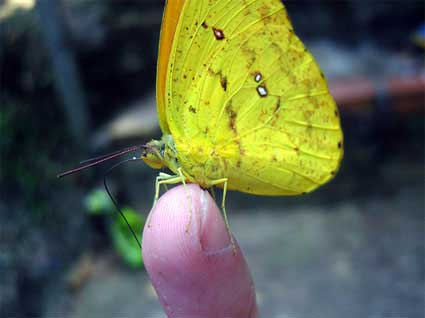
Pixelazo / Selvatorium 2007, Leticia, Amazonas, Colombia. Photo: Juha Huuskonen
The purpose of the visit to Leticia (a town in Amazonia, in the border area of Colombia, Brazil and Peru) was to prepare ‘Selvatorium’, an artist residency and other activities out in the nature, with indigenous tribes involved. Vanessa has been working with the indians for a longer time and has documented some of their practises at Intermundos website… So we don’t need to start from zero, but it’s still a great challenge to figure out the ‘right’ way to try to bridge the gap between North and South. I don’t think there is an easy solution available, with such a huge gap between the cultures. As I said before, I think we have a lot to learn from South, but we should also try to make a positive contribution to the local life, without imposing our own values and systems on them. Also it’s kind of ridiculous to work on projects dealing with nature, and to burn a great amount of kerosene when people fly over the Atlantic to get there. Hopefully someone will donate us a big sailing boat soon….
Thanks Juha!
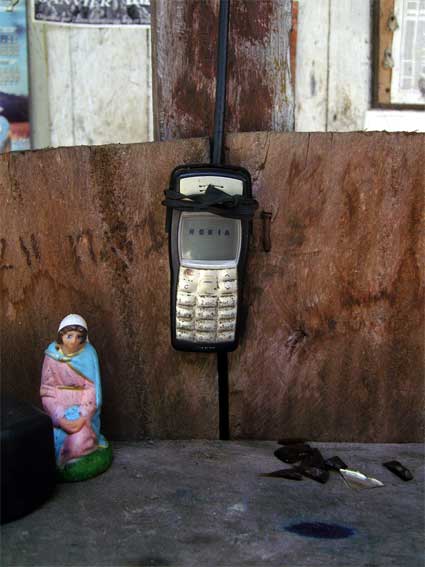
Pixelazo / Selvatorium 2007, Leticia, Amazonas, Colombia. Photo Juha Huuskonen
Next Pixelache appointments:
Pixelache Helsinki 2008: Pixelache University, 13-16 March 2008
Mal au Pixel 2008, Paris, 17-25 May 2008
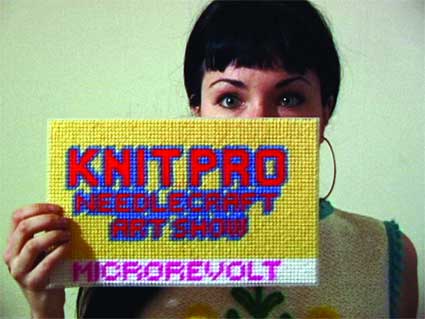
Artist and activist Cat Mazza is the founder of microRevolt. This collective of “craftivists” develops projects which combine knitting with machines, and digital social networks to investigate and initiate discussion about sweatshop labour.
A 2007 Media Arts Fellow in New Media (funded by the Rockefeller Foundation), Cat has exhibited her work and given workshops and lectures around the world. In 2005, she received a “Digital Communities” award at Ars Electronica for her project knitPro, an online tool that translates digital images into knit, crochet, needlepoint and cross-stitch patterns.
Her 2006 Turbulence Commission: Knitoscope Testimonies is the first web based video using “Knitoscope” software, an experimental program that translates digital video into a knitted animation. She is Assistant Professor of New Media as at UMass, Boston.
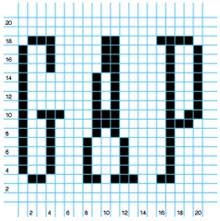
How and when did you start to be interested in anti-sweatshop issue?
In 2002 I moved to Maine after working for 3 years at Eyebeam (a New York based art and technology center), and was doing research in new media, women’s studies and globalization. That work led me to volunteer with a Bangor based organization called Peace through Inter-American Community Action (PICA). I met people active in the anti-sweatshop movement there, and that’s where it began for me.
Sweatshops scandals have received some press coverage over the past few years. And i suspect that you follow the issue more closely than most. Did you see the situation evolve for the better since you started to get interested in the issue?
I don’t know that labor exploitation in manufacturing global goods has changed in the last 6 years, but I do agree that there has been increased visibility of the crisis. This ultimately makes a difference. One thing I’ve witnessed grow in the United States (with some international allies) is a series of local groups networked into a coalition called Sweat Free Communities (SFC) who campaign for better trade and purchasing policies. There also have been some great films like Maquilapolis and China Blue that have helped raise awareness. And we should not underestimate the resurgence of craft and the subsequent alternative on-line micro-economies that have developed. So even if the working conditions have not improved, many consumer, activist, entrepreneurial and legislative change agents are finding ways to confront the problem.
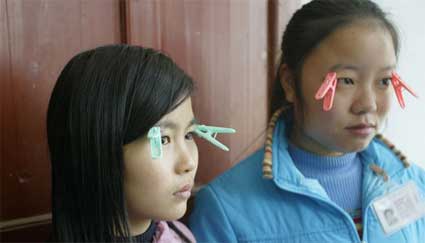
Image from the movie China Blue: To avoid getting fined for falling asleep, Jasmine (17) and Liping (14) use clothespins that keep their eyes open.
What is the value of micro-revolting? Of the small acts of resistance that your work encourages? How significant can they be?
The concept of “micro revolt” is loosely inspired by the idea of molecular revolutions*. What if social change was not simply a consequence of governing or economic policies; and small, disconnected resistant acts overlapped to nudge along change?
MicroRevolt in many ways began as an experiment more than a conviction. These web-based projects did achieve networking craft hobbyists in a form of labor activism, but the efficacy or value is hard to measure.If it’s “revolutionary” to favor drastic economic or social reform, knitting could be an interesting place to begin. I was just reading this book where Noam Chomsky was asked about the significance of policy reform “tinkering” and he said this can be preliminary to large-scale structural change.
Why not? What is the political potential of craft and can it be an avenue for pleasure as well as organizing for social good? You could ask the same question of art.
* This winter I hope to have a podcast of a chapter of a book by this title.
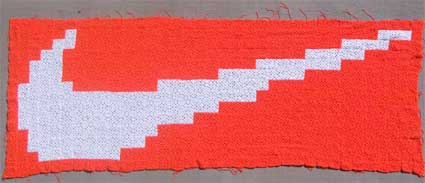
The Nike Blanket Petition project started in 2003. How did it evolve, grow and what impact did it have?
The Nike Blanket Petition started with learning how to crochet. I was interested in the tradition of pre-industrial crafts, tacit knowledge, learning to make stuff with my grandmother. I then met up with a local craft group and they agreed to help. Gradually more and more people participated. It was on the microRevolt website that attracts a lot of traffic because of knitPro, a useful pattern freeware, so people learned about the project there. It went to craft and electronic arts festivals nationally and sometimes internationally. The project has been going on for years, but it has been this slow trickle of signatures, like a 1950’s mail art project or something. People often send a single square and occasionally I’ll get multiples from a Women’s Center or a knitting circle from Portugal, and encouraging notes like “Good luck with the revolt!”.
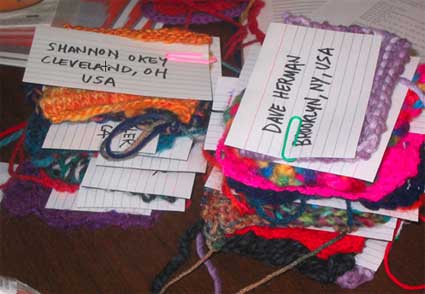
Hand-made petitions for Nike Blanket, 10.16.2004
People have participated from over 30 countries and every state and I’m still behind updating the data. It’s hard to measure the impact. My hope is that individuals who participated in the project have started a discussion in their circles and considered their own methods for activism.
Stitch for Senate invites knit hobbyists to craft helmet liners for every US Senator in an effort to encourage them to support the troops sent in Iraq by bringing them home. I first read about that project in March 2007. What is the outcome of SfS so far? Did you get any reaction from the Senators?
This is a very important year in the United States because of the presidential election, and 1/3 of the House of Senate seats will be campaigning as well. To get elected they will have to be bold about their position on our troops in Iraq, and the Stitch for Senate project is an attempt to engage people in discussion with their public officials about the war. There are some tenacious knitters out there willing to knit a helmet and make testimony. All of the participants support the troops; most of them are pro-peace (including some military moms). I’ve lived in New York State for 8 years and on the morning of 9/11 I was trying to walk over the Queensboro Bridge while the towers were in smoke… but I never supported this administration’s approach to this war, or my Senators (Hillary Clinton and Chuck Schumer) authorization of military force in Iraq. US Senators are required to respond to every letter they receive, and they’ll likely be glad to articulate their position. We are not mailing the helmets to the offices until we have 100 so we can send them all at once, with 100 people from all 50 states. I am hoping we can do this before the November election.
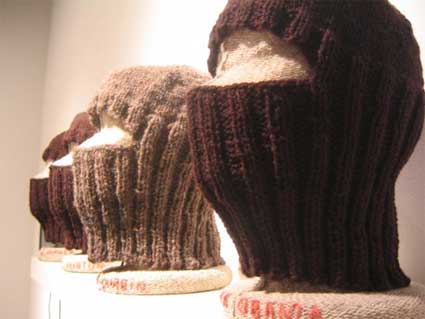
You participated to the Hackers and Haute Couture Heretics workshops in Istanbul last summer. Could you give us some details about what you’ve been developing over there?
Firstly, Istanbul is breathtaking. For me this was a really thrilling trip because the exhibit’s organizer Otto von Busch is so amazing. His writing is really interesting, and he is extremely skilled at designing. Most wonderful is his community based fashion projects like Dale Sko Hack and Merimetsan Alchemy – a fashion project in a mental health facility. I think you interviewed him about this. But also, he is a fashion theorist. What is that? You have to hear it in his words. I recommend his book Abstract Hacktivism. He had a very particular idea for this exhibit and I hope he writes about the outcome. The people he invited perhaps under the “craftivist” flag; all have very different practices and maybe even agendas. So that was interesting. It is unfortunate but I think that in some ways the intended project failed. We were supposed to collaborate with a Turkish high fashion brand called Vakko. Some of us were already skeptical and they ended up canceling after we each did an intensive design challenge. Instead, there were many fruitful workshops (Junky Styling, Counterfeit Crochet, Hacking Couture). What is special is just to have a public space where people can come in and learn and make, sew, knit, machine knit, etc.) Amazingly, this all took place in a gallery right next to a Nike Town store. The highlight for me was after four years, with a lot of help from Otto and the attendees; hundreds of the post-mailed squares were stitched into the border of Nike blanket. So it’s nearly finished. I also met beautiful Iranian sisters who took me on a ferry around the Bhosphorus.

Testimonies: Alex Tom, Chinese Progressive Association, San Francisco and Yannick Etienne, Batay Ouvriye, Haiti
What are you working on currently? Is there any upcoming public event in the microRevolt agenda?
From now until August my main focus is a new artwork – Knitoscope Sampler. I may have to put microRevolt reBlog to sleep for a little while and shift my web presence from labor to war because of the election and Stitch for Senate. Also on January 26, 3-5:00pm, “Crafting Protest” – Panel Discussion and Craft Reception at The New School, Theresa Lang Community and Student Center, 55 West 13th Street, 2nd floor, New York City, NY. Moderator: Julia Bryan-Wilson, art historian and critic. Panel includes artists: Liz Collins, Sabrina Gschwandtner, Cat Mazza, Allison Smith. February 20-23 in Dallas, Texas I’ll be participating in two events Social Fabrics and Gestures of Resistance as part of the CAA conference. Stitch for Senate helmets and video exhibits at the Museum of World Culture in Göteborg, Sweden opening January 17.
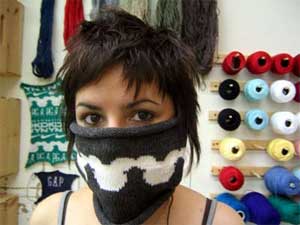 Now something more personal. I’ve always been fascinated by knitPro, , a program that translates digital images into knit, needlepoint, x-stitch and crochet patterns. However, i can’t knit and even if i could, the only moments when i picture myself knitting would be while i’m bored in the plane or at the airport. But they would probably confiscate my needles there.
Now something more personal. I’ve always been fascinated by knitPro, , a program that translates digital images into knit, needlepoint, x-stitch and crochet patterns. However, i can’t knit and even if i could, the only moments when i picture myself knitting would be while i’m bored in the plane or at the airport. But they would probably confiscate my needles there.
Is there any service that would allow me to send a pattern to someone and get the shirt back nice and ready to be worn?
Not that I know of, but this could be a highly successful business. What about going to your local yarn store and asking? People that go and work at yarn stores are usually totally pro and up for commissions.
Or is there any place where one could buy one of those leg warmers featured on your blog or the little face mask. I have one and people keep asking me where they can buy one.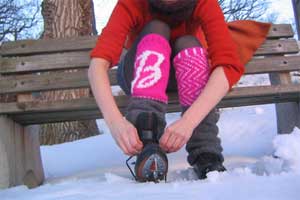
So far I haven’t been into selling the knitwear that I make. The logoknit series was made to bring attention to the branding of corporate monopolies that were sweatshop offenders and also to show what is possible with knitPro. I made two Mickey Face Masks that I donated to Turbulence.org. I was really glad you got it because the other one didn’t sell and I felt bad because it was a fundraiser. The Barbie Legwarmers I sold to Natalie Jeremijenko‘s daughter for her art collection. But that’s it. I’d rather organize uploaded knitPro patterns into a searchable database than make and sell knitwear. Plus this is an election year; must focus.
Is it totally silly of me to assume that most craftivists are women? Or is it more gender-balanced than i’d assume? Do you come to expect that most of the people who will engage with your project will be women? How much do you think that it matters as far as your own work is concerned?
Craftivism is a new term I think coined by Betsy Greer, of craftivism.com. I am not sure I understand what and if craftivism is yet, but it’s not gender specific. See: (menwhoknit.com). As far as my work is concerned, I have worked with mostly women but many men too. I just got the first balaclava from a male knitter from Federal Way, Washington who stitched for Senator Maria Cantwell and it’s wonderful because it’s his first knitting project with round needles. Also, I met my boyfriend because he needlepointed a series of pillows of Communist Heroes from South America.
So if one can’t (or just won’t) knit which kind of small acts of resistance do you recommend to people who want to protest against workshop labour?
1) Investigate your local Campaigns and see how you can help
USA: SweatFree.
Intl: Clean Clothes.
2) Vote with your dollar (Support sweat free labels, fair trade, worker owned co-ops, etc.)
3) Be sure to know about where your public officials stand on trade, petition and vote
Thanks Cat!
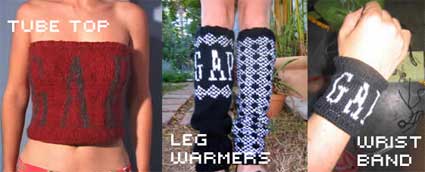
Logoknitting, a tactic that uses knitPro to knit logos of well known sweatshop offenders as a way to raise a discussion on how advertising, labor, production and consumption relate
Forays is a low profile (that’s their words) artist group strung somewhere between New York and Montreal whose work focuses on the research and creation of open-source minor architectures and low-tech modifications of everyday life.
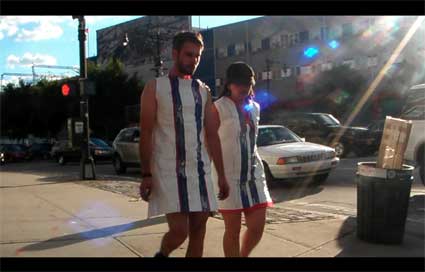
Forays is Adam Bobette and Geraldine Juárez.
Geraldine Juarez is a self-taught designer and an artist from Mexico City based in Brooklyn, New York where she is a Senior Fellow at Eyebeam and play around the city with Forays. She is a drop out of Communication and Graphic Design of a university in Mexico City and worked in advertising for several years doing visual effects in Mexico City, New York and Los Angeles. Her current interests are low-tech crafts and artifacts. Most of the time she obtains her supplies in trash bags, by freecycling or by hacking public sites.
Adam Bobbette is a writer, researcher and artist based in Montréal.
What started as an innocent conversation between Geraldine and i about the Postal Gown she was modeling around Williamsburg during the Conflux festival escalated into a fully-fledged interview about her, and mostly the works she’s currently working on together with Adam. Here we go:
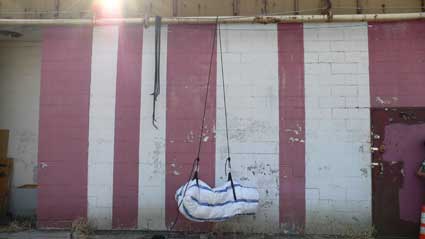
Postal Cocoon
Hey Geraldine, you write that you find your supplies in trash bags, freecycling or by hacking public sites. Sounds interesting but we’d like to get more details. How does one hack a public site? can you give us examples too? And what is freecycling?
G:. I read once that hacking is the creative adaptation to immediate circumstances. I switched not so long ago from purely digital work to more analog and tangible object production and I had to learn electronics from scratch, a bit of code and a whole lot about materials. I started hacking the city accidentally. I was working a lot with paper and electronics and I needed something that I couldn’t afford. Looking online for alternatives I found it freely available in the public infrastructure of the city: the postal office. Not paying for my source material was a complete delight and I pushed it forward. Picking stuff from the street in New York is nothing new, everybody does it. There is a royal amount of quality waste all around the city. However there is an easier and more social way to get specific things that you need. Freecyle is a simple yahoo list that let’s you ask and offer things for reuse. Most of the time the craft materials are just surplus so you get perfectly good stuff for free. Often I found just what I needed and it was an opening to start wandering around the city to get what I need and most important, interacting with the moneyless layer of New York City.
Together with Adam Bobbette, you work on the Forays projects. How did you get to meet and work together? Does each of you have his or her own skills and knowledge that complete the other?
AB. Like yin and yang? Like milk and tea? Like diamonds and roughness?
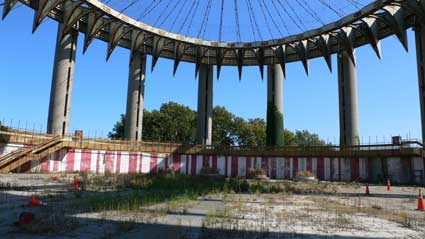
G:. it’s actually not like that at all, we don’t really like each other. We met in Eyebeam. I knew he wanted to work with steam and I thought that was wicked but he was too cocky so I didn’t want to talk to him. One day I stole a little kaleidoscope from his desk. I confessed to it and then we found out that we both were into folding stuff, trash and useless things. He is a luddite and I’m more geeky. He speaks French and I speak Spanish, so it helps to create confusion.
AB. We always have experiences to share about crossing the American border, which is a strong bond.
G. Also, we really work hard to keep it low and that’s really encouraging. Adam has trouble with authority while i have it with sustainability and environmentalism. He likes space and i like materials. We both find waste inspiring. We like the idea of creating pieces that make you realize your space and environment in a more beautiful and accidental way. Since we come from different worlds we are constantly questioning what it really means to step into these arenas like activism, art, architecture. We are also really afraid of how art goes, and we don’t know how to slip in and come out clean. And yeah we don’t like each other.
AB. Which makes for this great productive confusion. Collaborative work is mostly frustrating.
G. And there are others we work with too, wonderful, distant others.
AB. And some of them like you, Jerry.
G. Sure.
AB. We do a lot of our own stuff and sometimes just fall into each other’s projects mid-way, towards the end or drop out from the beginning. But it’s definitely important that we are surprised by what we work on individually. Or, it’s great to be surprised by how differences end up overlapping.
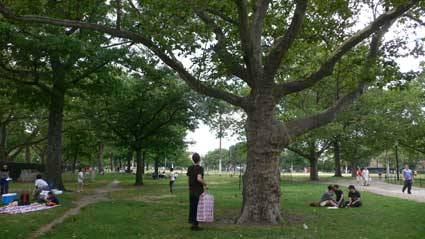
Beach Mat Cocoon
One of your pieces Field Notes addresses the ways in which the delineation of interior and exterior or private and public space can be used towards political ends. Using cocoons, you and Adam propose open source architecture and hacked materials as forms of grassroots activism. Can you give us more details on that? Which materials you use? And how the cocoon can be turned into OS architecture?
A— G: The basic nature of the cocoon is to turn the structures and infrastructures of the city into a vehicle for experimentation. It might need space, it might need a certain material, it might need a certain action to hang it. When a cocoon needed certain materials, it made us go and find it around, explore sites and slip into and through cracks to get it. This gives us the chance to hack infrastructures. When the cocoon needs to be used you have to look for space: a scaffold, a tree, a fire escape, which enables reclaiming some lost space. Also, the cocoon is meant to be a tool for tactical occupation, like in the case of More Gardens —
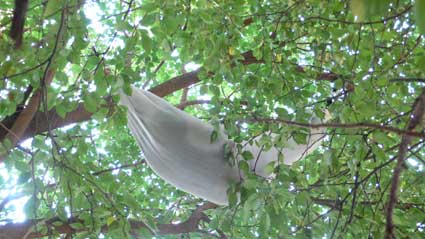
AB. A kick ass New York City community garden advocacy group that saves community gardens from being destroyed by the city
G. — Either for tree sitting or for creating a temporary squat, when you slip into a cocoon you slip into a tool riddled with the potential of continually evolving.
AB. With the cocoons we weren’t really so interested in focusing on the objects but on the whole network, the whole approach that building and thieving, freecycling, skill sharing and trespassing gets you into. I mean, we personally really cared about the objects but that was not what we wanted to show to the public. That stuff is personal. What we do care about is pointing in a direction; towards techniques of trespass, of building, of acquiring materials. It was important to provide entry points into the very material circumstances and consequences of art making.
The kind of materials we were using were things like construction netting hacked from construction sites. To get them you climb up inside scaffolding and cut out some chunks. We also used modified Tyvek postal envelopes grabbed for free from post offices around New York. And, 1 dollar beach mats. These are the main materials, but there is tones of other stuff, mostly culled from construction sites, hardware shops, outdoors shops and the street.
Open source architecture refers to the way that we hoped to distribute a process of building, not instructions on how to build a particular thing. We had to break codes and hack systems to build the cocoons and what we are interested in distributing are the techniques we used. We don’t think any body would be really all that interested in reproducing the objects we produced, but the techniques could help people build their own stuff or at least take an adventurous approach to buildings. We are just hoping to pass on a very basic program for experimental architecture.
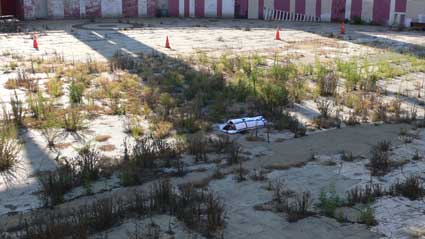
Postal Cocoon
What does one of these cocoons look like exactly? Can you sleep in it?
A— AB. People have said they look like many things. Some people think they look like body bags, which I kind of like. Some people think they look like jewels, some say they are just hammocks, some don’t really know what to make of them.
Yes, you can sleep in them. We have and will continue to. There is this whole experiential side, as you can imagine, to sleeping in trees and hanging up against scaffolding, strapped to some edifice under construction like you were, well, a little larvae grafted to structures. Which you are already, with or without some cocoon.
G. They are really a simple hammock. However the material and the way in which they are built, make them what you want them or need them to be.
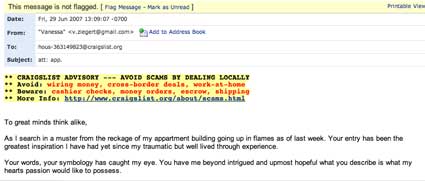
And how about the Craigslist chapter of the project? How did it go and did it encounter the kind of response you were hoping to get?
A— G. Well, Adam got all those emails. Actually the Craiglist chapter are the origin of the cocoon. He was trying to advertise free space for people to occupy as well as describing this kind of poetics of squatting. Squatting not only as a political strategy but also a creative architectural endeavour.
AB. Craigslist is a funny place. It was really a way for us to talk to an audience that would otherwise have little relation to this kind of work (though maybe we’re making bogus assumptions). And, yeah we had great responses ranging from sincere interest to total confusion to pick-up lines.

I like the “swing actions†a lot. How did the public react to the swings? Do you know if the idea has spread around?
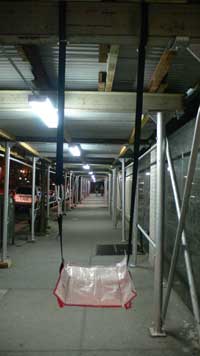 A— AB. It’s pretty hard not to love swings even when they are set in places they shouldn’t be; they are pretty benign objects. Everybody loved them, from construction workers who would tell us we ‘gotta patent that shit’, to passersby, and of course, kids. But this is why they can be a decent introduction or gateway to more intense experiences of disruption, or of bending and twisting space.
A— AB. It’s pretty hard not to love swings even when they are set in places they shouldn’t be; they are pretty benign objects. Everybody loved them, from construction workers who would tell us we ‘gotta patent that shit’, to passersby, and of course, kids. But this is why they can be a decent introduction or gateway to more intense experiences of disruption, or of bending and twisting space.
G. I was just the trooper. I had to wait in line to use the freaking swing. The pictures I took are beautiful though.
Did you ever get into trouble for installing swings and portable squats?
A—G. Not a real problem. Some building porters that double as mini-cops…
AB: So many people in New York city are mini cops…
G. Some have come to us to ask what the hell we are doing, but often people give us a break to finish or even let us keep going. You would be surprised by how many public servants are tamed by the word “art”. It’s really the best antidote or word you can use to dissolve confusion and tension. We just published recently ‘How to Unload bags and Practice Failure’, a description of getting busted and the function of the “artistâ€. Why don’t you read it. It’s my favorite project.
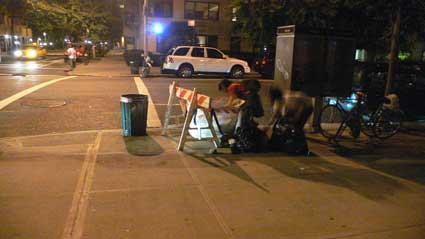
I want to know more about 100% Local Irradiated Food. And that TV set that you turned into an Edible Excess Machine. What was the impetus for that project? How does the EXM work?
A— G. Oh! The EXM doesn’t work.
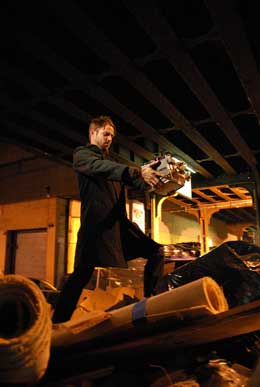 AB. It is a symbolic machine. We have been inspired by freeganism for quite some time and wanted to build a machine that spoke to the very interesting contradictions of freeganism, the same contradictions that underlie so much of our own work. I was excited about the machine because of the way that it spoke to all of these interesting problems of the excess/consumption, host/parasite relationship.
AB. It is a symbolic machine. We have been inspired by freeganism for quite some time and wanted to build a machine that spoke to the very interesting contradictions of freeganism, the same contradictions that underlie so much of our own work. I was excited about the machine because of the way that it spoke to all of these interesting problems of the excess/consumption, host/parasite relationship.
Basically, parasitic activity requires the very consumer society it deplores in order for it to survive. Freegans would be impossible without the excess generated by consumer society. Their activism, their scavenging, which is a totally justified protest against this consumption at the same time depends on it. So, in their own ideal world they would not exist. In a way they are fighting for their own disappearance as a group. That’s interesting.
What the machine is supposed to do is allow you to turn absolutely anything (garbage, bricks, old tires) into edible waste by irradiating it and swallowing a laxative. A perfect circle. A perfect impossibility. If it were true, at a certain point, you would end up turning your own self into edible waste.
We built it as a workshop at Eyebeam. Jerry and some excellent workshop folks built a commercial around the EXM. We hope to eventually get a feature in Martha Stewart’s magazine.
G. I have a crush on garbage bags so I really wanted to do something directly with them. The idea came up actually because someone told us that you can actually create x-rays out of a tv.
So the project is meant to raise attention to the enormous amount of waste we produce everyday, right?
G. We are trying to make clear the fact that while everybody goes green, local and organic our waste will remain there. It’s about excessive consumption. If everyone is really really interested in being sustainable, how about eating your own waste? THE EXM is as retarded as green capitalism.
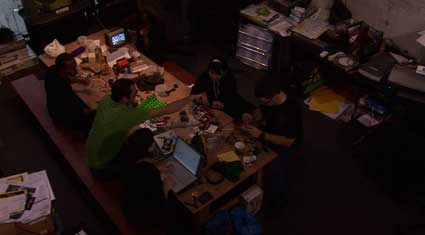
There’s a strange little device on your website. It’s called Bucky and seems to implode. Can you tell us something about it?
A— AB. This is Jerry’s killer project and she thinks more clearly about it than I but we do share this distrust of Mr. Bucky Fuller. He is still someone that we have to contend with, maybe one of the most important idols that we have yet to destroy. He is really this figure head of all of this naïve technological optimism that threatens to murder anything that was once dangerous and/or interesting about sustainability.
AB: Isn’t it just the same as the present except that people will feel guiltless about their consumption, about their excesses? You know, I feel like sustainability even has enough room in it’s future for things like solar powered tanning salons and ways to power your television set by the energy emitted by burning your own calories. And all sorts of other “neat†stuff.
JG. For me, a sustainable future based on consuming “with the earth in mind” is the ultimate social disaster. I prefer to stop preparing for the upcoming natural disasters and start acting on the social disaster around me, like consumer capitalism.
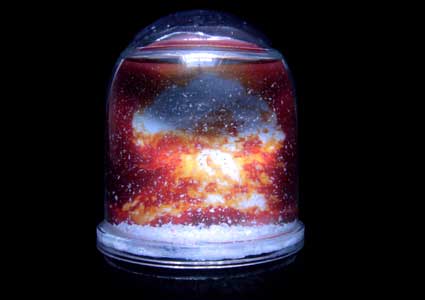
The Bucky’s are based on Fuller‘s Geoscope: This globe that allows you to see the big picture and help humanity somehow to “anticipate and cope with inexorable events”. Bucky I is a forest made of money that explodes. Pure illusion. My Bucky is meant to mimic the actual fragility of ‘Space Ship Earth’. Green or not. I really want to destroy this illusion of “saving” the world going “green”. I don’t think we are going to “save” it. But i do believe we have to go more dark in order to learn how to live on it from now on.

During the last edition of Conflux, I saw you walking around with your friends wearing some pretty Postal Gowns. How can I make one? Can you give us a little step-by-step?
A—AB. Regine, haven’t you heard how damn stubborn Jerry is with instructions these days? She avoids them like she had a nut allergy or something.
JG. Uff. Don’t even get my started. What’s with this obsession for systematization? Yeah i don’t like instructions, but actually some people really dig instruction sets and they even think they allow you to show how instructions for anything always rely on some impossibility and the unthinkability of chance.
p.s.
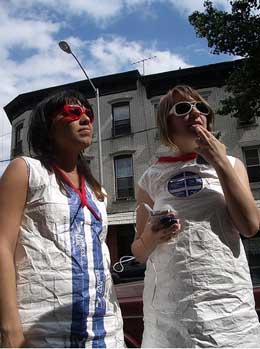 Well my allergy to instructions is that i don’t think there is a possible way to break down into steps things that are not technical, and maybe i really want to move over the technical. I like to share information yes, but i think we have to subvert the way we share it some how too. Instructablism is getting a little boring to me. To make a Postal Gown first you need to get some material for free by any means. And this can be as broad as you want. Hacking, thieving, freecycling. You have to make an effort to avoid money exchange. You have to learn how to step into strangers homes (it’s really weird sometimes as well as interesting), receive something and take responsability of it.
Well my allergy to instructions is that i don’t think there is a possible way to break down into steps things that are not technical, and maybe i really want to move over the technical. I like to share information yes, but i think we have to subvert the way we share it some how too. Instructablism is getting a little boring to me. To make a Postal Gown first you need to get some material for free by any means. And this can be as broad as you want. Hacking, thieving, freecycling. You have to make an effort to avoid money exchange. You have to learn how to step into strangers homes (it’s really weird sometimes as well as interesting), receive something and take responsability of it.
Once you got your material:
(You need a pattern and a sewing machine)
1. Cut your pattern
2. Sew both parts together,
Thanks Geraldine and Adam!
All images courtesy of the artists.
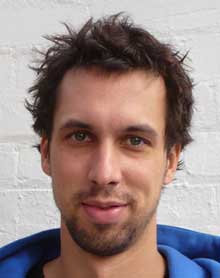 It might come as a surprise but i actually do not like design. I don’t care about lemon juicers, that new phone all my ifriends want me to itry, “interactive and playful” lamps, lamps on top of a horse, chairs that change colours and sing, tables that “communicate with your remote partner”, lamps that you can punch, lamps that juice lemon (though i quite like the chairs that do the same job), etc. Still, every year i grumble but go to the Salone del Mobile in Milan and other furniture gigs. It’s because i do know that some designers can amaze me better than many techno-art geniuses. Eelko Moorer is one of them. Quite often my admiration for a creator seems to dwindle over time because of the way they repeat themselves or because my own interests shift. Didn’t happen with Eelko’s work. I discovered his Stilts a few years ago, i remember that they left me so dumb i even forgot to take a picture of them, then i fell in love with the rubber bearskin, i’m still laughing at the Emergency Games: A Manual For Extreme Experiences In The Danger Of Your Own Home and that was just the beginning.
It might come as a surprise but i actually do not like design. I don’t care about lemon juicers, that new phone all my ifriends want me to itry, “interactive and playful” lamps, lamps on top of a horse, chairs that change colours and sing, tables that “communicate with your remote partner”, lamps that you can punch, lamps that juice lemon (though i quite like the chairs that do the same job), etc. Still, every year i grumble but go to the Salone del Mobile in Milan and other furniture gigs. It’s because i do know that some designers can amaze me better than many techno-art geniuses. Eelko Moorer is one of them. Quite often my admiration for a creator seems to dwindle over time because of the way they repeat themselves or because my own interests shift. Didn’t happen with Eelko’s work. I discovered his Stilts a few years ago, i remember that they left me so dumb i even forgot to take a picture of them, then i fell in love with the rubber bearskin, i’m still laughing at the Emergency Games: A Manual For Extreme Experiences In The Danger Of Your Own Home and that was just the beginning.
Eelko Moorer studied at Utrecht School of the Arts (The Netherlands) 3D design and shoemaking before setting up his own studio and developing products for fashion, performances and works on the borderline between art and design. In 2003, the year he was nominated for the Rotterdam Design Prize, he enrolled at the Royal College of Art in London where he received his MA in Design Products in 2005 exploring new territories and contexts for his work. Based in London, he now works on a freelance basis for companies, individual customers and on self-initiated projects.
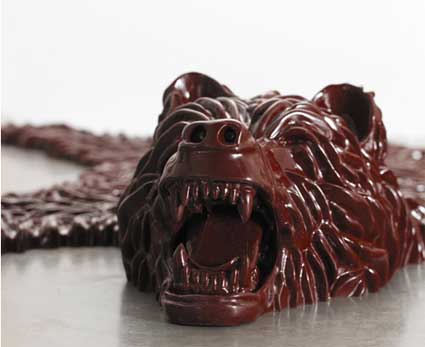
I have never asked this question to anyone so far because it is kind of cheesy but i cannot help it this time. Where do you find your inspiration? How do you get all those ideas?
Do you envision a particular type of user before or when you design a new piece or do you just go ahead, follow your inspiration and see what happens later?
Design for me is a vehicle for exploring larger social and cultural ideas that I am interested in. The start of most projects therefore is from a personal motivation and interest and themes always seem to revolve around nature-culture, body-desire, interior-exterior (society). I move from the personal to the generic. I mix everyday myths and facts for which I find inspiration in literature, film, material culture studies, newspaper articles, etc. From these elements I construct users that are fictional.
I am interested in what psychological effects contemporary life has on the individual and what possibilities for design there are in this area to design new sensations for the desensitized. tired of feeling and seeing.
I find that today’s designed environment has too much of the same conventional products, focusing on comfortability and the practical, that are the result of a too much systemized and industrialized society. On the contrary I believe in the value of difference, co-existence and the eccentric.
In the production process I explore the personal and the expressive in relation to the anonymous and the mechanized and through playing with form and meaning and through association I communicate ideas as well as through their function. The ideas and proposals are often critical and ironic at the same time.
Next to this I also work a lot from material experiments that I do. I believe that materials and techniques speak to you and technology is never neutral, that machines have politics behind them. Reflecting on form and meaning I analyze these material experiments and so see what they tell me in that context and how they relate to themes I’m interested in.
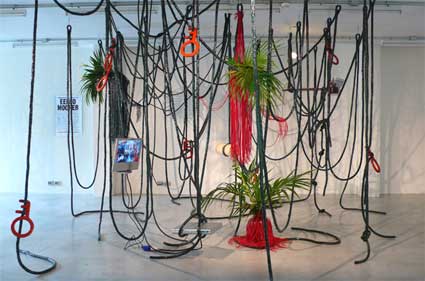
At the Salone del Mobile in Milan you exhibited In The Jungle Groove, a site specific installation made of swings, vines and suspended objects. Can you explain us what you were trying to achieve with this work? How do you imagine that people could use it?
Milan is all about the aesthetics of interior objects and not really about concepts of living, so I decided to present an alternative living space, a new experience, with new behaviors and new and unique designs.
I found that today’s home has too much of the same conventional products, focusing on comfortability and the practical. The contemporary home has become a passive and merely consumptive transient non-place filled with electronics.
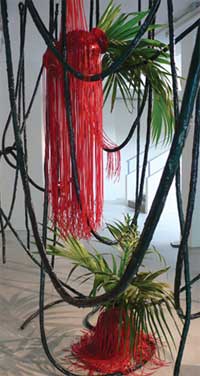 I wanted to design a living environment that was more about the emotive and physical and that would explore the values of discomfort, danger and especially play. The Jungle proposes a new interior space, literally and metaphorically. The Jungle is a hide out, a retreat from the outside world, a place to escape inward, a redesigning of the home as a place to reclaim the self.
I wanted to design a living environment that was more about the emotive and physical and that would explore the values of discomfort, danger and especially play. The Jungle proposes a new interior space, literally and metaphorically. The Jungle is a hide out, a retreat from the outside world, a place to escape inward, a redesigning of the home as a place to reclaim the self.
In its form I was exploring the cultural meaning of the jungle as image and as a theme in relation to modernity as it emerges in popular culture with its connotations to the internal of the mind, the exploration of the unknown and as a the projection of man’s fears and desires.
I wanted to specifically use ‘environmental storytelling’, like it is also used in amusement parks like Walt Disney’s, or theme hotels as Las Vegas’ ‘The Mirage’ for example. This story element is infused into the design of the physical space and so gives meaning to the user’s experience.
Using associations to pre-existing stories already known to users through books, film, television, comics and other media allows the user to enter physically into a space they may have visited before in their fantasies. And so to evoke and make concrete memories and imaginings through which they can wander and with which they can interact.
Such a pre-existing story provides structure to the experience but is therefore in danger of limiting the imagination of the user by definition. It is, 1, by designing only an atmosphere and not fill the story in too much that there’s still enough room left for the user’s mind to wander and imagine themselves Tarzan, Jane, Liane The Jungle Goddess, King Kong, Kurtz from Conrad’s Heart Of Darkness’, etc.
And, 2, on top of that by entering this immersive and associative narrative environment the user can play via swinging on the vines and arrange and re-arrange by knotting the vines and objects in the space to his own liking. This provides space for game play and interaction. Room to play, to hide, and to perform. Within the given structure they can D.I.Y. their own plots and so experience the characteristics of interactive play such as freedom, power and self-expression.
People can use elements of it in their homes. I can also see it used in a hotel environment for example.
What I wanted to present in Milan is an idea, an atmosphere, a theme that I could continue working in. Right now I am designing more things for the jungle that are more product oriented and that can be sold.

Is the Jungle related in any way to Emergency Games?
Both the Jungle and the Emergency Games deal with exploring ‘play states’ (deep play, role play, etc) with the aim of designing a more creative and physical interaction with the home environment. While the Emergency Games sets out a direction and is a bit darker, the Jungle is a first attempt to materialize the idea in a lighter way.
You seem to be fascinated by rubber. Why this interest for the material?
Rubber is child- and toy-like. It transforms objects into a toy-like plastic reality. Into some sort of projected mental space where desires and fears are concretized and fictions and myths begin taking shape.
There’s desirability to it whilst at the same time being quite cheap looking and pulp, a bit subversive. It looks hard but is in fact relatively soft. There’s an element of ‘bad taste’ to it that I like.
Besides that there’s something magical for me about casting. Releasing an object from the mould and then having ‘a double’ or many ‘doubles’ that are exactly the same, and they way their meanings and relations to each other change, is something that keeps on captivating me.
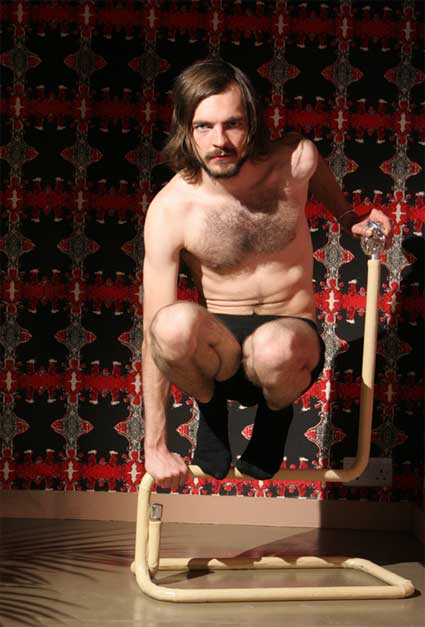
Perch, 2005
What motivated our work Bird People? What were you exploring with that project?
I was exploring what psychological and therapeutic function designed objects can fulfill as props for living and the new typologies that could derive from this.
The story was about somebody that feels completely absorbed in his mechanized routines of everyday life, cannot relate to society anymore and because of this he feels dislocated and depressed. He feels unreal and wants to experience his physicality again, to release his desires, to let his animalistic side out again. He wants to set himself free, to become a bird literally.
Results were a perch chair: A new typology of a chair that asks for balance and concentration and the user takes a position that is protective and completely introverted.
The Balcony seat lets you experience a feeling of taking off, a feeling of falling over. It puts you in a contemplative state deriving from the existentialist notion that you can only experience life’s meaning in the face of death.
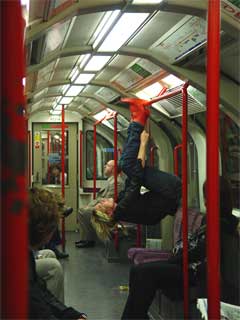
On the right, Tube Shoes, 2005
The Bat shoes enables to act out, to reclaim the public space for desire through play. Here the user is experiencing himself, but he also becomes a performer because by doing a surreal intervention, he transforms a mundane daily routine of traveling on the tube and produces some sort of myth.
And how did it end up in the Evening Standard and other mainstream media?
It was presented on the TV-set that hung in the jungle, a small part of the jungle installation in Milan. Somebody of the Evening Standard newspaper wanted to feature it. When they did, the Press Association put it on their website and it started rolling from there: ITV’s six ‘o clock news ran it too that day and it kind of escalated a little bit after that ending up on BBC’s Breakfast Show on TV, BBC radio and Irish national radio, various other pulpy newspapers and a lot of blogs all over the world.
You recently explained me that the objects that you design are not mere commodities but some desirable pieces? Can you explain what you mean by that?
I was more talking about that commodities have the characteristic of being as smooth, anonymous, impersonal as possible. The personal is then added via an atmosphere created through advertisement. I am interested in designing objects and products that would combine the personal and the associative with the anonymous and mechanized in its actual physical appearance. So the object or product would completely become an image and the image the object/ product. So the entire object/ product’s content and meaning are projected out onto its skin. There’s nothing behind its surface and so the object/ product quite literally becomes completely superficial.
The bearskin for example is maybe the most extreme example of this. It is an object that is completely useless in comfort and not practical. Yet at the same time extremely desirable via its associations. The object is a play with form and meaning, change of context, transformation and scale and the references and associations that come out of this.
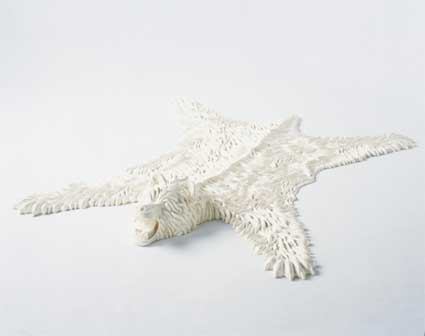
The rug refers to a lost exotic romantic world of hunting and intimacy that has been replaced and subverted by a toy-like plastic reality. It deals with the human desire for some ‘otherness’, but at the same time can also be understood as reference to a larger cultural and critical context (hunting trophy – man over nature, a nod to animal rights…).
The original model has been executed by hand in clay. From this a silicone mould has been made.
The materiality of the object plays with attraction through an almost carnal sensuality due to the handcrafted surface and at the same time a rejection of softness and presence of immateriality through the use of rubber and the objectʼs reproducibility. This play with attraction and rejection creates a fetishistic desirability, an erotic anesthesia.
How did you get to design Footwear for Rui Leonardes?
I know Rui from RoXY, a former nightclub in Amsterdam, where we both were hanging out a lot in the early to mid 90’s. We didn’t see each other for years until we met at the RCA-bar in 2003 where we both just started studying. He studying Footwear and myself Design Products. We’ve kept in contact ever since and he then asked me to do some shoes at some point. We share a similar kind of attitude so it combined well together.
Why do some of the shoes you design look so uncomfortable?
Well, the stilts for example look uncomfortable because they are. The idea was not to make wearable footwear necessarily, but more footwear that could function as a therapeutic prosthetic object with a psychological function for the user. It lets the user experience his own body making him conscious of the flesh through strapping on the stilts in a bondage kind of way and via balancing on the tips of the heels.
Oh! Btw, is there any place where I could buy a pair of “Wellies�
I’m afraid the company went bust a short while ago.

I usually think of you as both an artist and a designer. Are you comfortable with my blurring of your “label�
I always look for the ambiguous, the in-between spaces, the borderlands, or twilight zones, both in work and in life because these areas provide me with a feeling of freedom, inspiration and this is where identity and difference are negotiated. I see these territories as places where new perspectives and thoughts are being born.
Besides that, a lot of the work that I do balances between the descriptive of the arts, but contains the process, the context and the prescriptive elements of design.
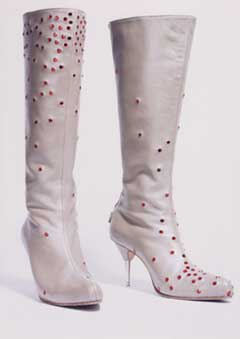
On the left: Wonderland, 2001, in collaboration with Zjef van Bezouw
Where do you think that you “fit�
I see myself as a multidisciplinary designer. A designer because I use design methods and design research and that’s the context I function in. And multidisciplinary since I am moving on and mixing the boundaries of design, fashion and art, because I think different ideas and stories function best in different contexts. In general I guess you could describe my work as couture in a way if you like: conceptual and theatrical atmospheres and experiences that are often handmade and function as one-offs, or small series, exhibited and sold in galleries.
Let us put aside design for a moment. Which artists do you find most inspiring and why?
At the moment I would say:
I love Franz Kafka. Especially ‘The Trial’ and ‘The Castle’. How he transforms everyday reality and actions in surreal and absurd adventures. The way he psychologically drags you into his twisting and turning so you are totally confused yourself and so lets you feel the absurdity of systems and constructed realities. Also I love his ‘Observations’, who are beautifully sharp and short.
Antonioni’s L’Eclisse for how he portrays the feeling of loss of human intimacy and natural context of the protagonists by putting them against a man-made landscape of technological progress and modernist architecture. Together with a slowing down in time this makes the actors seem disjointed and lost between all that materiality. He makes alienation and estrangement feel so tangible and look so beautiful in that film.
J.G. Ballard’s novels in which his protagonists are conditioned and where they take action via some sort of release exposing an underbelly of a seemingly perfect social model. Although his earlier writings are a bit too SF for me, the later works deal with the psychological effects of technological, social or environmental developments and are more subversive and surreal in a subtle way.
Books like Cocaine Nights, Crash, Super-Cannes show visions of a nearer dystopian future that’s very well possible, or might even already be here. And in doing so, like all SciFi, showing a portrait of tomorrow, but actually talking about today.
Henry Miller because reading his books give me a feeling of being centered in what life really is about: experiencing total freedom regardless, the energy and joy of life, faith in chance, things like that.
Mike Nelson’s fictional narrative environments because they are so incredibly immersive and imaginative. Sometimes it feels the spaces are alive and spirited. I like the way he connects literal and highly detailed familiar looking spaces with abstract ones and leaves detailed traces that are humorous, slightly subversive, surreal, etc.
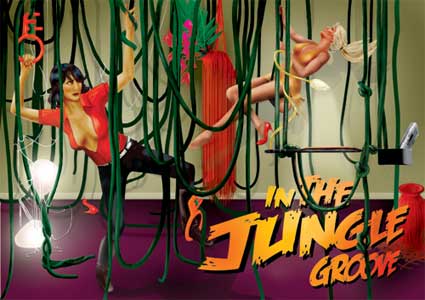
The artists that make the drawings for the covers of those pulp magazines and the anonymous designers/ makers that have made the objects that can be found on carboot sales and flee markets.
Thanks Eelko!